

SPRINKLERAGE
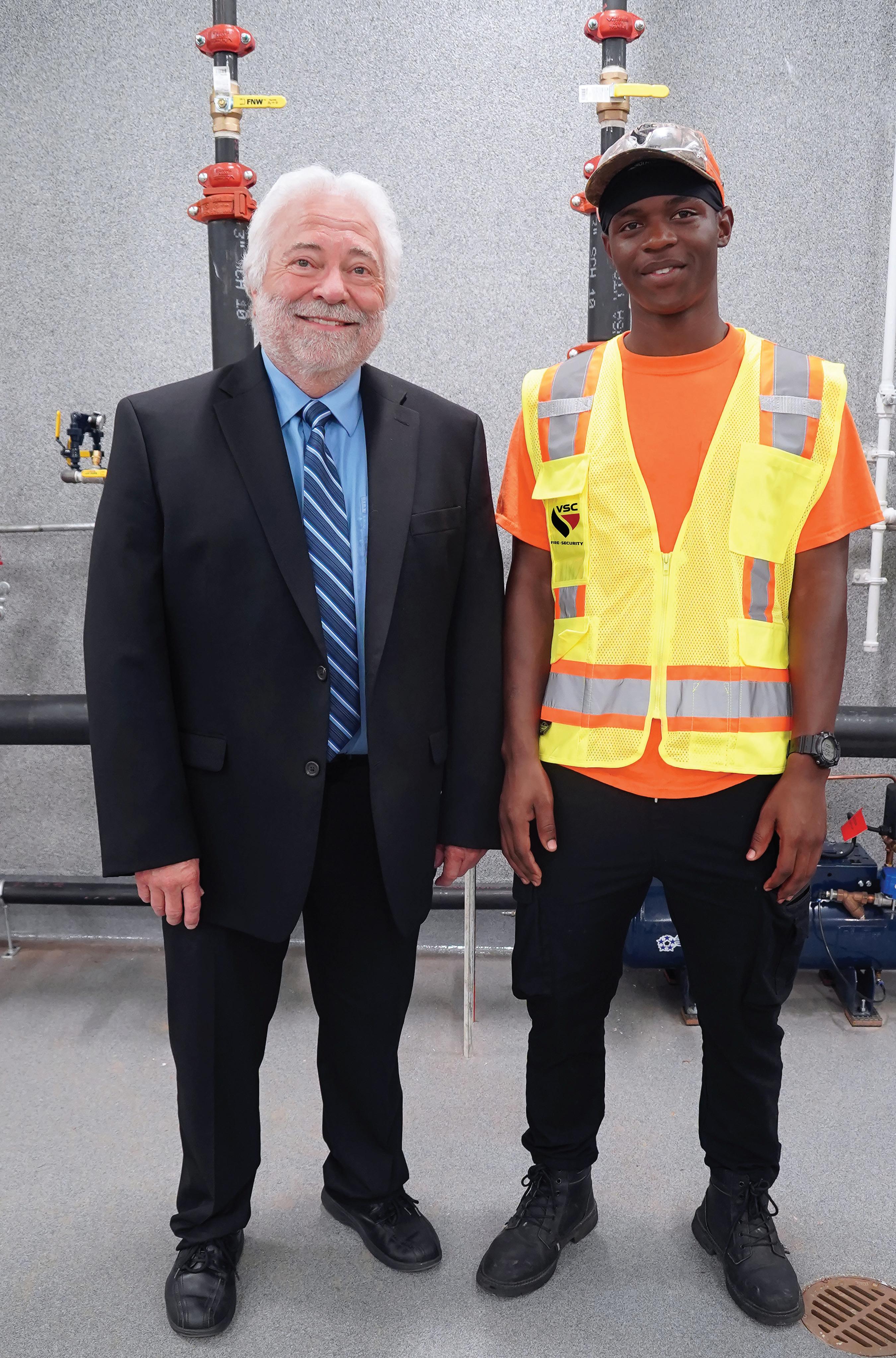
FIRE SPRINKLER ADVOCATE MAC BEATON IS EDUCATING THE NEXT GENERATION
Commercial Riser (can
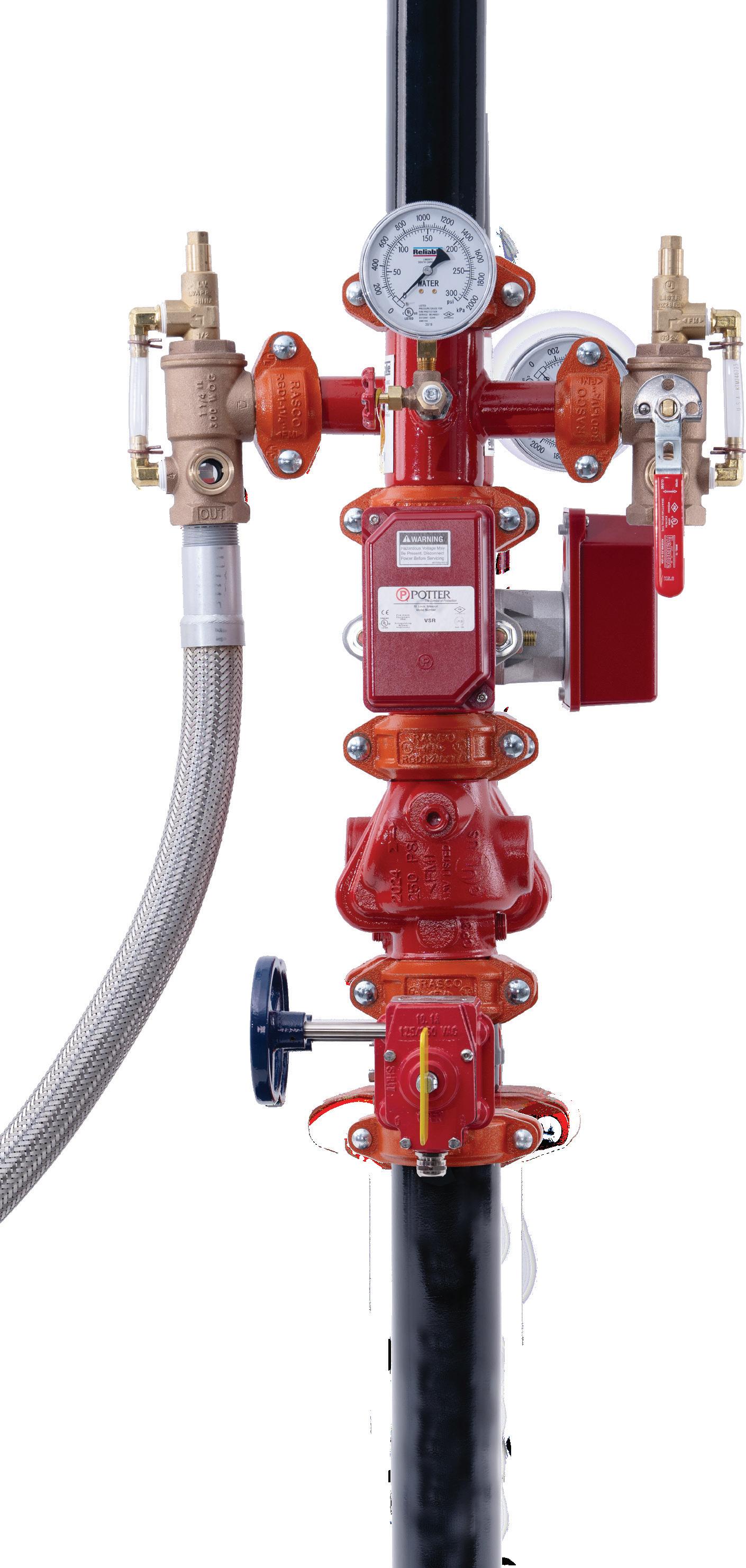
BACKED INTO A CORNER?
THE FCA2 FLOOR CONTROL ASSEMBLY FITS JUST RIGHT Test & Drain
Potter Water Flow Detector available in Explosionproof and automatic test versions
The Model FCA2 is cULus Listed in all sizes and FM Approved in 2"–8". The FCA2 is designed for optimal configuration for any installation scenario. With 360° rotation of each modular component, this versatile assembly adjusts to the trickiest corners.
All the components required for a complete floor control assembly. Available in sizes from 11/4"–8".
One PO. One Box. One Installation.
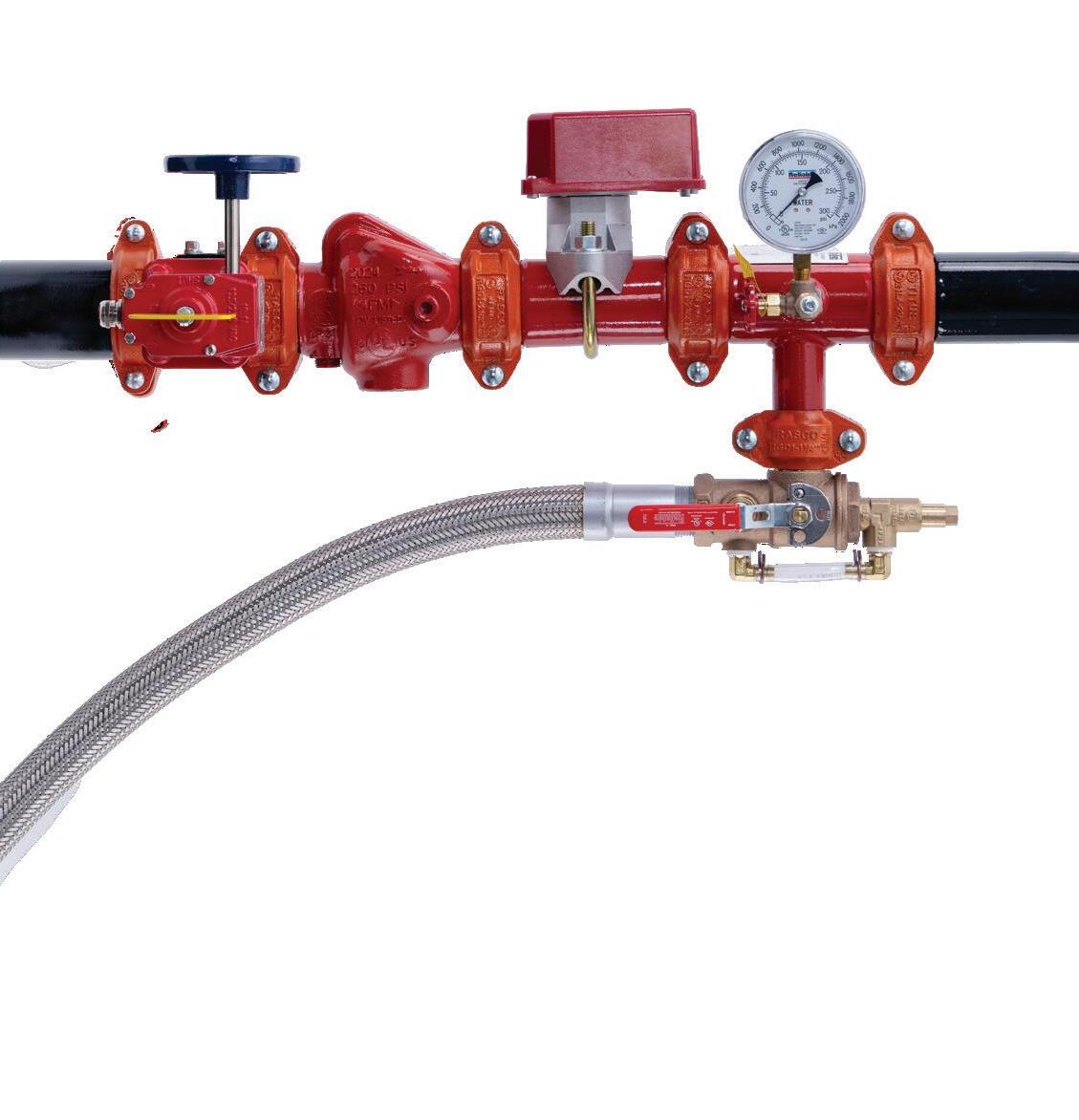

SPRINKLER PIPE, PRE-SORTED

Spend less time searching for the pipe you need. Our proprietary pipe bundling program sorts and identifies project materials before they hit your jobsite, so your fitters can skip the sorting step and jump right into installation.
INCREASED PRODUCTIVITY
› Groove diameter adjustment
› Manual or power driven
› Interchangeable roll sets
› Simple depth setting procedure
› Adjustable ratchet

COMPACT
› Lightweight and portable
› Collapsible for tight spaces
DURABILITY
› Rugged design
› Plastic tool case protects the tool and organizes accessories
› Strong enough for field fabrication
Includes a full package of components for operation and service


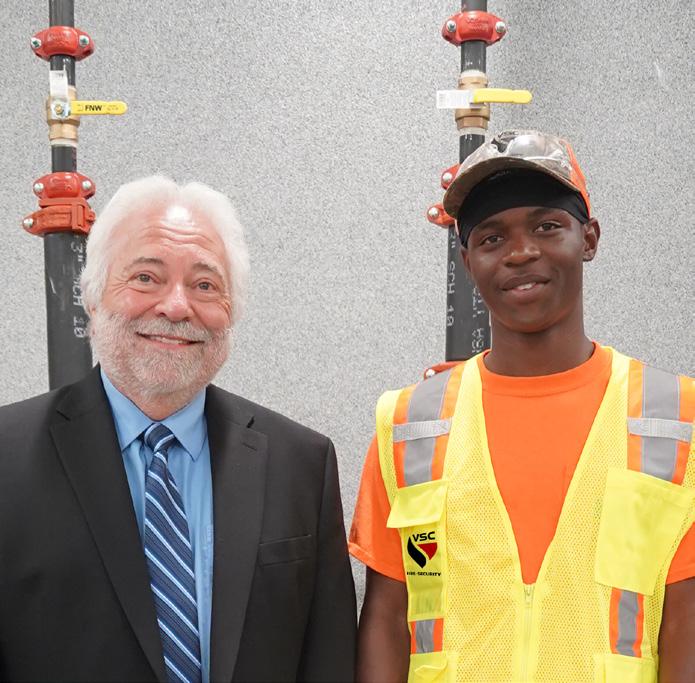
THE COVER: Mac Beaton (left), AFSA’s Fire Service Advocate
CTE Director



CHAIR’S MESSAGE
America celebrated its 249th year of independence this year. What a privilege it is to live in this great land. God Bless America! The second quarter AFSA Board and committee meetings were held in Miami. Your committees and Board are diligently working to ensure that we provide the best of the best for you. As the Board and Committee continue to invest in our future workforce and create awareness for the fire sprinkler industry, I would like to ask our local chapters and NextGen groups to send the name and contact information of local career centers in their high schools. These groups are great resources to implement approval for our apprentice training in their school programs. Help us to help our future!
Congratulations to the North Carolina Fire Sprinkler Association for a successful 2025 Beach Bash. The AFSA chapters are showing up and showing out!
June 16-18, I attended the NFPA conference at Mandalay Bay in Las Vegas with AFSA team members Bob Caputo, John Denhardt, Matt Klaus, Victoria Valentine, Leslie Clounts, and Meda Merritt. Over 4,000 attendees were present, and I am pretty sure the event left its mark on Las Vegas.
July marks the midway point of the year. We continue to move in the direction of opportunity and success for AFSA, its chapters, and members. Invest in our success and get involved at the state and national level. Help us make a difference!
The Southern Fire Sprinkler Summit, hosted biannually by AFSA chapters Alabama, Arkansas, Georgia, and Louisiana, has grown to be very successful. This year’s event sold out, with 32 vendors and over 150 contractor registrants. We know how to have fun, but we don’t miss the training opportunities that come along with the fun. I greatly appreciate the hard work from each of these chapter leaders.
The third quarter Board and committee meetings in Salt Lake City is right after the summit. After those meetings, my schedule includes attending the NASFM (National Association of State Fire Marshals) Fire Prevention & Safety Symposium August 10-12 with Russ Leavitt to present NICET ITM certification requirements at its board meeting. August 21-22, I will attend the Florida Chapter’s Joint Legislative Planning Day.
The apprentice competitors heading to D.C. for the 2025 National Apprentice Competition will be announced soon. Congratulations to all 170 apprentice who participated. Be proud of yourself! I know your companies are proud of you! To the seven heading to Washington, you are vying for a coveted title; congratulations for making it to the convention. I look forward to the great competition. I am predicting AFSA44 at the Gaylord National in Washington, D.C. is going to be another record-breaking year. Hope to see you there!
Where do I begin with my accolades for the Young Professional of the Year, Madison Wolf? She is a woman who has it all and continues to climb the ladder of success. Congratulations on a well-deserved recognition! Our AFSA Advocate of the Year is Mac Beaton. He is the man behind the vision to turn an abandoned mall into a mecca location for trade learning. With the support of AFSA’s Virginia Chapter, he has educated students about our industry, implemented a sprinkler curriculum, and partnered with our members to put them to work installing systems. Congratulations to you both! Madison and Mac, you represent these awards in all facets. n
EDITORIAL: 214-349-5965
BOB CAPUTO, CFPS, Publisher, ext. 124 bcaputo@firesprinkler.org
D’ARCY G. MONTALVO, Editor, ext. 115 dmontalvo@firesprinkler.org
ADVERTISING: 214-349-5965
CLARISSA RIOS, Communications Coordinator, ext. 134 crios@firesprinkler.org
CIRCULATION: 214-349-5965
D’ARCY G. MONTALVO, Editor, ext. 115 dmontalvo@firesprinkler.org
AFSA BOARD OF DIRECTORS
LINDA M. BIERNACKI, Chair, Region 5, 318-841-0330
PAUL DELORIE, First Vice Chair, Region 10, 603-432-8221
JAY STRICKLAND, Second Vice Chair, Region 6, 301-474-1136
ROD DIBONA, Treasurer, Region 4, 605-348-2342
JEFF PHIFER, Secretary, Region 8, 803-438-2994
JACK A. MEDOVICH, P.E., Immediate Past Chair, At-Large, 804-222-1381
BROOKS BAYNE, Region 1, 503-692-9284
HUNTER BRENDLE, At-Large, 334-270-8571
MINDY BUCKLEY, At-Large, 770-925-9099
TOMMY CLEMENTS, Region 9, 804-459-2218
CHRIS JOHNSON, Region 7, 727-5821-9339
R. DONALD (DON) KAUFMAN, Region 3, 505-884-2447
MICHAEL F. MEEHAN, At-Large, 804-459-2200
WAYNE WEISZ, Region 2, 209-334-9119
AFSA LEADERSHIP
BOB CAPUTO, CFPS, President, ext. 124
MATT KLAUS, Executive Vice President & COO, ext. 139
MELISSA ATHENS, Vice President, Finance, ext. 112
LESLIE CLOUNTS, Vice President, Education Services, ext. 130
JOHN AUGUST DENHARDT, P.E., FSFPE, Vice President, Engineering & Technical Services, ext.121
MEDA MERRITT, Vice President, Membership & Chapter Development, ext. 133
Sprinkler Age is devoted to the professional development of the fire sprinkler industry. Deadline is 1st of the month preceding publication.
Published by American Fire Sprinkler Association, 1410 East Renner Road, Suite 150, Richardson, TX 75082. Call (214) 349-5965, FAX (214) 343-8898, or email sprinklerage@firesprinkler.org for information.
Copyright © American Fire Sprinkler Association, Inc. All rights reserved. PRINTED IN USA. Unless expressly stated otherwise, all editorial and advertising material published is the opinion of the respective authors and/or companies involved and should not be construed as official action by or approved by Publisher or the Association.
LINDA M. BIERNACKI AFSA BOARD CHAIR
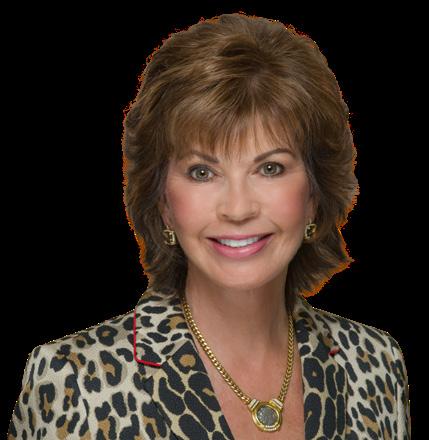
Sprinkler Age is a membership benefit, provided free of charge to AFSA members. For information on nonmember and/or foreign subscription rates, call (214) 349-5965.
ABOUT AFSA MEMBERSHIP
AFSA annual membership dues are a sliding scale for Contractors and Associates and a flat fee for Authorities Having Jurisdiction. (Members receive a free subscription to Sprinkler Age.) Write or call AFSA for membership information. See AFSA’s website at firesprinkler.org.
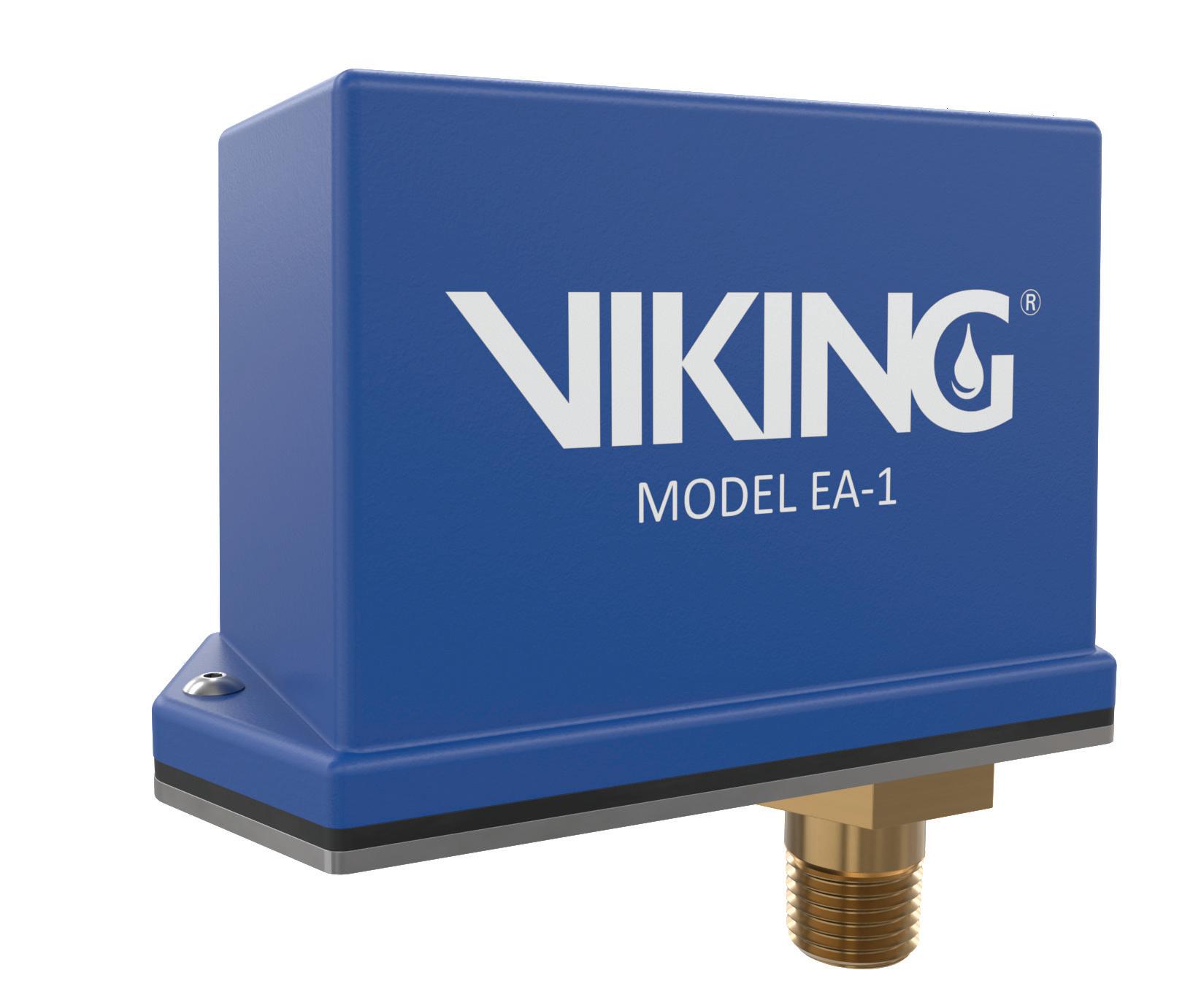
Smarter, Faster Fire Protection with the EA-1
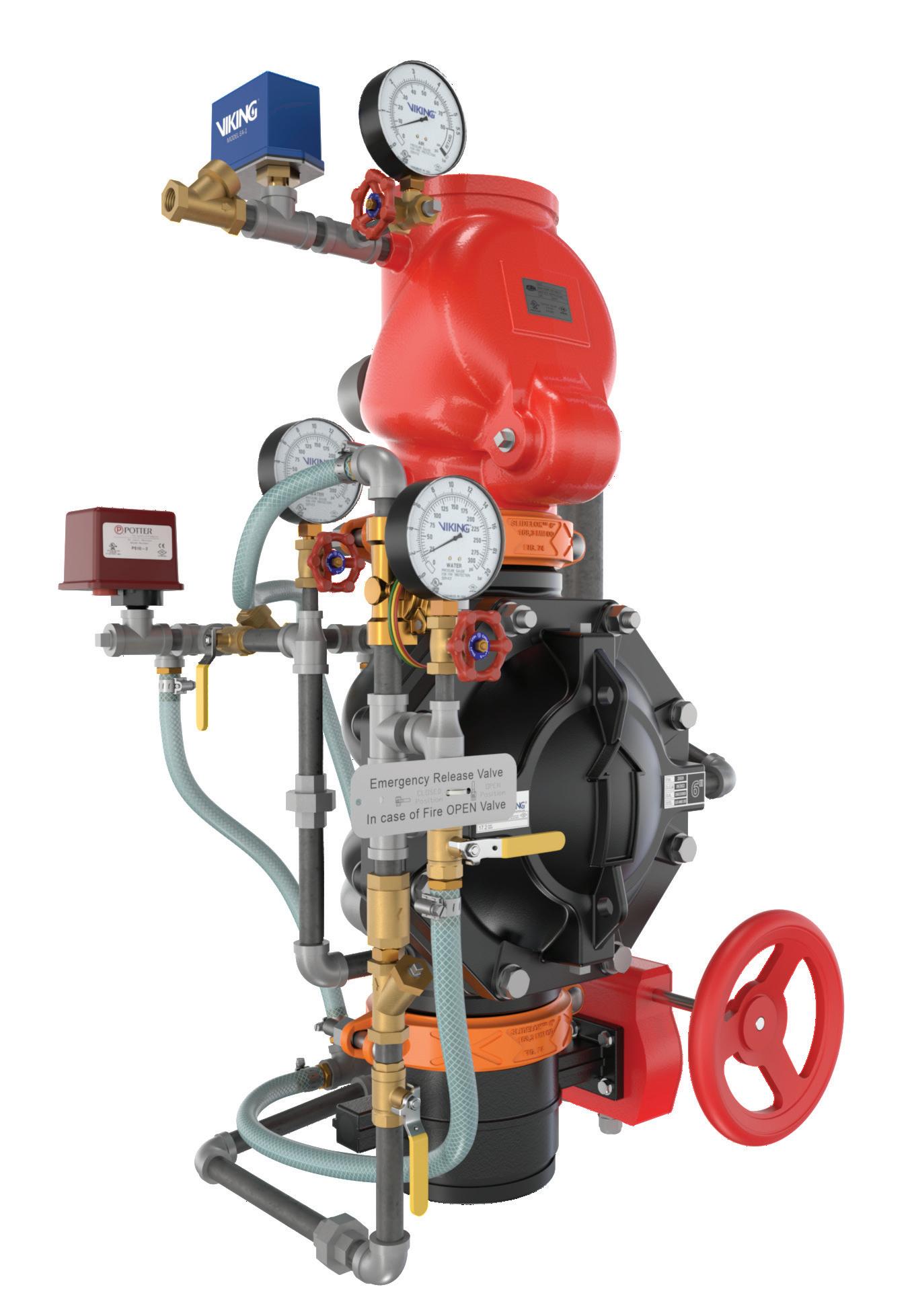
The EA-1 Electronic Accelerator enhances Dry and Double Interlock Preaction Systems with superior speed, efficiency and ease of use. Designed to integrate with the Viking VFR-500 Release Control Panel, it ensures rapid activation, simplifies maintenance and supports both new installations and system retrofits.
Learn more on our website at vikinggroupinc.com.

The Valve & System Configurator makes it a breeze to build out your system riser. Check it out by scanning the QR code, or visiting valveconfig.vikingcorp.com.
PRESIDENT’S REPORT
Having problems getting people to chapter meetings and activities? In my experience, having been the chair of two different AFSA chapters before becoming the president of AFSA, common problems or issues tend to unite communities. Training programs and fun events can only go so far. There needs to be some unifying issues that bring people together for common causes and form bonds with associates, colleagues, and friendly competitors. Even with not-so-friendly competitors. I don’t always know what fire protection contractor concerns exist in your local market or region, but things like long lead times for plan review, excessive permit fees, common misunderstandings with local AHJs, and similar issues can be the catalyst.
While I’m an old-school guy who doesn’t like remote work, I like the idea of hybrid meetings. They’re easier to attend, take less time away from work and family, and can include AFSA staff for participation in technical and membership questions, short presentations, and more. It could even lead to combined meetings with members from other chapters. For the record, I hate remote work because people need to get together in person for collaborative thinking, and when people are out of sight, they are out of mind as well. This can also impact remote meetings, but some of that gets solved with a hybrid approach. If all the information is digital, electronic meetings work well, but people work with people, and that’s how we build relationships.
Chapters start to fall apart and lose their interest when our meetings include more vendors than contractors. A raffle (like a TV or gift cards) can temporarily attract a crowd, but there needs to be substance, or people won’t return for the “rubber chicken dinner” and sales pitch. We have seen successes where chapters ask one or two manufacturers or suppliers to sponsor a meeting with a prize item or host the bar in exchange for presentation time to introduce their products and services. Of course, the main event should be a technical topic or a local AHJ discussing their issues with the industry. Insurance companies and local engineering firms can also bring interest and perspective.
Programs that attract design managers, designers, project managers, estimators, and company owners can increase attendance and tend to keep people engaged in common causes and interests. If your chapter meets quarterly, at least one meeting could target field labor, with tool demos, lift and ladder training, confined space entry discussions, and even conversations about improving production. Inspectors are also a good target. Focusing quarterly meetings on specific targets can help show where the greatest needs are.
Perhaps host local members with a 60-minute Zoom-type call to ask them about their needs and interests, and discover
what topics would bring them and their people to a meeting. Have a roundtable discussion to learn how the chapter can serve the needs of our industry in your region. I’ve always been told that if you want to know what people think, you should ask them. Of course, if no one has anything to offer, maybe everything is perfect, and no challenges or common problems exist.... I’ve been in this industry for 48 years and would love to see that.
AFSA is a member association whose success has continuously been attributed to its focus on the local contractors and suppliers. We are national, but we act and think locally. Everything starts with the members and the chapters; we’re here to help in any way possible. There is no single solution for every chapter or problem, but in my experience serving as your president, I can assure you that our problems are the same everywhere; only the accents change.
On a separate note, I am excited to report that we are accelerating the production of AFSA’s design training series, Sprinkler System Design , which is being revised by a fantastic group of volunteers, in conjunction with staff members. Special thanks and acknowledgment to our volunteer group, including Jared Van Gammeren (and his team), Jason Gill, Byron Weisz (and his team), Randy Mongiovi, and Casey Milhorn for their time, knowledge, and experience. Once completed, we expect it to quickly become the industry gold standard for training sprinkler system layout technicians for many years. The current three-book series is still available for purchase and helpful, but we expect the newly updated product around mid-to-late 2026. While we strive to introduce new and relevant training materials and live programs, we must also keep the current ones updated, all of which keep staff very busy.
Thank you for your membership, and I look forward to seeing many of you at AFSA44 in our nation’s capital. n
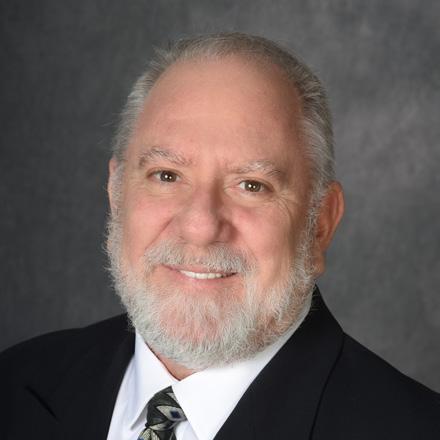
BOB CAPUTO, CFPS AFSA PRESIDENT
NFPA 13 Listed Fire Protection Air
Compressors: What to Look For
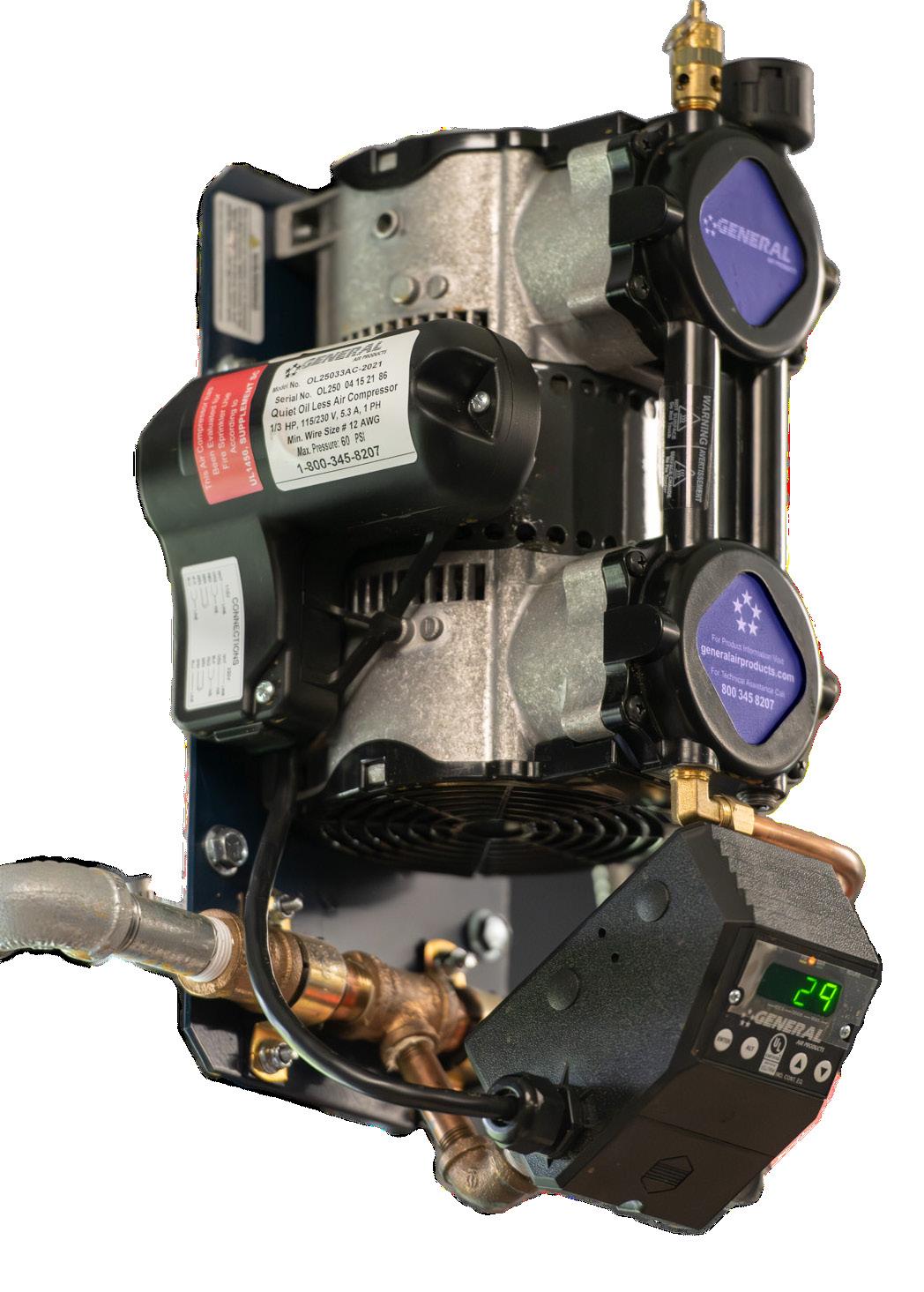
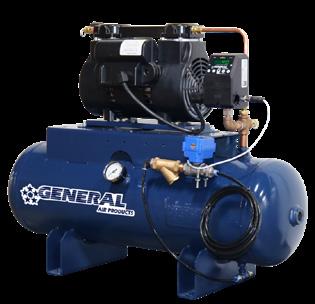
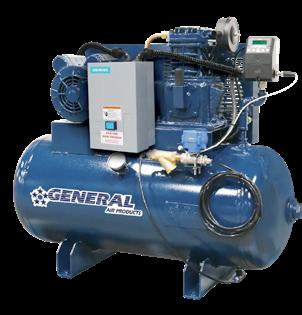
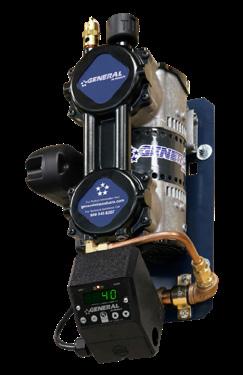
General Air Products is proud to offer a complete line of UL listed & NFPA 13 Compliant Fire Protection Air Compressors.
NEW
NFPA 13 (2025) now states:
“8.2.7.5.2 - Where an air compressor is dedicated for the sprinkler system, the air compressor shall be listed for fire protection.”
Because of the NFPA 13 update, UL added UL 1450, Supplement SC to clarify and standardize what qualifies as a listed Fire Protection Air Compressor.
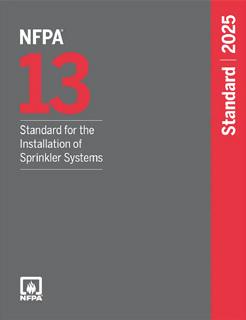

Going forward, listed Air Compressors for Fire Sprinkler use will be marked as follows:
“This Air Compressor Has Been Evaluated for Fire Sprinkler Use According to UL 1450, SUPPLEMENT SC”
Compressors that are not tested to UL 1450, Supplement SC cannot imply suitability for use in Fire Sprinkler Systems.
A few requirements of UL 1450 Supplement SC Compressors:
Complete compliance with NFPA 13
Provided with a mean to be hardwired and permanently connected (No plug in cord)
Pressure-regulating control switch (pressure switch) must operate for 100,000 cycles under rated load
Relief valve tested at 5x maximum setting
Scan the QR Code to learn more about what the changes mean for Contractors & Engineers
FLASHPOINT
All of us involved in the fire protection profession have a common cause—to protect life and property from the dangers of fire. As I travel the country presenting, whether the topic is standpipe systems or ITM, I often ask the attendees if anyone has heard of the One Meridian Plaza fire. To my surprise, very few people have heard about this tragedy.
The One Meridian Place fire taught our industry some valuable lessons. A building was destroyed, and more importantly, three firefighters lost their lives. The building was a 38-story high-rise office building located in Philadelphia, Pa. The approximately 500-ft tower caught on fire on February 23, 1991, at approximately 8:23 p.m. It began on the 22nd floor and raged out of control for 19 hours. Firefighters fought the blaze but struggled due to a lack of power in the skyscraper and insufficient water pressure from the building standpipes. It was only brought under control once it reached the 30th floor, which was one of the few floors that had been retrofitted with sprinklers. Ten sprinklers held back the 12-alarm fire until it started burning itself out.
The blaze killed three firefighters and seriously damaged One Meridian Plaza, destroying eight floors and damaging neighboring buildings in the Center City district. An investigation of the fire, led by the Office of the Fire Marshal of the City of Philadelphia with aid from the Bureau of Alcohol, Tobacco, Firearms and Explosives (ATF) national investigative response team, determined the blaze started after woodworkers left a pile of rags soaked in linseed oil on the floor. The linseed oil oxidized and generated enough heat to ignite the rags, which then set fire to other solvents nearby. Below are some key takeaways from the reports:
• The hose connections on the standpipe system were equipped with pressure-reducing hose valves (PRVs). These were designed to limit discharge pressure to a residual pressure of 65 psig. This was the “normal” value at the time. However, many fire departments had changed their equipment and response tactics to use higher residual pressures. In fact, the Philadelphia Fire Department had changed its equipment, but the building’s standpipe system was not redesigned for the higher residual pressures.
• The PRVs were only adjustable using a factory-provided tool, so the firefighters could not make any field adjustments to the system. Factory set PRVs are still manufactured and permitted.
• The PRVs were ordered for each specific floor and stairway as the location determined the manufacturer’s factory setting. Unfortunately, some of them were installed in the wrong locations. In some cases, this resulted in residual pressures much lower than the 65-psig design pressure.
• At the time, it was uncommon to perform a full flow test of each PRV during acceptance tests. This is now a requirement of
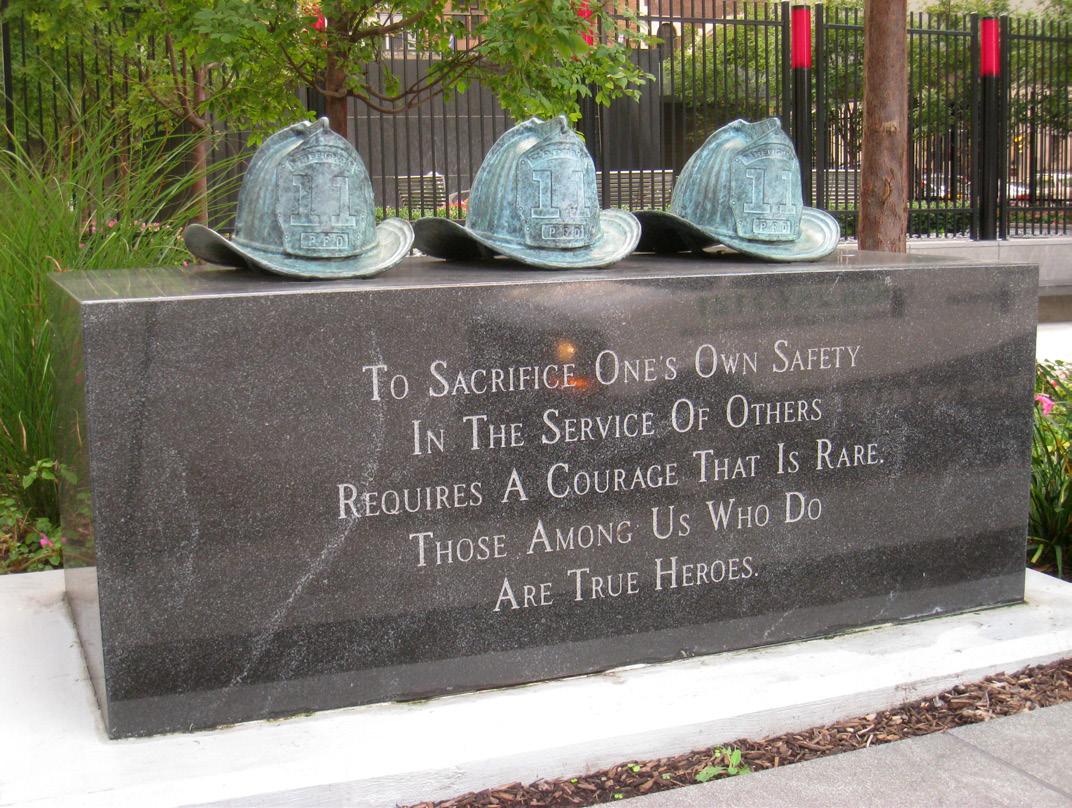
NFPA 14, Standard for the Installation of Standpipes and Hose Systems, and NFPA 25, Standard for the Inspection, Testing, and Maintenance of Water-Based Fire Protection Systems.
• This tragedy helped push the need for NFPA 25, Standard for the Installation, Testing, and Maintenance of Fire Protection Systems, which was in development. The first edition of NFPA 25 was in 1992. Up until then, ITM of standpipe systems varied widely and was often left undone. NFPA 14A, Recommended Practice for Inspection, Testing, and Maintenance of Standpipe and Hose Systems , was available, but since it was not a standard, it was not enforceable. Over the years, NFPA 25 has increased the ITM of standpipe systems and specifically pressure-reducing devices.
“Those who cannot remember the past are condemned to repeat it.” — George Santayana
What we do is important. It can mean the difference between life and death. The equipment we install must be designed, installed, commissioned, inspected, tested, and maintained to ensure it works as designed. Let’s not forget our past—let’s learn from it. n
JOHN AUGUST DENHARDT, P.E., FSFPE AFSA VICE PRESIDENT OF ENGINEERING & TECHNICAL SERVICES
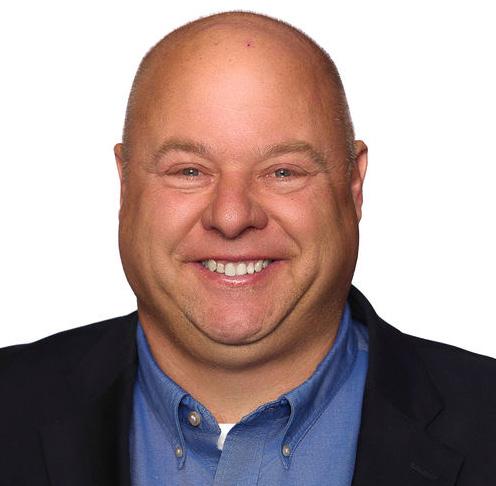
In 2009, a memorial was dedicated to fallen firefighters James A. Chappell, David P. Holcombe, and Phyllis McAllister. It is located in the courtyard of the condominium that was erected on the site after One Meridian Plaza was torn down.
Inspection, Testing, and Maintenance Training
Find the Right One for You!
Find the Right One for You!
Length of Course
Experience
NFPA 25 Included
Hands-On
Certification Exam Strategies
NICET Certification Testing
No-Flow Testing of Fire Pumps
Fire Pump Annual Flow Testing and Data Analysis
Private Fire Service Mains
3-year Testing Review and Demonstration
5-Year Testing Review and Demonstration
Flow Testing of Standpipes
Review Roles, Responsibilities of Owner, Contractor, and AHJ
Wet Systems
Dry Systems
Preaction Systems
Deluge Systems
EARNING AN A+ FOR EDUCATION
MAC BEATON IS AFSA’S 2025 FIRE SPRINKLER ADVOCATE OF THE YEAR
D’ARCY MONTALVO | AMERICAN FIRE SPRINKLER ASSOCIATION
It’s no secret that the trades suffer from a lack of manpower, and that need will only increase exponentially. The fire protection industry has felt pressure to find and recruit the next generation of workers. In a 2024 blog post, TV personality Mike Rowe, who promotes skilled trades, wrote that he was asked where the tradespeople were. His response? “I think they’re in the 8th grade. Have you looked there?”
One professional reaching that generation and putting action behind his words is Mac Beaton, director of career and technical education (CTE) for Henrico County, Va., Public Schools (HCPS). He has put programs in place that educate students about the trades and CTE, beginning even earlier than 8th grade—talking to elementary-school students about a career in the trades. Through those programs, he has also been able to share the message that sprinklers save lives and show the next generations that a career in the sprinkler industry can be rewarding. In recognition of his dedication to informing the next generation about the fire protection industry and educating the public about sprinklers, Beaton is AFSA’s 2025 Fire Sprinkler Advocate of the Year.
LEADING BY EXAMPLE
Beaton’s pathway to a career began much like students of his day. “When I graduated from high school, I ranked second in my class. All I’d heard was to graduate and attend a four-year university. That was my ‘ticket to success’ in life,” he remembers. “Go to university, get a job, and that’s how you make it. The problem was that no one asked me if I wanted that and if I could afford that.”
Beaton notes that one of the best pieces of advice he ever received was from his mother. “She said, ‘Whatever you do in life, keep moving forward. Be the best you can be in what you do, and continue to learn,’ so that’s what I did.”
Beaton found the Norfolk Naval Shipyard’s naval electrical apprenticeship and says it was the smartest thing he ever did. “It taught me the trade and life skills—how to work 12-hour days seven days a week and get things done. You get out of it what you put into it,” he says.
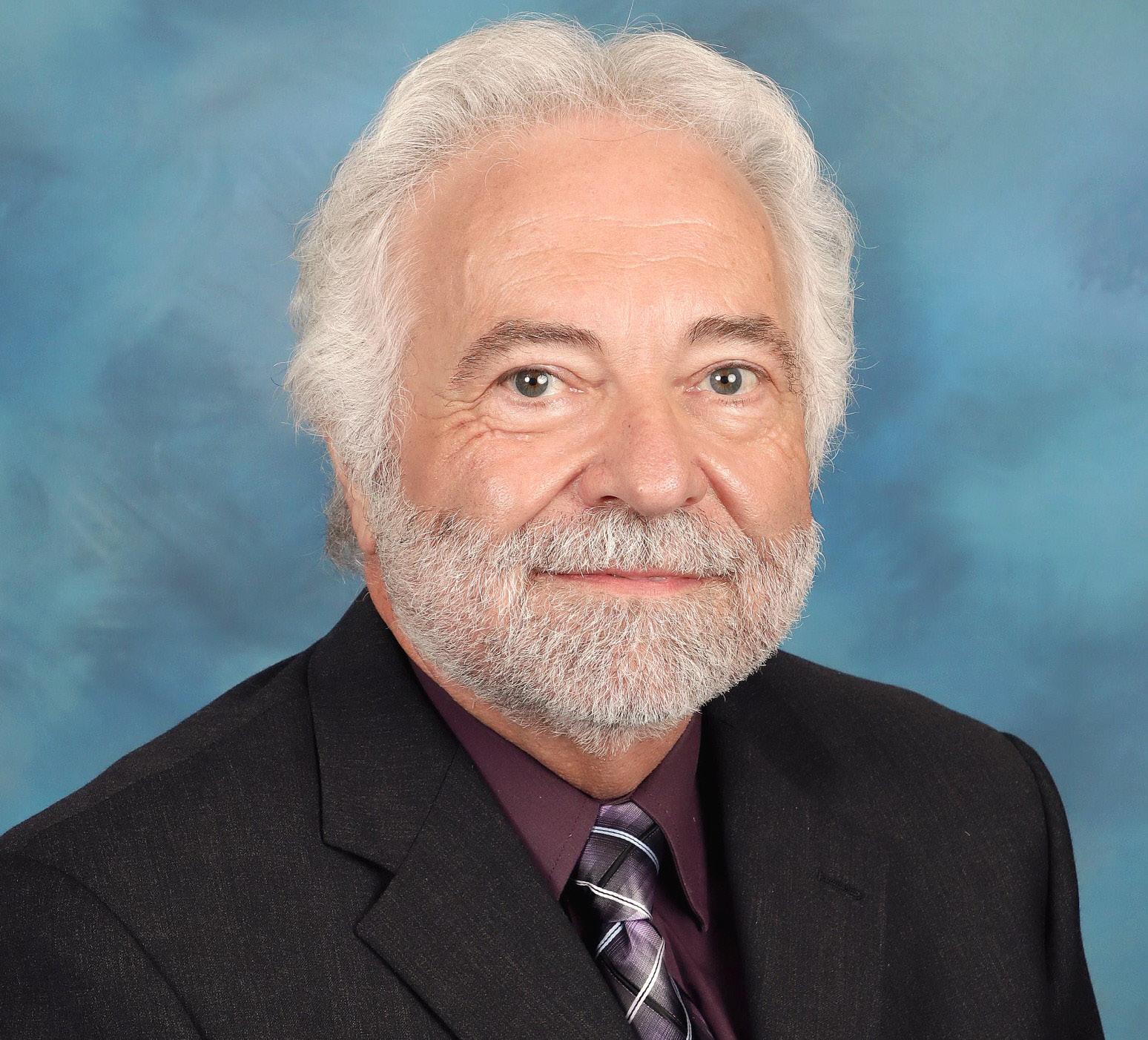
When he finished the apprentice program, Beaton had many job opportunities but chose to attend Virginia Tech and put himself through its engineering program. Once he graduated, he secured a job as a plant engineer, but he couldn’t see himself in that role for the rest of his life. Something wasn’t quite right.
“I decided to make an appointment with the Virginia Tech Career Center, and it was the best decision,” he says. “I met with a counselor, and she said I was off-the-charts in mechanical skills and that engineering was the perfect pathway for me. I told her I wasn’t happy and asked what else she could suggest?”
The counselor was shocked but said Beaton scored high in religion and education. “Once I thought about it, I remembered always helping fellow students with their studies. A few months later, I walked into an electronics classroom and knew I was meant to be there. I haven’t worked a day in my life since.”
Mac Beaton, director of CTE for Henrico County, Va., Public Schools, is AFSA’s 2025 Fire Sprinkler Advocate of the Year.
COVER PHOTO DETAILS: Beaton (left) alongside Jasper Mubawa, a newly hired fire sprinkler apprentice with VSC Fire & Security and the first graduate of Henrico County Public Schools’ Plumbing and Fire Protection Sprinkler Fitting program.
Beaton earned his Bachelor of Science in Education from Virginia Polytechnic Institute and State University and his master’s degree in supervision and administration from Virginia Commonwealth University.
Beaton has spent the last 40 years in Henrico County schools as a teacher, education specialist, and, for the last 25 years, has served as director of its CTE. He loves to help students answer their “why.” “My job is to help my kids see all the opportunities and get them where they want to go. Students who complete a CTE program graduate with more than just a diploma. Many obtain a skill set, nationally recognized certification, or state license that prepares them for their career.”
After four decades of working with students with no signs of slowing down, what continues to drive Beaton? “When I was in school, I’d bring home straight As, and my mother would say, ‘That’s great, but you’ve only got one direction to go. We’re here, but what can we do next?’ I’ve taken that principle and used it as a guide for my career and my life. What can I do next?”
ENROLLED, ENLISTED, EMPLOYED
Beaton and the HCPS staff advocate that there are multiple paths to rewarding careers. “Our focus is on the ‘3E’s’—for all HCPS students to be enrolled, enlisted, and/or employed,” comments Beaton. “Historically, most school divisions will wait until their students are in high school to offer those careerbased programs. But the trouble is, you’ve had 10 years prior trying to figure out what you want to do, and no one told you how to get there.”
The HCPS program starts in elementary school, where careers are discussed on a broad scale. Programs are then continuously built. At the middle-school level, students interested in CTE can explore more by taking electives. In high school, students can enroll in classes such as CAD 1 and CAD 2 and then move into the Advanced Career Education centers for their junior and senior years. “Students are finding out if they like a particular field and its career options. If they discover a trade they love, we are building the skill sets they need,” Beaton says.
The county also offers summer programs for middle and high school students to learn about careers at different intensity levels. “It’s all about students learning more about the trades and immersing them, so by their junior year of high school, they know more about what they want to do. We make a very concerted effort to talk about careers early on, so by the time you get to high school, you know where you want to land,” Beaton summarizes.
“Ask any high school student what the purpose of attending school is, and they say ‘to graduate.’ As a school system, we used to say we wanted students to graduate from college and be career-ready. However, how many kids start college and don’t finish? Or they graduate and then don’t know what they want to do or don’t like the career field they chose?” questions Beaton. “Now we’ve realized we need to start talking to students about their ‘why’ and have them explore all options—such as trade school or the military—
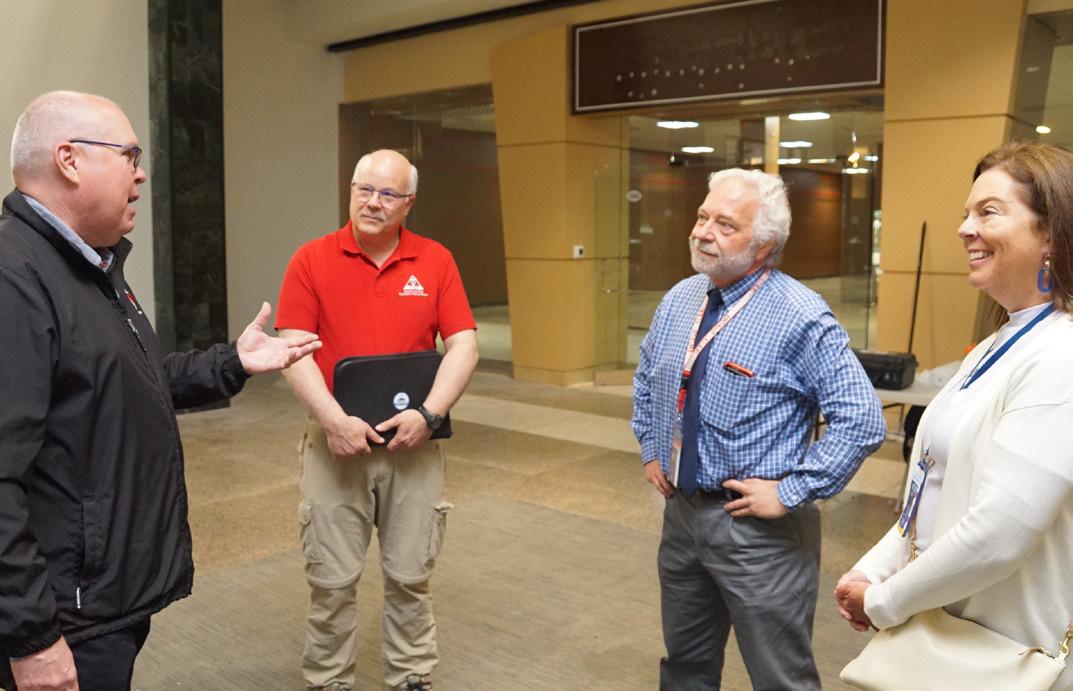
much earlier. That gives graduating kids a pathway to get where they want and have a purpose.”
By the time CTE students graduate, they have earned their OSHA 10 card and work-based readiness certification. They’ve also acquired basic professional and life skills—how do they write a resume, call in sick for work, or confront a problem? “Our program equips students with credentials and life-ready experiences so they can take ownership in navigating their own career paths,” Beaton says.
IT’S A HANDSHAKE, NOT A HANDOUT
Beaton’s down-to-earth approach helps when talking to local businesses about partnerships. “I’ve found that human nature is to step back from an immediate ask. I’ve always tried to come out of the gate and say, ‘Here’s what I can do for you.’ People usually feel inclined to do something nice back if someone does something nice for them!” he laughs.
Beaton sees his job as an educator as going out into his community, discovering what’s happening, and sharing it with his students. “I find the people who can show students what careers are available and how they operate. I am always reaching out to build business partnerships for our kids.”
The HCPS CTE program includes a Business Advisory Committee. “Ours is very large, active, and different,” Beaton says. “Most people see an advisory board as a sounding board, but I wanted more interaction and feedback. I wanted a true partnership—ideas and suggestions, and not just my giving reports to a sounding board. We all work together.”
One such interaction involves bringing business partners to teach and interact with the CTE students. “We need that partnership because I need to give students the skill set employers require. Professionals who come into our programs are impressed with our kids. They’ve learned the required skills plus the soft skills of looking adults in the eye, shaking their hands, and engaging with them.”
Local businesses help Beaton host several community events throughout the year. One is the Life Ready Expo, where companies showcase their industries and careers within those
From l to r: In 2022, Virginia Chapter Board Members Jeff Lewis and Bob Beckwith toured the new CTE Regency Mall project with HCPS’ Mac Beaton and Beverly Cocke.
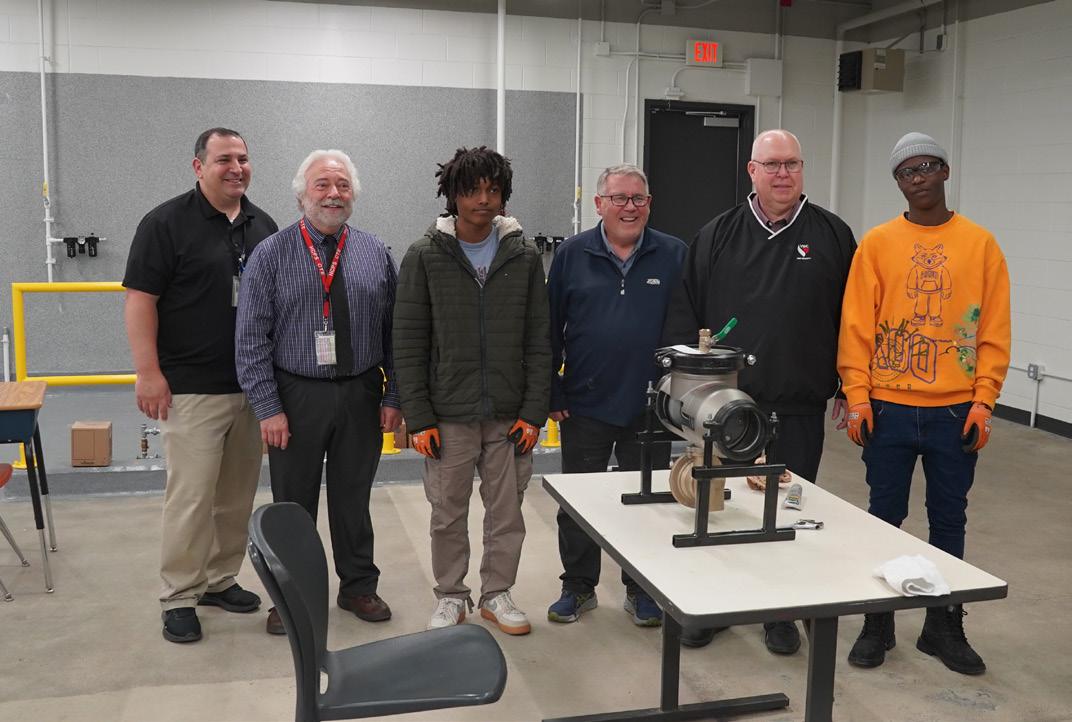
Donations of equipment and expertise are helping prepare graduates of the newly launched Plumbing and Fire Sprinkler Fitting program at the Advanced Career Education Center at Virginia Randolph.
industries. Typically featuring over 160 businesses, attendance has risen to nearly 5,000 during the hour-and-a-half event. “We invite students and their parents in sixth through twelfth grade to learn more about careers,” says Beaton. The governor showed up last year, so we know this event draws attention across the state.”
Attendees talk with employers about career opportunities and the total value of their pay and benefits. They learn about multiple ways to “learn and earn” when they take advantage of employer programs that pay employees to attend college and receive other training after high school. Attendees can also tour the Adult Education Center and talk with current seniors about their coursework and where they’re headed.
Another event, the Career Rodeo, gives the students time to shine. Wearing number bibs, much like pro rodeo contestants, students demonstrate their skills and knowledge to solve workbased challenges for potential employers. “You think about going into a formal interview and how stressful that can be,” notes Beaton. “In this format, students are much more at ease and confident talking about something they love.”
Taking place in a big event hall with everything from cosmetology to a mock trial to an auto body shop, employers interact with students and write down the bib number of students’ resumes they’d like to view. CTE staff then work to set up any interviews between business partners and students, potentially leading to full-time employment.
The Career Mega Sale offers the opportunity to “shop” from 50 businesses to find the career with the perfect fit. Participating companies are looking to fill positions from the office to the field and educate students on those positions. Attendees meet hiring representatives from dozens of companies; some are even hired on the spot.
The final event to celebrate the end of the school year is the Letter of Intent Signing Day. This event celebrates students entering the workforce after high school graduation and has become an example of what is great about a CTE education.
Since the first signing day, HCPS has been contacted by school representatives from 49 states and several provinces in
Canada about replicating the event. Beaton has been interviewed by local news organizations and many national news outlets, such as NBC’s “Today” show, Fox News, and CNN’s “Headline News.” He has also had radio, print, and internet-based interviews about signing day. The attention has put HCPS’ CTE programs under a national spotlight.
Mac has been recognized with various awards for his progressive approach to workforce development and was recently honored as an ICON in Education Design Award recipient. He has also received the Virginia Teacher of the Year Award and two National Association of Counties (NACO) Awards for the Life Ready Expo and Career Rodeo.
“We always have something going on,” notes Beaton. “We’ve been so fortunate that the county has embraced our actions. Our businesses and government realize that if kids obtain jobs and stay local, it helps everyone. That’s how you keep your county growing and thriving.”
Jeff Lewis, vice president of technical workforce development with VSC Fire & Security in Richmond, Va., and second vice president of the Virginia Chapter, nominated Beaton for this award. “Mac has been a tremendous partner, and that’s his whole goal—to build partnerships. He’s gone far beyond the initial partnership, and our chapter has responded in kind. Mac is a true visionary.”
CHAPTER CONNECTION
Beaton connected with the AFSA Virginia Chapter in 2022 when he attended a career fair that members hosted at one of the local hotels. “I attended the event with some of my colleagues and students,” he remembers. The chapter had a great set-up with about 25 different vendors with neat stuff to show, but only had about 20 students show up.”
Shortly thereafter, Bob Beckwith, co-owner of AFSA Contractor Member Cavalier Fire Protection in Dumfries, Va., talked about the fire protection industry and careers on an episode of Henrico CTE Now, a podcast started by Henrico CTE. The show began airing in 2018 and was one of the first of its kind. Now in its seventh season, the podcast featured Beaton as its first guest and showcases students, careers, industries, programs, events, and business partners. It’s been a successful public education effort with over 140 countries listening.
“Mac is a unique individual with whom the Virginia Chapter has developed an ongoing private-public partnership and lifelong friendships. The experience working with him and Henrico County Public Schools on the podcast, career fairs, Regency Mall tenant fit-up, fire sprinkler lab, fire sprinkler curriculum, and installation of fire sprinklers in a single-family home has been inspiring,” says Beckwith, who currently serves as president of the Virginia Chapter. “Mac is a deep thinker and problem solver extraordinaire when it comes to exposing his CTE students to new career opportunities. He doesn’t just think outside the box; his thought process is often outside the universe to accomplish a mission.”
Beaton realized chapter members wanted to get in front of students but didn’t know how. Beaton’s first suggestion was that
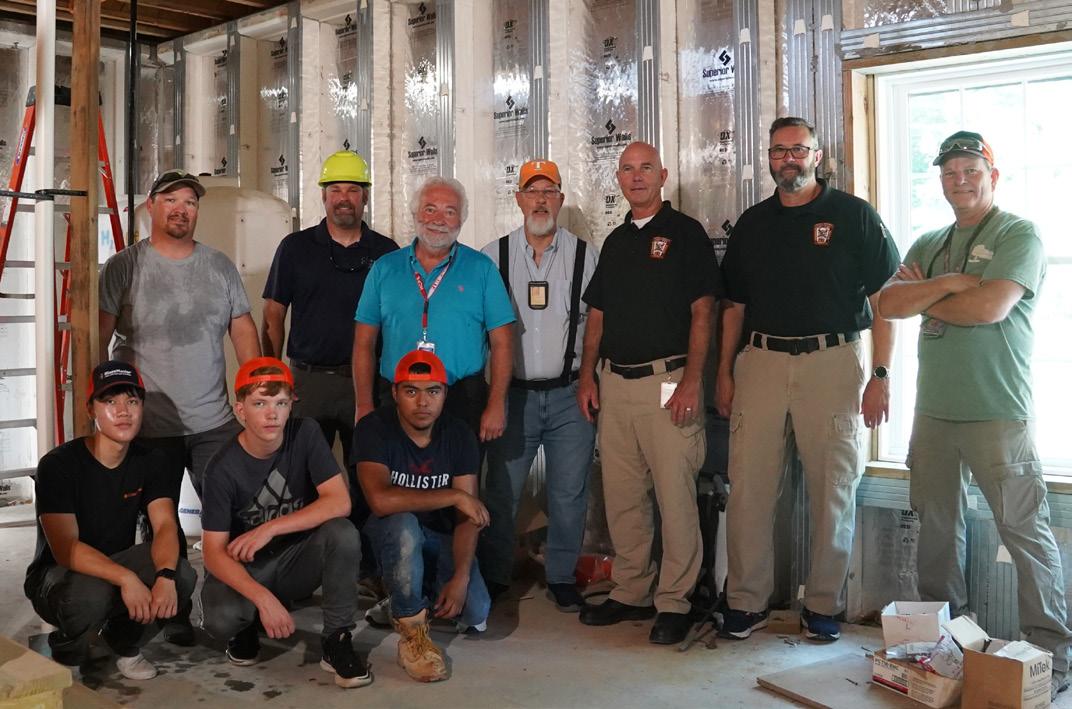
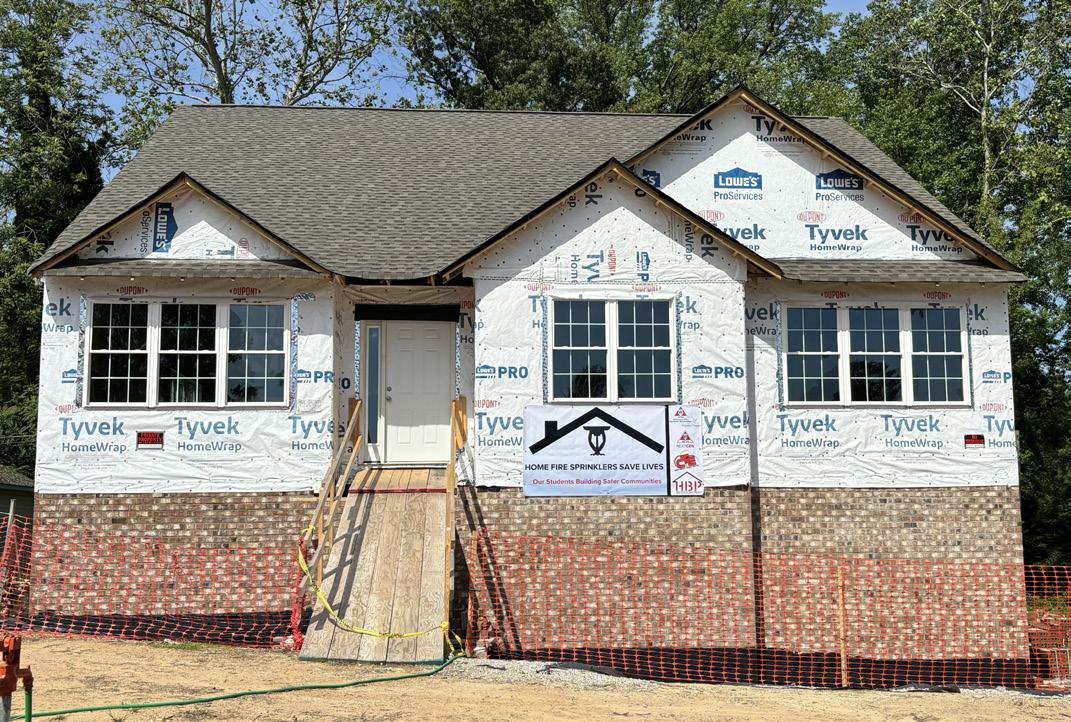
members participate in the Regency Mall project. “Kids need to see the inner workings of something, take it apart, and explore it. That’s the way kids learn. The only thing these kids knew about sprinklers was not to hang their clothes on them in a hotel room. They were a mystery they weren’t supposed to touch.”
The project entailed industry partners, CTE students, and CTE instructors working together to renovate 48,000 ft2 of underutilized space at Regency Mall, transforming it into an HCPS Adult Education Center. Completed in a year and at a third of the original projected cost, the Regency renovation was the first of its kind in the country and demonstrated the effectiveness of industryschool partnerships in helping more students enter the trades upon graduation. The adult education center allows adults to pursue GED preparation, English Language Acquisition (ELA) classes, and career-oriented certification programs. It aims to make adult education more accessible and attractive by offering a range of programs in a familiar, mall-based setting.
For the sprinkler portion of the renovation, 261 sprinklers had to be moved. Chapter members banded together to secure donated materials from different companies. “It was a great opportunity to talk to the kids about sprinkler systems and let them see and understand them,” says Lewis.“We definitely saw a change in the mindset of the kids once the system made sense to them.”
Students working on the project saw the drain down of the system and how to replace the sprinklers, and some worked with CAD students to lay them out. “Kids saw things they’d never seen before,” remembers Beaton. “They were engaged! Having the project done was great, but what the kids got out of it was most important. Relationships drive these kids nowadays. They really enjoyed directly interacting with the crew and learning what they do.”
Once the mall renovation was complete, Beaton asked the chapter to create and maintain a “storefront.” Each store space in the center features an industry or career field. The Virginia Chapter has outfitted its space to showcase different careers, including pipe fitter, designer, inspector, and jobs. Posters, brochures, and videos are available to view. Contact information is provided for those wanting more details about the trade or job.
“It’s an ongoing career fair for adults,” notes Beaton. “Once the mall space was complete, we moved the Virginia Chapter’s career fair to this location, and over 200 kids attended.”
Last summer, Beaton partnered with the chapter to promote residential sprinklers. Through the Henrico County VoTech Education Foundation’s House Building Project, students in carpentry, electricity, drafting, masonry, and HVAC programs apply what they learn in the classroom in a real-life setting by building a house. These homes are built by rising high school sophomores. Funds derived from the sale of the homes are used to ensure the continuation of the project and other associated programs. This past summer, students completed their 20th home build, and Beaton was able to have sprinkler fitting students join in and install a residential system in the home.
“We were at the perfect point to put a residential system in the house,” remembers Beaton. “We’re taking kids from zero knowledge to having them completely install a system.”
Beaton notes that most contractors are leery of installing these types of systems, and including one in the project helped dispel the myths. “As we continue building on our business partnerships, we’ve now got home builders asking about the systems. We can show it’s not a huge spend, and there aren’t the problems they think they might encounter.”
Beaton has also involved local fire officials with the residential installation, and they’re enthusiastic about the addition. County management and building inspection departments are also invested. “From the fire service perspective, we are so fortunate that we have someone from the education side as an advocate for safety, specifically, the need and benefits of a sprinkler system in a residential setting,” says Henry Rosenbaum, retired fire marshal for Henrico County, Division of Fire. “Mac pushed forward on this after seeing the benefit. He had some hurdles, but never gave up and kept seeing the value in it.”
“Mac has become a major advocate for our trade in the county and nationwide. In each of these projects, the goal has been to work with students to close the awareness gap about our industry,” comments Lewis. “We have been held up as an example
In a first of its kind, students (kneeling) worked alongside industry and county government professionals to install and test a fire protection system in a residential home, also constructed by HCPS Career and Technical Education students.
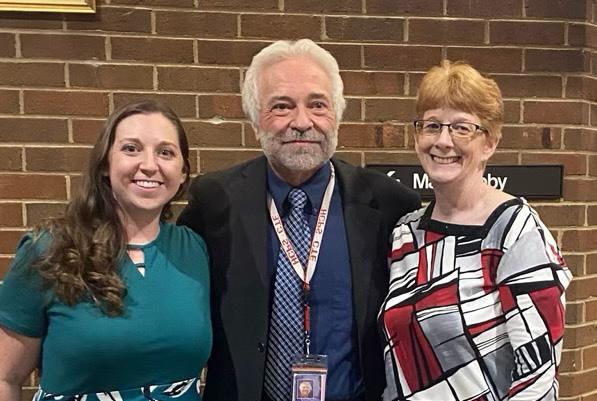
Beaton’s wife, Laura, and their daughter, Whitney, both proud educators, are always providing support and encouragement.
of how a building department, school system, and trade association can work together for students and a better community. If students can install a home fire sprinkler system, why can’t professional builders?”
FIRE SPRINKLER ADVOCATE OF THE YEAR AWARD RECIPIENTS
1997 Dan Jones, Chapel Hill, North Carolina Fire Chief
1998 John Vendetta, Hartford Fire Chief
1999 V.J. Bella, Louisiana State Fire Marshal
2000 Dennis Compton, Mesa, Arizona Fire Marshal
2001 George Miller, National Fire Protection Association
2002 Jim Ford, Scottsdale, Arizona Fire Department
2003 Gary Keith, National Fire Protection Association
2004 Jan Gratton, Fire & Life Safety Educator, Covina, California Fire Department
2005 Senator Rick Santorum (R-PA)
2006 Meri-K Appy, Home Safety Council
2007 Rep. Jim Langevin (D-RI)
2008 Ron Hazelton, Home Improvement Expert
2009 Olin Greene, U.S. Fire Administrator
2010 Jim Shannon, National Fire Protection Association
2011 Jeff Feid, State Farm Insurance
2012 Tonya Hoover, California State Fire Marshal
2013 William Barnard, Maryland State Fire Marshal
2014 Peg Paul, Home Fire Sprinkler Coalition
2015 Ed Van Walraven, Aspen, Colorado Fire Marshal
2016 Ed Altizer, Virginia State Fire Marshal
2017 Randy Miller, Camas, Washington Fire Marshal
2018 Richard Smith, Maryland State Firemen’s Association
2019 Amy Acton, Phoenix Society for Burn Survivors
2020 Brian Geraci, Maryland State Fire Marshal
2021 H. Butch Browning, Louisiana State Fire Marshal
2022 Ron Siarnicki, National Fallen Firefighters Foundation
2023 Todd Short, Redmond, Washington Fire Department
2024 David Lowrey, Division Chief/Fire Marshal, City of Boulder, Colorado Fire Rescue
2025 Mac Beaton, Henrico County Public School System, Virginia
Another project that brought together the industry and school district was the build-out of the second floor of the Advanced Career Education Center at Hermitage, where students from the CTE programs work side-by-side with local skilled trades professionals. “This transformation was driven by demand. With the urgent need for a health care and trades workforce, the build-out will help us get more students credentialed and experienced in both career paths,” says Beaton. “When we constructed this center, we purposefully left this space unfinished to provide trades students with the experience of working on a building site.”
Beaton worked with the chapter to bring in donations ranging from sprinklers to piping and risers to assemble a working wet sprinkler lab. The fire sprinkler lab has active alarm, dry, preaction, and deluge valves for the students to use in training exercises during the semester. It also has a glass-walled separate wet room with a large drain for the students to activate different types of fire sprinkler.
Another benefit for the industry is that the Henrico County Fire Department will be able to utilize the lab to train its firefighters on the different types of systems. “This partnership with Mac and the Virginia Chapter members has brought so much to the table that we [the fire service] wouldn’t have been able to do it on our own or Mac on his own,” comments Rosenbaum. “In Henrico, we like to say that we love to have a relationship where you have the public and private entities involved to make a better product or service, and this is one great example.”
In addition, HCPS approved and implemented a sprinkler curriculum that started last semester with four students. Seventeen students are signed up for the 2025-26 school year. The new HCPS fire sprinkler program utilizes the National Center for Construction and Education & Research (NCCER) sprinkler fitting training books for instruction.
“It’s been a perfect storm for everything to come together,” comments Beaton. “There’s so much passion within AFSA and its chapters for the industry. We’re asking all these companies to help us, and they are jumping at the chance. Both of us [Henrico County Public Schools and Virginia Chapter contractor members] have gotten far more out of this partnership than we ever thought possible”
Lewis agrees. “Our industry has a big heart and is full of really good people willing to give. I think that has attracted Mac. By working together to create this lab, the county has also become financially invested in our success. Our work and ideas are also expanding to other chapters, and we’re proud that it started right here,” he says.
Chapter members and Beaton shared their success with industry members at AFSA42: Convention, Exhibition, and Apprentice Competition, held in September 2023 in Orlando, Fla. Their seminar was well attended and popular among attendees.
“Mac is an amazing and dedicated educator whose commitment to his students is unsurpassed and reaches beyond the borders of his community,” comments AFSA President Bob Caputo, CFPS. “The options provided to students and the
encouragement they receive are a benefit to construction trades, but, more importantly, are a benefit to the students and their families. This program is so impressive that it’s been imitated by others outside of Virginia. It is a tribute to the vision Mac and his team have introduced to ensure the success of their students and their community.”
WELL-DESERVED HONOR
AFSA established the Fire Sprinkler Advocate of the Year Award to honor individuals not directly involved in the fire sprinkler industry whose efforts have significantly advanced the fire protection industry and automatic fire sprinklers. Each year, AFSA’s Legislative Committee selects a recipient from a pool of nominations. Their nomination is then approved by the AFSA Board of Directors. Beaton will receive the award during the General Session at AFSA44: Convention, Exhibition, and National Apprentice Competition in Washington, D.C.
“I’m so excited Mac is getting this award,” says Lewis. “Mac has kept his word about doing everything he can to promote our industry as a place where students will want to come to work.”
“We are very proud and honored that our visionary Career and Technical Education program leader, Mac Beaton, is being recognized yet again, and deservedly so,” said Dr. Amy Cashwell, Superintendent of Henrico County Public Schools. “His foresight of the need to train students in fire sprinkler installation is opening new doors for them into another in-demand career. Our students have already installed sprinklers in commercial and residential projects, which led to the implementation of a
first-of-its-kind educational fire sprinkler lab and program that will double its first-year enrollment this new school year.”
“Mac exemplifies a true passion for what he’s doing,” comments Jason Gill, operations manager, Crews & Gregory Fire Sprinklers, Inc., and a director of the AFSA Virginia Chapter. “Though the fire sprinkler industry is just one of the trades he works to give kids a head start in, Mac’s given kids a chance to see our industry in a way we haven’t been able to accomplish quite the same as an industry alone.”
He continues, “The project Mac started as a local county program has inspired others nationwide to partner up, whether it’s schools partnering with local industry leaders or vice versa. Mac is one of us. His reinvestment in the trades is changing the game. He’s always eager to help, not just by delegating but also by getting involved. With Mac, there are no problems, just opportunities.”
Beaton shies away from the accolades but is eager to share his appreciation for the members of this industry. “From the first time I went to AFSA convention as an educator, I felt so welcomed inside a trade. There’s not a nicer group to have done this with.” n
EDITOR’S NOTE: Do you know someone who should be nominated for AFSA’s Fire Sprinkler Advocate of the Year award? AFSA is proud to recognize those individuals who have given extraordinary support to furthering the advancement and awareness of sprinklers and the fire protection industry. All three of AFSA’s annual awards accept nominations yearround at firesprinkler.org/awards. (Member login required.)
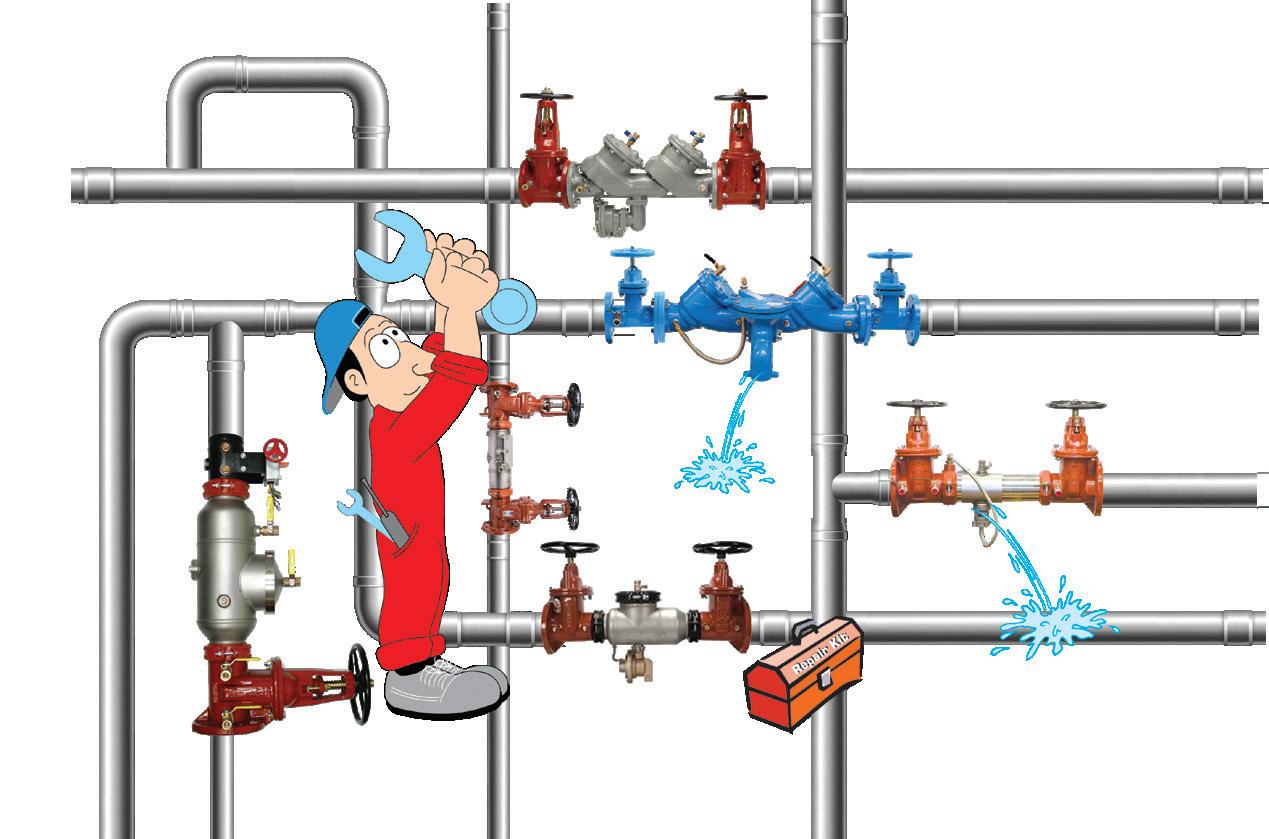
AFSA44 EXHIBITION HAS NO EQUAL
LARGEST SPRINKLER TRADE SHOW OFFERED IN D.C. THIS FALL
Want to view the latest advances in products, technology, and services available to the sprinkler? The best-ofthe-best will be showcased in one place this fall—AFSA44: Convention, Exhibition, and Apprentice Competition. To be held Oct. 15-18, 2025, at the Gaylord National Resort & Convention Center, AFSA44 welcomes attendees to the Washington, D.C. area for education, exhibits, and entertainment!
Over 60 technical and managerial seminars will offer 70-plus hours of continuing education. In addition, this year’s exhibit hall is close to selling out, with over 100 companies confirmed. Capping off this capital event are the 32nd National Apprentice Competition (NAC), networking meals, and social events. If you haven’t already registered and booked your trip, what are you waiting for? This fall, D.C. is the place to be!
ENGAGE IN THE EXHIBIT HALL
AFSA44 offers a larger exhibit hall showcasing the industry’s best manufacturers and suppliers. Both domestic and international companies will offer the latest technology, products, and services during two exhibit hall sessions: the popular Exhibition Grand Opening Reception on Friday, Oct. 17, from 3:30 p.m. –7:00 p.m. and the unopposed Exhibit Hall Saturday, Oct. 18, from 12:30 p.m. – 3:30 p.m.
Hosted by AFSA Chair of the Board Linda Biernacki, president of Fire Tech Systems, Inc., Shreveport, La., the Exhibition Grand Opening Reception offers the first look at this year’s exhibits. Eat, drink, and network as you visit with manufacturers and suppliers across the expansive hall.
The next afternoon, the hall will open once again to attendees, with the 32nd National Apprentice Competition simultaneously underway. This year, the sprinkler installation practical test will be centered in the exhibit hall, and convention goers can watch as the top seven apprentices cut, thread, and install a steel and plastic pipe system with sprinklers. Judges will perform a pressure test on each system and calculate points earned in this competition phase.
NETWORK AT AFSA44
AFSA44 offers the perfect setting for networking with time to visit between seminars, during unopposed exhibit hours, around the table at networking meals, and amid social events. The

Opening Party will be an evening full of fun and entertainment as AFSA takes over the Gaylord National Resort’s Harbor Social Sports Bar and beautiful atrium. Guests will experience a vibrant atmosphere, delicious food, and unique activities. Try your hand at darts, bocce, and duck pin bowling, all while networking with fellow attendees from across the country.
The Gaylord National’s Riverview Ballroom will be the setting for the final night Awards Party. The venue offers stunning views of the Potomac, the Capital Wheel, and across to D.C. During this final evening together, AFSA will celebrate America and the apprentice competition finalists. The highlight of the party will be the announcement of the NAC champion, who will receive bragging rights, tools, a commemorative plaque, and a larger cash prize than ever before—$10,000!
DISCOVER D.C.
D.C. is the place to be this fall, and the Gaylord National and Residence Inn National Harbor are ready to welcome AFSA44 guests. The Potomac area is not only home to the nation’s capital but also to a diverse array of enriching and historical neighborhoods with local monuments, unique attractions, and regional cuisine, including the National Harbor.
As part of your overnight stay at the Gaylord National, hotel guests can ride the National Harbor Circulator bus for free. This bus runs daily and can take visitors to the National Harbor waterfront, offering boutique shops, restaurants, and entertainment options like the Capital Wheel, where you soar 180 feet above the Potomac River for incomparable views of the
This fall, the Gaylord National welcomes AFSA44 attendees to National Harbor, a waterfront destination unlike any other.


harbor and the capital across the river. Bus stops also include the Tanger Outlets and MGM National Harbor, which feature world-family music and comedy performances, luxury table games, and slot machines. Simply present your room key and enjoy the ride.

RESERVE YOUR ROOM
Group rates have been secured for this year’s headquarter hotel, the Gaylord National, and at the Residence Inn National Harbor. The special rates are for stays from Oct. 14-19 at either hotel. AFSA’s group rates are based on availability through Sept.
AGF Manufacturing Inc.
American Backflow Products Company
American Fire Sprinkler Association
Ameriflo
Ames, a Watts Brand
Arbiter Inc.
ARGCO
Armstrong Pumps, Inc.
ASC Engineered Solutions
BAVCO
BlazeMaster Fire Protection Systems
Borusan Pipe
Brecco Distribution Corporation
Brooks Equipment Company, Inc.
BuildingReports
BuildOps
Bull Moose Tube Company
C-Aire Compressors
Century Fire Protection, LLC
CINTAS Fire Protection
CLA-VAL Company
Clarke Fire Protection Products, Inc.
Core & Main Fire Protection
Croker Div.Fire-End & Croker Corporation
Diamondback Fire Protection, LLC
Driven Fire Consultants
Duyar
Dyne Fire Protection Labs/NFPA Global Solutions
Eaton
Educational Training Institute
Ember Software
Engineered Corrosion Solutions
Essential
Fayette Pipe Company
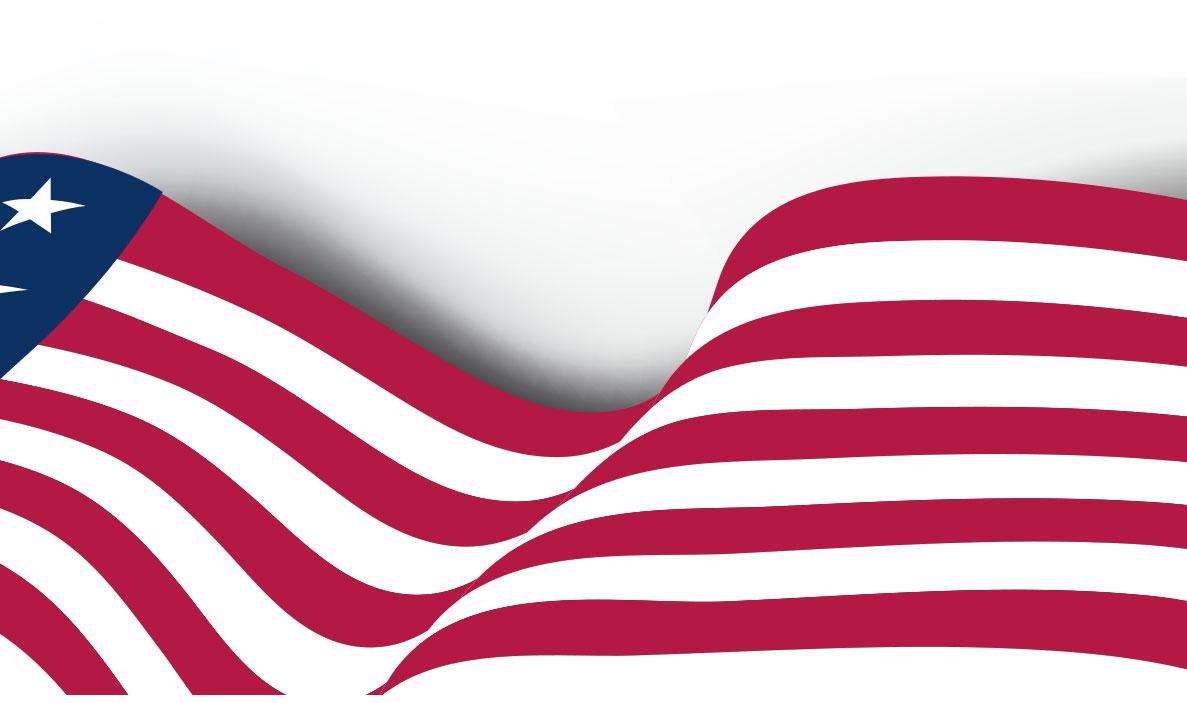
The Riverview Ballroom, site of the AFSA44 Awards Party, takes advantage of the amazing views of the Potomac River.
Enjoy a lively atmosphere, delicious food, and refreshing drinks while you bowl during AFSA44’s Opening Party.
PROPOSED UPDATES TO NFPA 14, 2027 EDITION
STANDPIPES AND HOSE SYSTEMS
KEVIN HALL, M.ENG., P.E., ET, CWBSP, PMSFPE | AMERICAN FIRE SPRINKLER ASSOCIATION
The 2024 edition of NFPA 14, Standard for the Installation of Standpipe and Hose Systems , featured an entire reorganization and rewrite, which was the most substantial change to the document since the 1993 edition. You’d think that after such a heavy lift there wouldn’t be much to change, but that’s where you would be wrong. The standard development process is never complete, and there will always be a need to update and improve the document to reflect new technologies and address issues that were overlooked in the previous revision cycles—or fix the things we screwed up! For the 2027 edition, the committee is considering several new concepts and clarifications. It should be noted that the changes noted in this article are proposed first revisions and have not been officially balloted by the committee. They must still go through the remainder of the revision cycle process before they are officially published in the 2027 edition.
STANDPIPES AND HOSE SYSTEMS
The scope of NFPA 14 has historically included requirements for standpipes and hose systems, but when users go through the document, they typically find themselves asking, “What is a hose system?” The 2027 edition should now address that concern by defining the term “hose system” and globally modify the document to clarify that Class II standpipe systems are actually Class II hose systems. FR-114 defines a hose system as follows:
3.3.x Hose System. A system that provides hose stations to supply water used by trained personnel during initial response and are designed for basic defensive fire control or extinguishment in the incipient stage of fire containment.
The main distinction between a standpipe system and a hose system is when the systems are intended to be used by trained personnel or the fire department and what stage the fire is in at that time. Hose systems are intended to be used by trained building occupants and are ready to tackle a fire at its incipient stage, while standpipe systems are intended for use by trained firefighters for the purpose of structural firefighting. This is why Class I standpipe systems require 250 gpm at 100 psi up to 175 psi or higher depending on the pressure rating of all
equipment for the most remote hose connection, while Class II hose systems only require 100 gpm at 65 psi with a maximum of 100 psi.
PNEUMATIC PRESSURE
Not all changes made to the standard are on the cutting edge of new technology; some are simply pedantic but are necessary to increase the intent and clarity of the requirements of the document. One global change that is poised to be incorporated in the next edition of NFPA 14 is the clarification that air pressure should be referred to as pneumatic pressure. This is the cleanest way to address some historically convoluted requirements in the standards. Every cycle, committee time and energy are spent on answering the question, “What is air?” Is nitrogen gas air? Can other inert gases be used as air? Obviously, yes, these are all air, but because codes and standards require specificity in language, we must clarify that when we say air in the standard, we mean all these things. For the next edition, instead of listing all these items for air pressure, the committee intends to simply identify air under pressure as pneumatic pressure.
LISTING REQUIREMENTS
It should be no surprise to users of NFPA 14 that all devices and materials used in standpipes are required to be listed, with a few exceptions. Those exceptions include components not affecting system performance, automated inspection and testing equipment, and pipe, tube, and fittings meeting product specifications recognized by the industry. There is a tendency to want to slap the “listed” tag on every section to reinforce the overarching requirement, but often, that adds more confusion—especially when it is missed and the intent of the committee is called into question. To address this, the committee added annex language to section 7.1.2 that provides examples of product standards that are appropriate for determining compliance with the official definition of listed and should alleviate the need to clog the body of the standard with an alphabet soup of UL and FM standards. One product standard to note is UL 1450, Motor-Operated Air Compressors,
Vacuum Pumps, and Painting Equipment. Recently updated, this standard now requires air compressors listed for fire protection to meet specific requirements detailed in supplement SC, including permanent connections for hardwired power connection, increased pressure testing to five times the maximum relief valve setting, requirement for a pressure relief valve as the only means to relieve pressure, and durability testing under rated load for 100,000 cycles. Listed air compressors for sprinkler systems will be marked “This Air Compressor Has Been Evaluated for Fire Sprinkler Use According to UL 1450, SUPPLEMENT SC,” and compressors that are not tested to the SC Supplement cannot imply suitability for use in sprinkler systems. With the adoption of these new requirements, UL will review the catalog of listed air compressors, and we should see updates to the manufacturer’s literature within the next year to comply with the new requirements.
THREAD PROTECTION
In the last cycle, the topic of thread protection became a controversial topic as it dredged up safety concerns involving the fire service, standpipe operations, and excessive pressure. The proposed changes in FR-18, FR-19, and FR-20 require hose threads to be protected with a cap—thread donuts would no longer be acceptable. In addition, there was concern from the fire service that if a valve was left open and the hose valve was pressurized between the gate and the hose connection, the cap would be difficult to remove and potentially pose a safety
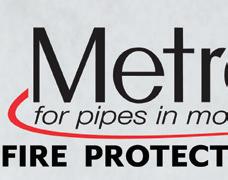
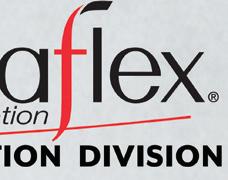

risk. To combat this risk, all hose connection caps will be required to have a nominal 1/ 4-in. hole to dissipate pressure, and if the building owner, fire service, and fire code official elect to use lockable caps, they would need to be listed.
DRY STANDPIPES
For dry standpipes, there are two changes worth mentioning. The first is the supervisory air requirement. For all dry standpipes—manual, automatic, and semiautomatic— supervisory air is required to be maintained on the system. The specific pneumatic pressure for supervisory air is determined by the valve manufacturer for automatic dry standpipes that use a listed dry pipe valve, and for manual dry standpipes, the pneumatic pressure would be based on the manufacturer’s instructions for the pressure switch. The charging language in the section still requires at least 7 psi and no more than 20 psi, but those benchmarks are essentially moot once you take the manufacturer’s instructions into consideration.
The air maintenance device also needed to have its requirements updated. Since most of the air supply language has been extracted from NFPA 13, Standard for the Installation of Sprinkler Systems , some of the requirements for sprinkler systems do not correlate with standpipe systems when you consider the overall operation of the system. For a sprinkler system, the air maintenance device includes a restricted orifice that is intended to limit the air flow into the system so that the
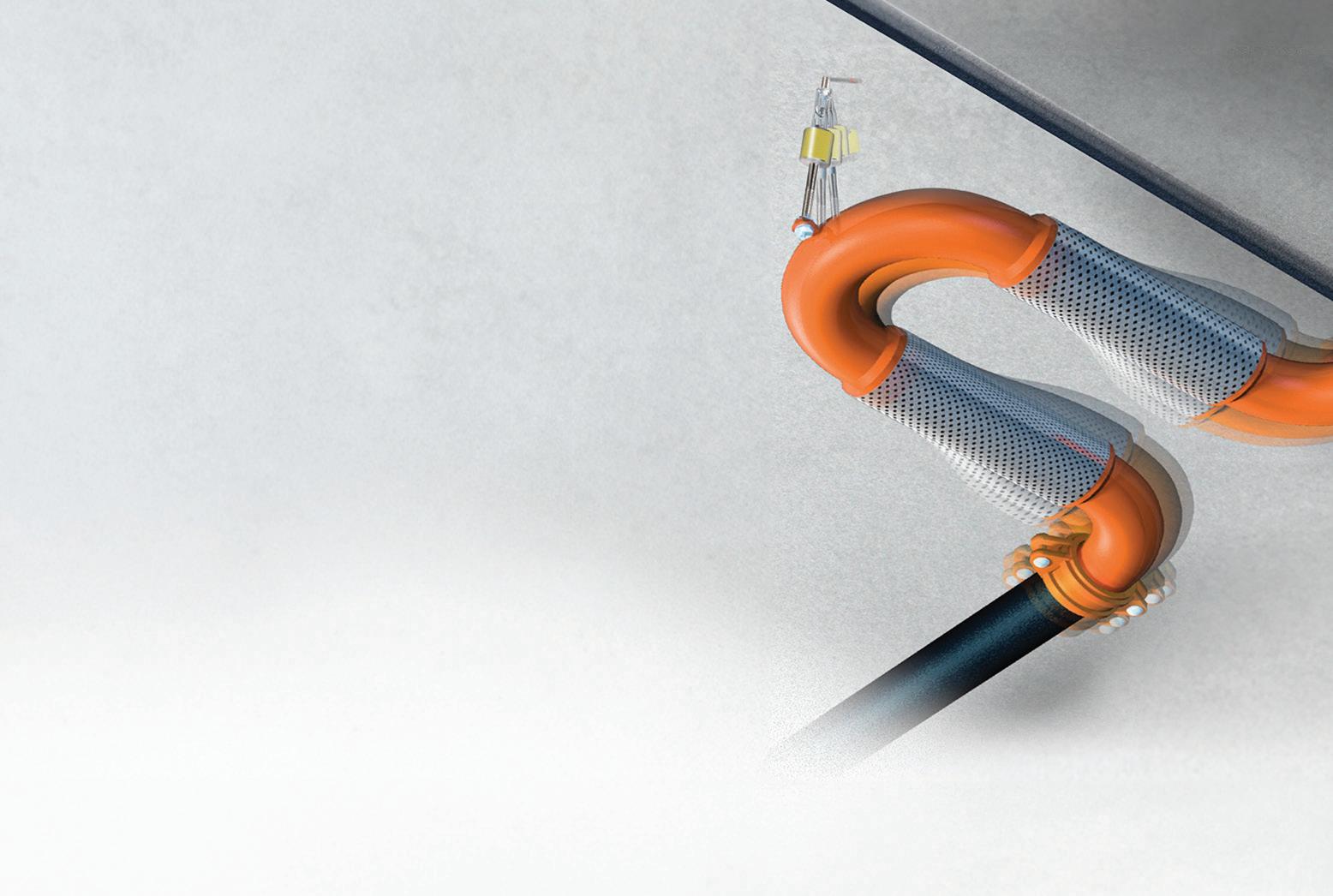




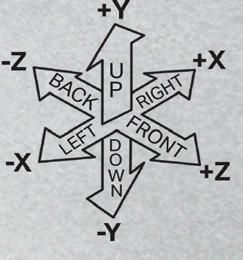








air compressor cannot keep up with the loss of air through a single sprinkler. For a standpipe system, a reasonably sized compressor should not be able to keep up with the losses through a 2 1/ 2-in. hose valve. Based on that logic, the air maintenance device is no longer required for a single standalone standpipe system—combined sprinkler/standpipe systems and multiple standpipe systems supplied by a single air supply would still require air maintenance devices.
MASTER PRESSURE-CONTROL VALVE ASSEMBLIES
When dividing a building up into vertical standpipe system zones, there are many different configurations that the designer can choose to comply with the minimum and maximum pressure requirements in NFPA 14. Each zone can be supplied from a municipal supply, a separate fire pump, separate discharge outlets from a multistage, multiport fire pump, or water storage tanks. For the 2027 edition, FR-60 adds two more options to this list—pumps arranged in series and master pressure-control valve assemblies. These two options were implicitly permitted through annex language but are not specifically stated in the body of the standard.
A master pressure-control valve assembly is a new defined term to describe the arrangement required to regulate pressure in a vertical standpipe system zone.
3.3.X Master Pressure-Control Valve Assembly. A series of pressure-control valves installed to regulate pressures of two or more hose connections.
These pilot-operated valves maintain a constant outlet pressure that improves the efficiency of the arrangement and minimize the number of required vertical standpipe system zones in a building. Previously, any pressure-regulating device could be used in this configuration, but FR-59 now specifically requires pressure control valves to be used. (See Figure 1.)
ACCEPTANCE TESTING
The last topic of note is acceptance testing. Changes in Chapter 12 include additional requirements for developing hydrostatic and pneumatic test plans, as well as annex language to clarify flow testing procedures for the different types of standpipe systems both with and without pressure-regulating devices. This language was developed by a task group of AFSA’s Technical Advisory Council (TAC) chaired by Eric Rieve, and the full text can be reviewed by accessing FR-79.
NEXT STEPS
The public can review topics of concern by navigating to nfpa.org/14next and accessing TerraView by clicking on “View Public Input Online.” The official first draft report will be available for public review after the proposed first revisions are balloted by the technical committee. Once published, the public can comment on the report up until the public comment closing date of January 6, 2026. n
ABOUT THE AUTHOR: Kevin Hall, M.Eng., P.E., ET, CWBSP, PMSFPE, is the director of engineering for the American Fire Sprinkler Association (AFSA). He is a member of several National Fire Protection Association (NFPA) technical committees responsible for developing the model codes and standards, including NFPA 1 Fire Code, NFPA 13/13R/13D Installation of Sprinkler Systems, NFPA 20 Installation of Stationary Fire Pumps for Fire Protection, NFPA 25 Inspection, Testing, and Maintenance of Water-Based Fire Protection Systems, and NFPA 200 Hanging, Bracing, and Anchorage of Water-Based Fire Protection Systems. He also represents AFSA on numerous UL technical committees responsible for revising and maintaining the product standards used in the sprinkler industry. He is a registered professional engineer in Delaware and Maryland, NICET III certified in water-based system layout, a certified water-based system professional through NFPA, and a professional member of the Society of Fire Protection Engineers (SFPE). He earned his Bachelor of Science and Master of Engineering degrees from the University of Maryland College Park in fire protection engineering. In 2021, he was recognized as one of SFPE’s “5 Under 35” award recipients. Prior to his association and committee work, Hall worked for Reliance Fire Protection in Baltimore, Md., as a project manager overseeing projects of various sizes and complexity.
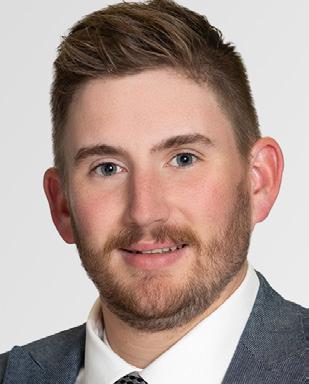
Figure 1. Master pressure control valve assembly diagram.
AHJ S IN ACTION
AFSA44 OFFERS FIRE SERVICE EDUCATION, NETWORKING, AND LUNCH!
AFSA44: Convention, Exhibition, and Apprentice Competition, to be held October 15-18, 2025, at the Gaylord National Resort & Convention Center in Washington, D.C., will feature a fully packed day of education, technology, and networking designed specifically for Authorities Having Jurisdiction (AHJs), and it’s free to attend! This annual event is attended by fire sprinkler contractors, manufacturers, suppliers, designers, and fire officials from around the globe. Join AFSA on Friday, October 17, for informative seminars, a networking lunch, an informative and entertaining General Session, and a packed exhibit hall!
Seminars tailored to suit the AHJ will be offered on Friday morning and include the following:
• Is It Engineering or System Layout?: With the increasing complexity of the protection criteria needed for the evolving types of buildings and contents, contractors frequently encoun ter instances where the prescriptive solutions found in NFPA 13 are not sufficient. This seminar discusses the ongoing debate regarding the need for designs to be “sealed” by a professional engineer. Additionally, with the complexity of hazards and buildings, the question of liability for design decisions comes into question when systems do not perform adequately. Finally, the need for performance-based design is increasing. Therefore, the question for contractors is, “How do I decide when an engineer is needed?”
• Fire Service Demand Tariff: Why are those who install fire sprinklers financially penalized by water utilities through “stand-by” fees, when such systems save the water utility money? The fact of the matter is the current system is patently unfair to building owners who have invested installed fire sprinklers, whether voluntarily or by code requirements. Fixed protection generally beats fire department response. Standby fees are based on the size of the meter: the larger the meter, the greater the property owner pays. This program proposes an alternative by suggesting a new system, providing for the equitable distribution of cost in accordance with demand.
After a full morning of education, enjoy a complimentary networking lunch. Then, AHJs are invited to attend the General Session, which features AFSA’s leadership, National Apprentice Competition finalists, and award presentations.
End the day with entry into AFSA44’s Grand Opening Exhibi tion. Hosted by AFSA Chair of the Board Linda Biernacki, president, Fire Tech Systems, Inc., Shreveport, La., this event offers the first chance for attendees to tour the exhibit hall and enjoy complimentary hors d’oeuvres.
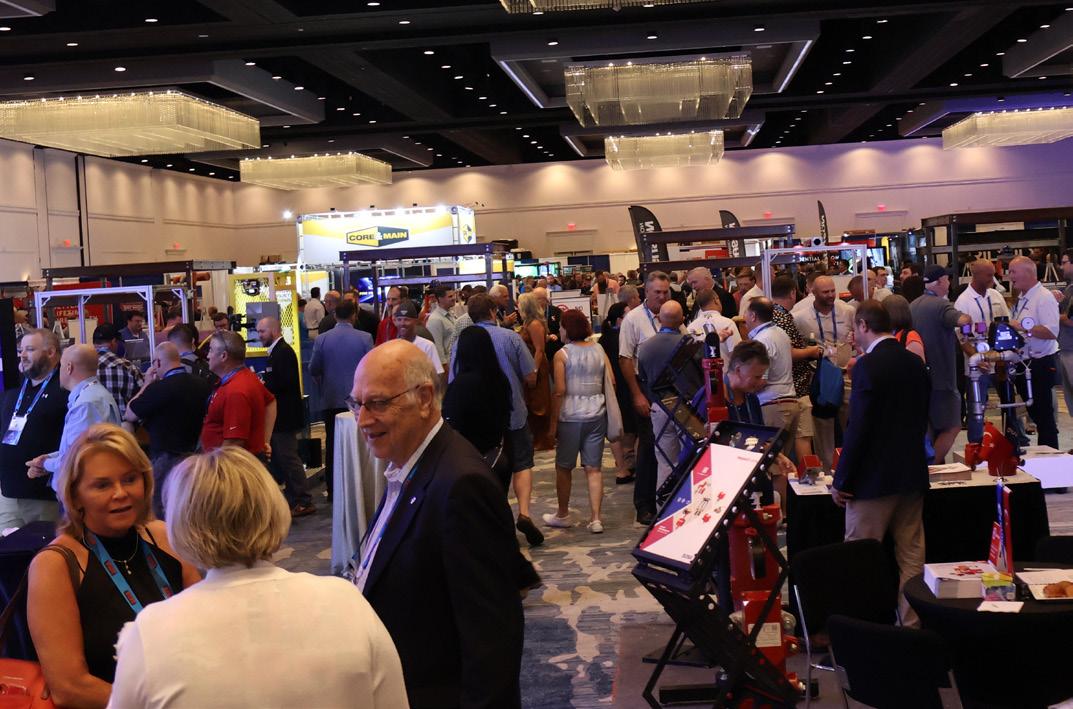

AFSA offers training and networking for AHJs at AFSA44.
AHJs are also invited to attend a second day at AFSA44 with the popular “Ask the Experts” panel discussion and an additional pass to the exhibit hall on Saturday, Oct. 18, which will also feature the 32nd Annual National Apprentice Competition in action. Come cheer on the best fitters in the nation and bring your staff and colleagues— entry into the second day of exhibits are
All of these events are parking costs to attend are not included.) To learn more and register, visit firesprinkler.swoogo.com/afsa44live/AHJDAY and use promo code AHJ DAY.
AHJ Days at AFSA44
Friday, 10/17
7:00 am – 8:30 am 7:00 am – 6:00 pm 8:00 am – 11:30 am
11:30 am – 1:00 pm 1:15 pm – 2:45 pm 3:30 pm – 7:00 pm
Saturday, 10/18
7:00 am – 8:30 am 7:30 am – 3:30 pm
8:00 am – 11:30 am
11:30 am – 1:00 pm 12:30 pm – 3:30 pm

YOUNG PROFESSIONAL OF THE YEAR: MADISON WOLF
LEADING WITH VISION AND DEDICATION
CLARISSA
RIOS | AMERICAN FIRE SPRINKLER ASSOCIATION
Madison Parsons Wolf, regional sales manager at Victaulic, has been named AFSA’s NextGen Initiative’s (NGI) 2025 Joe Heinrich Young Professional of the Year (YPY). Wolf has distinguished herself not only through her sales performance but also through her commitment to empowering the industry and the next generation. “There are so many deserving people in our industry that could’ve won this award,” she shares. “I’m very thankful to those who nominated me and have supported me over the years.”
“Madison could not be more deserving of this award,” comments Katie Meehan, director of marketing, VSC Fire & Security, Inc., Richmond, Va., and chair of NGI. “Her ability to connect with folks and welcome them into this industry is unmatched. Over the last seven years, I’ve watched her connect individuals across generations and coasts to best serve the industry. She’s never afraid to volunteer and roll up her sleeves to get the work done herself. Madison’s unparalleled work ethic and technical knowledge are truly impressive. The sprinkler industry is lucky to have Madison Wolf.”
SPEARHEADING HER SUCCESS
Wolf was eager to dive into her career after graduating from East Carolina University in 2016 with a degree in marketing and a focus on sales. She was interested in the construction field and wanted to work in B2B. Growing up, she had no intention of joining the sprinkler industry until she reached out to her father, Bernie Parsons, who works in sales at Wayne Automatic Fire Sprinkler, to explore career opportunities. “I knew of the industry from my dad, but I never expected to go into it,” Wolf explains. “I found myself interviewing with fire sprinkler manufacturers, and I’ve been on the manufacturing side ever since.”
Wolf started her career at Globe Fire Sprinkler, which was acquired by Victaulic in 2019. She started at Victaulic as a fire sprinkler sales specialist, and through hard work and adamant passion to propel the industry forward, she has recently been promoted to regional manager of North and South Carolina. Wolf takes pride in this achievement as a sales professional, and as a woman leveling up in a male-dominated field. “This promotion is something I’m really proud of, and I’ve proved myself through sales over the years. I’m so grateful for the colleagues, customers, and mentors who continue to support me.”

AFSA’s NextGen Initiative is honored to present Madison Parsons Wolf, with its 2025 Joe Heinrich Young Professional of the Year Award.
HARMONY IN LEADERSHIP AND LIFE
Company acquisitions can bring uncertainty for employees. But for Wolf, joining Victaulic through an acquisition was a positive transition. “I was welcomed with open arms. You never truly know what an acquisition is going to look like, but Victaulic made the transition seamless. Joining a company with outstanding leadership, stellar selling professionals, and a team that focuses on product innovation has continued to allow me to grow and advance my career.” Currently, she manages a team of three in the Carolinas and focuses on sales strategy across distributor and contractor networks.
Wolf’s impact goes well beyond sales. Since 2022, she has worked on the NextGen national board, and she’s played a pivotal role in spreading awareness about the industry to young professionals at a local and national level. Wolf is heavily involved in her local
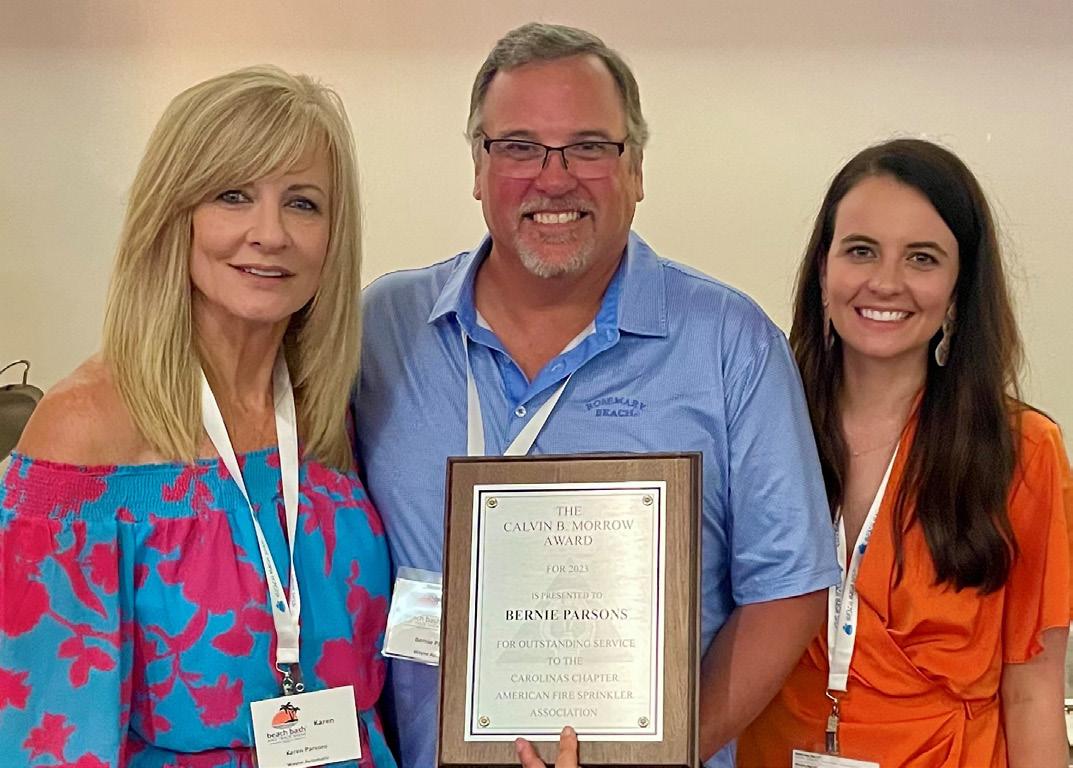

AFSA chapter. She has held multiple board seats and served as the local NextGen chair for the North Carolina Fire Sprinkler Association of AFSA (NCFSA). She also aids in maintaining NCFSA’s social media presence and is the contact for promoting chapter updates across their channels. For more information on the North Carolina Chapter, visit ncfiresprinkler.com.
Already a woman of many hats, Wolf is not only a beloved figure in the industry but also at home with her husband, Brandon Wolf, and their son, Beckett. As a proud working mom, she balances the demands of a thriving career with the responsibilities of family life. “It’s not always easy, but being a working mom has made me more focused and even more appreciative of the support around me. I’m thankful for the village I have created that allows me to continue to be a committed mom and have a successful career.”
CHAMPIONING THE NEXT GENERATION
Wolf has spearheaded NextGen for NCFSA and involved more young people in the chapter. One standout initiative is the chapter’s annual Beach Bash, a three-day networking and tradeshow event. “It’s a fun event! Just being at the beach, seeing customers, friends, and competitors all together. I encourage attendees to bring young professionals; we host a NextGen happy hour during the event that’s always well attended.”
Wolf continues to promote the industry to the next generation. At the national level, she utilizes her local experience with a “grassroots” approach that helps connect the national vision with local execution. “I’ve brought a lot of my local experience to the committee. The struggles we face at a local level help to bridge the local to national gap.”
“I couldn’t be prouder of Madison,” says Hunter Brendle, Brendle Sprinkler Company, Inc., Montgomery, Ala. “She pours so much heart, dedication, and passion into everything she does, and this award couldn’t be more well-deserved. What makes her truly stand out isn’t just her work ethic, but how genuine, kind, and grounded she is. It’s incredibly rewarding to see AFSA recognize the remarkable person we’ve always known her to be and beyond proud to call her a customer, peer, and friend.”
ADVICE FOR YOUNG PROFESSIONALS
When asked what advice she would give to young people looking to join the industry, Wolf remembers, “When I first started, someone told me to get involved with AFSA and its chapters. That advice made all the difference. One of my first missions as a salesperson was to go out and meet chapter executive directors and attend local events. As a young salesperson, that advice helped me form relationships that would’ve taken so much longer to develop.”
She advises seizing every opportunity that comes your way. “So many people want to see you succeed in the industry. Find those people and hold them close. Say yes to every opportunity you’re given. Meet as many people as possible, learn the product, and really embrace the people because they are what make the industry what it is!” She credits much of her journey to her past and current colleagues and mentors for all the support and encouragement and opportunities over the years.
For any women looking into the industry, Wolf encourages them to know what they’re getting themselves into. “There are many rooms I walk in, and I’m the only female in the room. There are different challenges I face. I have to do things a little differently.” She is comforted in the fact that the industry is “accepting and encourages success for people who are joining this industry.” Wolf acknowledges the evident age and gender gap but is excited for the future and eager to see more women and young people get involved. Her drive, leadership, and vision for the future inevitably elevate the industry and pave the way for the next generation.
HONORING 10 YEARS OF YOUNG PROFESSIONALS
This year marks the tenth annual Joe Heinrich YPY award, presented by AFSA’s NGI. The award recognizes the outstanding talent and achievements of sprinkler industry professionals aged 40 and under. It also seeks to promote the emergence of new talented professionals and inspire companies to invest even more in the development and excellence of the profession.
The award will be presented to Wolf during the general session at AFSA44. Learn more and register to attend at firesprinkler.org/ AFSA44. For more details on the NextGen Initiative, visit firesprinkler.org/nextgen. n
Wolf’s parents, Karen and Bernie, brought her up in the industry she has also grown to love.
Wolf is grateful for her village, including her husband, Brandon, and their son, Beckett.
THE IMPORTANCE OF ITM OF STANDPIPE SYSTEMS
LOOKING THROUGH THE LENS OF PAST LOSSES
ERIC ANDRESEN, WBITM | AMERICAN FIRE SPRINKLER ASSOCIATION
In the world of fire protection, the reliability of standpipe systems, hose valves, and pressure-regulating hose connection devices (pressure-reducing and pressure-restricting hose valves (PRVs)) is critical. The standpipe system serves as a vertical water supply for the fire department to aid in manual firefighting efforts. The proper inspection, testing, and maintenance (ITM) on these systems can mean the difference between the fire department successfully being able to fight a fire, achieve containment, and eventually extinguish the fire and catastrophe resulting in significant property damage, potential loss of the building, and, worse, the potential for the loss of lives of building occupants and first responders. While fires in high-rise buildings are inherently dangerous due to vertical travel, egress challenges, and access challenges, history has repeatedly shown that inadequate ITM of standpipes, hose valves, and PRVs can turn manageable incidents into deadly disasters. NFPA 25, Standard for the Inspection, Testing, and Maintenance of Water-Based Fire Protection Systems, underscores these critical responsibilities. However, the consequences of neglect have long been evident in tragic, high-profile fires.
A review of past fire tragedies such as the One Meridian Plaza fire (1991), the First Interstate Bank fire (1988), and the Cook County Administration Building fire (2003) illustrates the grave consequences of failing to properly inspect, test, and maintain these standpipe systems and components.
ONE MERIDIAN PLAZA FIRE – 1991
This devastating 12-alarm fire in Philadelphia burned for nearly 19 hours in a 38-story office building. Firefighters encountered multiple challenges, but chief among them was the failure of standpipe hose valves to deliver adequate water pressure. Water pressure was low and inconsistent as pressure-reducing hose valves throughout the building were improperly set for the locations they were serving. The hose valves failed to deliver adequate flow, undermining suppression efforts and forcing them to abandon the upper floors. Poor maintenance, combined with a lack of inspections and testing of these valves, severely limited suppression efforts, leading to the deaths of three firefighters and the destruction of eight floors. Key Lesson: Inoperable or improperly adjusted hose valves and PRVs can severely compromise firefighting operations during critical early response stages.
FIRST INTERSTATE BANK FIRE – 1988
Despite being one of the tallest buildings in Los Angeles, the structure lacked sprinklers and had known issues with its standpipe system. The Los Angeles Fire Department put up a heroic effort; however, firefighters reported low or inconsistent pressures at hose outlets, believed to be due in part to malfunctioning or misadjusted PRVs. The problems with the hose valves compounded the difficulty in containing the fire on the upper levels of the building. The fire caused $50 million in damages and highlighted the importance of ITM of the hose valves and pressure regulating hose valves in tall buildings. Key Lesson: Standpipe valves must deliver reliable, properly regulated pressure to support manual suppression.
COOK COUNTY ADMINISTRATION BUILDING FIRE – 2003
Here, standpipe system deficiencies again come to light. Firefighters struggled with accessing operable hose valves, and post-incident investigations noted inadequate ITM practices. Though the hose valve malfunction was not the primary cause, firefighters struggled with system operations, including accessing and using pressure-reducing hose valves in stairwells. Six civilians died due to smoke inhalation while trapped in a stairwell, underscoring how hose valve failures can also indirectly contribute to occupant fatalities. The incident led to major fire code reforms in Chicago. Key Lesson: Poor valve access, improper or inadequate ITM of hose valves, and a lack of familiarity with the systems by the fire department can lead to a delay in getting water on the fire and contributing to loss of life and property.
ITM GUIDANCE
NFPA 25 provides clear guidance for ITM of standpipe systems, hose valves, and hose connection pressure-regulating devices, aimed at ensuring system readiness and performance. Chapter 6 covers standpipe ITM requirements; however, key ITM activities and system components are also located in Chapter 13. These chapters outline the frequency at which visual inspections need to be performed to assess the key components of these systems for damage, accessibility, and other visual indicators that the system or component may not function appropriately. They also outline the testing that needs to be performed on the components. This testing is performed periodically to simulate the conditions that the component may see in a fire scenario to confirm that it operates and performs as intended. The maintenance sections cover any routine servicing that needs to be performed to keep
ULTIMATE CONTROL
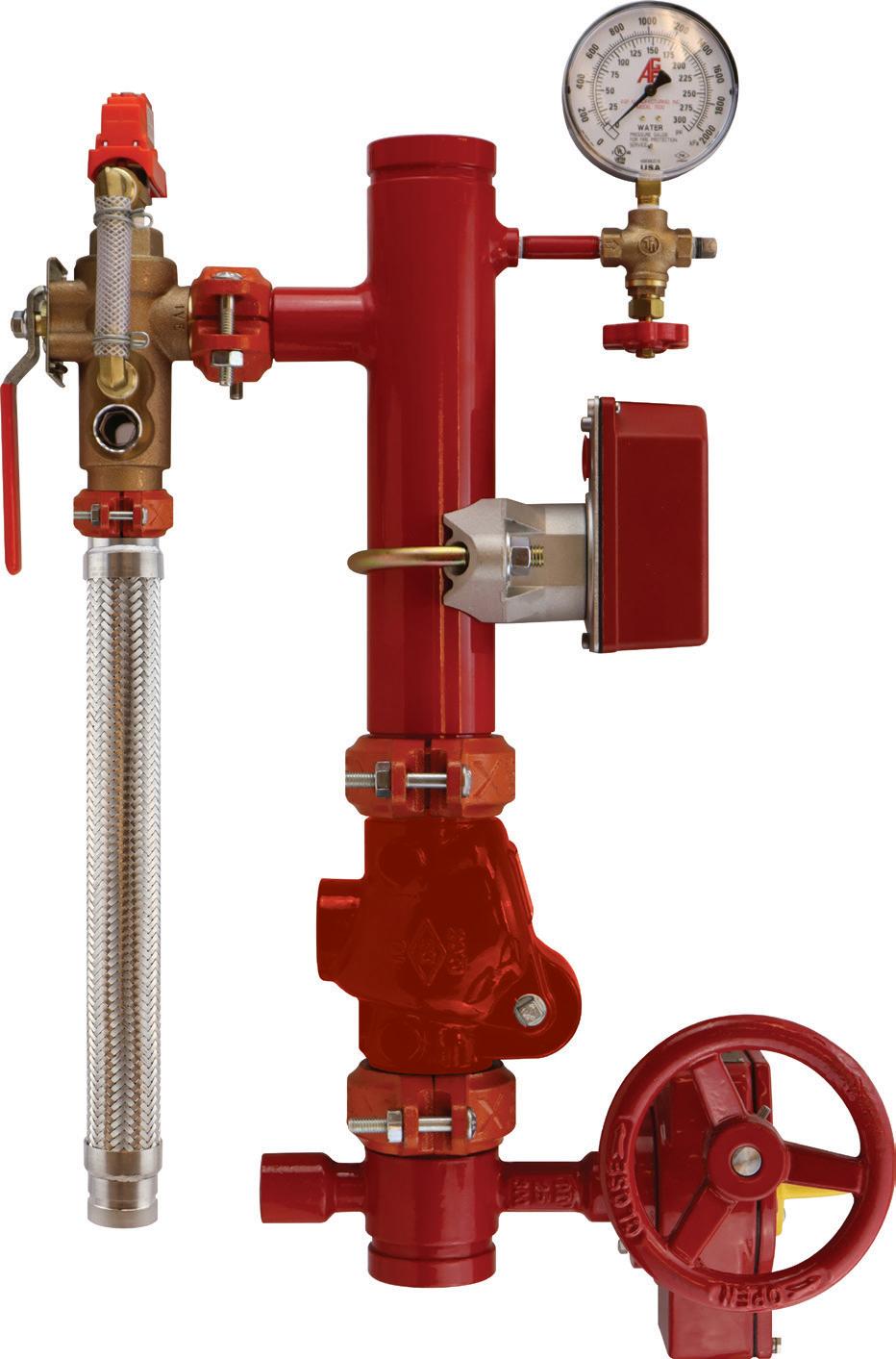
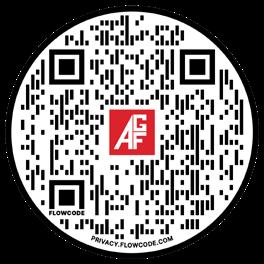

FLOOR CONTROL ASSEMBLIES
RiserPACK Ultimate Floor Control assemblies feature a steel manifold (2”-8”), butterfly valve or check valve (or both), 4” Model 7500 pressure gauge, 3-way universal gauge valve, TESTanDRAIN valve with drain line, waterflow alarm switch, and a Model 7000L pressure relief valve with drain trim. They are the ultimate solution for every floor control.
LEARN MORE

THE FIRE SPRINKLER INDUSTRY IS A HIGH-STAKES MISSION.
These are not your average vendors. They are the 007s of the fire protection game. Covert operatives disguised as manufacturers & suppliers — all sworn to protect your bottom line and advance the mission of AFSA .
THEY DON’T WEAR TUXEDOS. BUT THEY DO DELIVER RESULTS.
MANUFACTURER & SUPPLIER MEMBERS HAVE ONE MISSION: SUPPORTING CONTRACTORS LIKE YOU.
BUY SMART. BUY AFSA.
When it’s time to gear up, contact an AFSA member. These allies fund the fight, back the cause, and equip you with tools built for mission success.
firesprinkler.org/ultimate/
TRAINING & TECH SUPPORT
AFSA’s new lab was outfitted by our Manufacturers & Suppliers. AFSA Training Programs are supercharged by their imagery, innovation, and insight. They’ve embedded the latest tech and donated their time to every lesson, course, and seminar. firesprinkler.org/lab/
CONVENTION OPS
At the AFSA Convention & Exhibition, Associate members work in full force. From immersive booths to tech rollouts and elite sponsorships, these operatives bring the heat — so you stay ahead of the curve. firesprinkler.org/AFSA44/
THE CHAPTER NETWORK
Associate Members aren’t some secret society — they’re embedded in your local chapters. They sponsor your events, share mission-critical insights, and stand shoulder to shoulder with you on legislative and charitable fronts.


DYNAMIC DUO: CONTRACTORS + ASSOCIATES
TOGETHER, WE ARE FASTER. SMARTER. STRONGER.
GROWING YOUR CHAPTER
MID-YEAR CHAPTER LEADERSHIP CONFERENCE BRINGS LEADERS TOGETHER
The American Fire Sprinkler Association (AFSA) brought together chapter leaders from across the country for its Mid-Year Chapter Leadership Conference, May 20-21, 2025. Held at AFSA’s offices in Richardson, Texas, this year’s event provided resources, education, training, and team building activities. “The conference was a great success and an opportunity for AFSA chapter leaders and staff to interact on a wide variety of topics,” comments AFSA’s Vice President of Membership & Chapter Development Meda Merritt, CAE. “It focuses on strengthening leadership skills and fostering meaningful dialogue around the challenges and successes experienced at the chapter level.”
This year’s event kicked off with the Outlaw Olympics—a fun and engaging team-building activity that grouped chapter leaders together to compete in various challenges. These exercises emphasized teamwork, communication, and practical skills. The next day, Matt Verderamo, group director at Well Built Construction Consulting, presented on “Growing Your Chapter” and AFSA staff provided training and updates on chapter-related programs and activities. To round out the conference, a social mixer was held that evening at Pin-stack for a night of bowling and games.
Danielle Fowler, Northeast sales manager at Potter Electric Signal and executive director for the Chesapeake Bay Chapter, says, “I’ve only missed one Leadership Conference since being an executive director, and it felt like I missed out on summer camp with all my friends! The team building and camaraderie that goes on in such a short amount of time is priceless. Every year, I learn something more to help with my chapter, and I’d like to think someone learns from me. My closest friends in the industry came from my AFSA events.”
Coleman Farrar, vice president/division manager, VSC Fire & Security, Van Buren, Ark., and executive director for AFSA’s Arkansas Chapter, comments, “I feel that attending the mid-year conference is extremely important to anyone who leads a chapter, not just the executive director. You can visit with and learn from other leaders who may have already found a good solution to an issue your chapter is facing. Spending time with other leaders makes you feel more comfortable asking for advice or support if needed. Everyone there shares similar interests in making their chapter better, and I have found it to be a very supportive group. I strongly encourage leaders in any chapter to attend. It can be a significant team-building event for the chapter, thus producing an even more effective result.”
Attending this conference exposes chapters leaders to best practices, teamwork, communication, leadership, problem-solving, and different perspectives. It’s encouraged that all chapter leaders make efforts to attend either the Mid-Year or the Convention Leadership Conference. Engaging with other chapter leaders helps to strengthen AFSA and its chapters. To get more involved locally or to find your chapter, visit firesprinkler.org
JOIN AFSA IN DC!
The Fall Chapter Leadership Conference is held annually during AFSA’s convention. Attendees enhance leadership skills, expand their professional network, and gain practical tools to support the growth and success of their local chapters and AFSA members. Mark your calendars for this conference to be held during AFSA44: Convention, Exhibition, and Apprentice Competition, October 15-18, 2025, in Washington, D.C. To learn more, email membership@firesprinkler.org. n
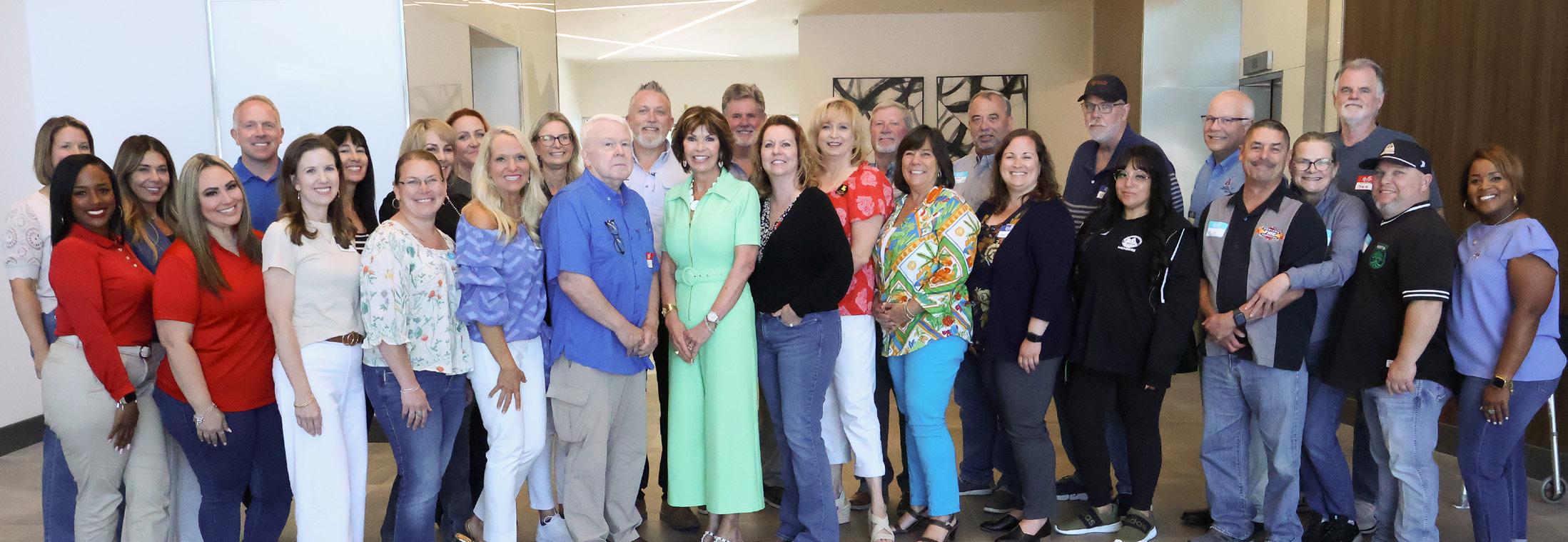
ENGAGING YOUNG MINDS
HIGH SCHOOL STUDENTS LEARN ABOUT FIRE PROTECTION THROUGH UMD FPE FIRE DESIGN CHALLENGE
Attracting, engaging, and retaining the interest of high school students is a challenge, no matter the topic. Scientific matters may pose an even greater challenge. However, the University of Maryland Department of Fire Protection Engineering’s (FPE), Design Challenge seems to have captured high school seniors’ attention and even grown year over year. Its 11th Annual Design Challenge, held in April, was no exception. Eleven high schools and 29 teams competed this year and wowed the judges with their designs and creativity.
This year’s winning team, “The Cinderellas,” came from Elizabeth Seton High School. The all-women group impressing judges with their presentation, well-thought-out system design, and overall performance during the burn test.
Several schools had more than one team compete. The winning teams from each school were “Team 1” from Atholton, “ Team 7” from Bishop McNamara, team “Flowers 1” from Charles Herbert Flowers, team “That’s Totally What We Meant To Do” from DeMatha Catholic High School, team “The Juniors” from Glenelg High School, co-winning teams “Team” and “Team Sand” from Hubert Blake High School, the “Smokin’ Sailors” from Mount de Sales High School, and “Blazers 1” from Notre Dame Prep, team “FireBall” from Old Mill, and team “Flame On” from Woodlawn.
YEAR-LONG LEARNING
Each year, the challenge brings together high school teams from local areas to expose students to basic principles of fire safety engineering, construction skills, and the scientific method. The goal is that participation in the program will boost student confidence in pursuing STEM careers, and the department welcomes excitement to learn about fire protection engineering, a field not broadly known.
Each team must build a system that successfully detects and suppresses a flame in a reduced-scale house model. Early in the school year, teams are formed with small groups of students who are paired with a professional or teacher mentor to begin learning challenge guidelines and review supporting materials provided by the department. Early design and testing of housing models begins in February through competition day in April.
COMPETITION DAY
The Fire Research Laboratory hosts the competition each spring in its facilities. There, each team is given a chance to showcase its prototype in a burn test to demonstrate efficient fire
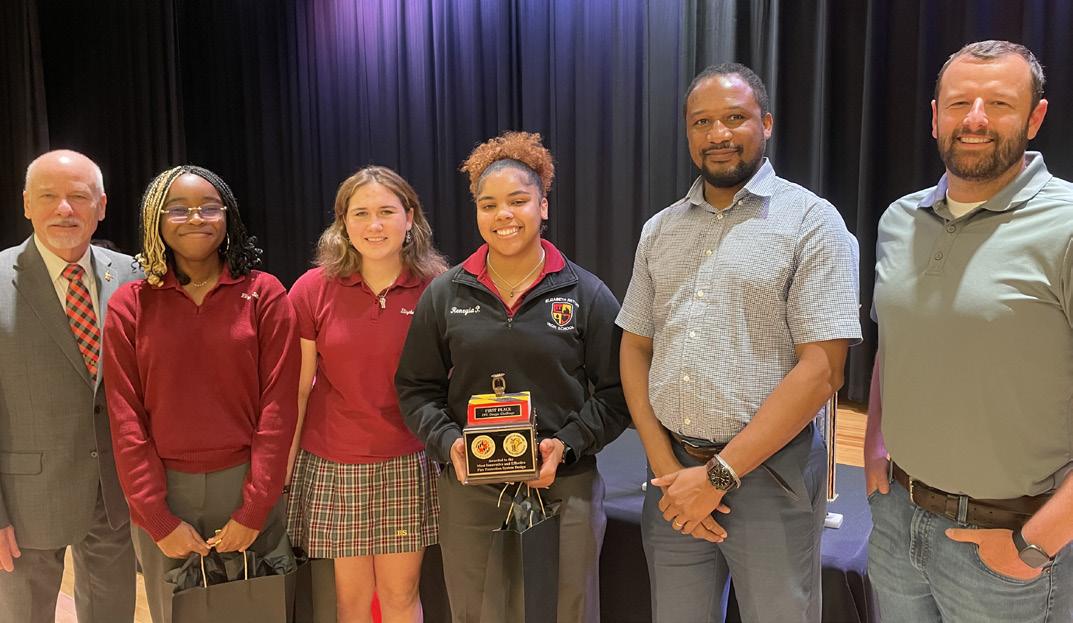
suppression methodologies. The world-class facilities ensure that a safe environment is kept in place for the participants.
Nicole L. Hollywood, UMD FPE associate director for programs, organizes the challenge and is grateful for everyone who comes together to make this event a success. “Our mentors, volunteers, judges, and donors are the reason that this program is such a success! I am so grateful to everyone involved at the schools, from the university, within the fire protection engineering field with all the help that they provide before, during and after this event.”
THE NEXT GENERATION
The American Fire Sprinkler Association (AFSA) has served as the sole sponsor of the Fire Design Challenge for several years and recently increased its support for future competitions. Its annual donation supports the supplies provided to the schools, prizes provided to winning teams, and marketing for the program. This event serves as one way to introduce high school students to the field of fire protection engineering and perhaps recruit bright minds into the field.
“I love attending these competitions,” comments AFSA’s Vice President of Engineering & Technical Services, John August Denhardt, P.E., FSFPE, and alumnus of UMD’s FPE program. “They’re an excellent way to immerse students in the world of fire protection. When I talk to them about their projects, you can see their excitement.”
For more information about the event and the Fire Protection Engineering program at the University of Maryland, visit fpe.umd.edu/FPEDC. n
This year’s winning team, “The Cinderellas,” and their Instructor, Dr. Schadrac Fresnel, were presented with their award by Dr. Trouvé (far left) and Challenge Mentor Chris Fike (far right).
MANUAL DRY STANDPIPES
SUPERVISORY AIR REQUIREMENTS
MARK HOPKINS, P.E., FSFPE | SUMMIT NATIONAL FIRE CONSULTING
The 2024 edition of NFPA 14, Standard for the Installation of Standpipe and Hose Systems , introduced a new requirement for supervisory air to be used on manual dry standpipe systems. Section 8.3.2.1 added a requirement to have supervisory air in all dry standpipe systems. This requirement is in addition to historic requirements in which other types of dry standpipe systems (automatic dry, and semi-automatic dry) already required such supervisory air requirements.
Building and fire codes require automatic wet standpipes as the basic rule, especially when the system demand is in excess of the capabilities of the fire department, e.g. super-high-rise buildings. This means the standpipes are full of water and designed to meet the needed demand flow and pressure. Exceptions are permitted to use manual wet and dry standpipe systems in buildings where the responding fire department has the capabilities to meet the standpipe system demand flow and pressure using the fire department connection (FDC). Manual wet standpipes are used when a water supply is available and the building is heated. Manual dry standpipe systems are used when subject to freezing, or a water supply is either unavailable or unrequired, such as in a parking garage. The reason for this new requirement is to increase confidence in the reliability of manual dry standpipe systems, as historically manual dry systems were prone to the highest maintenance and reliability concerns.
As with many changes to NFPA codes and standards, the initially proposed change is not exactly the same as the text that appears in the standard. For starters,
the standard was reorganized so the section was moved from chapter 5 to chapter 8. Public input 57 to NFPA 24-2024 sought to add a new section 5.2.4 with subsection 5.2.4.1 that would require supervisory air or nitrogen at a pressure between 7 and 20 psi be provided for manual dry standpipe system piping. This new section was intended to follow the requirements for semiautomatic dry standpipes that already existed.
The substantiation for the proposed change discussed skepticism on behalf of the fire service regarding manual dry standpipes. The intent of the requirement was to address the lack of confidence in these systems by the fire service because of concerns regarding the integrity of piping, valves and fittings in these systems. Most fire departments would rather run hose from the exterior of the building through the stair enclosure rather than trust that a manual dry standpipe could be used. This was especially true, and even in some department’s standard operating procedures, for parking deck structures or open exterior balcony mid-rise apartment buildings.
An example of the problem was exemplified in a discussion regarding fire service response to a vehicle fire in a four-story parking garage on a college campus. A manual dry standpipe system was provided in the parking garage and had been in place for a number of years when an alarm signal was transmitted for a vehicle fire. The local fire department was dispatched to the scene and assessed the situation. However, when the fire fighters connected fire hoses between the hydrant, pumper and FDC and began to fill the system with water the system pressure never increased. Inside the garage, water was flowing from nearly every 21/2-in. hose valve rendering the standpipe system

NFPA 14 has a new requirement for supervisory air to be used on manual dry standpipe systems.
useless. Other examples include missing pipes or fittings, and catastrophic failure of fittings, valves or pipes while the fire department is pressurizing the system.
NFPA 241, Standard for Safeguarding Construction, Alteration, and Demolition Operations, 2022 edition, requires testing (4.7.2.1.3) and supervision (section 4.7.4) of temporary and permanent standpipes installed during construction to ensure integrity, and confidence that the system piping is closed and useable. These requirements have been incorporated into NFPA 14, 2024 edition. The following requirements are now in place:
3.3.29 Supervisory Signal Initiating Device.
An initiating device in which the change of state signals an off-normal condition that requires action in connection with guard tours or maintenance of related systems. (72, 2022)
8.3.2.1 Supervisory Air.
8.3.2.1.1 * All dry standpipe system piping shall be supervised with supervisory air.
8.3.2.1.2 Supervisory air shall be maintained at a minimum pressure of 7 psi (0.5 bar).
8.3.2.1.2.1 Supervisory air pressures shall be permitted to be less than 7 psi (0.5 bar) in accordance with the manufacturer’s instructions.
8.3.2.1.3 Supervisory air shall be maintained at a maximum pressure of 20 psi (1.4 bar).
8.3.2.1.3.1 Supervisory air for automatic dry and semiautomatic dry systems shall be permitted to exceed 20 psi (1.4 bar) in accordance with the manufacturer’s instructions for dry pipe and deluge valves.
8.3.2.2.4.1 Maintenance of Air Pressure. Air or nitrogen or other approved gas pressure shall be maintained on dry pipe systems throughout the year. (13, 8.2.6.2)
8.3.2.2.5 * Air Supply.
8.3.2.2.5.1 The compressed air supply shall be from a source available at all times. (13, 8.2.6.3.1)
8.3.2.2.5.2 * The air supply shall have a capacity capable of restoring normal air pressure in the system within 30 minutes. (13, 8.2.6.3.2)
8.3.2.2.6 Air Supply Connection. (13, 8.2.6.4)
8.3.2.2.6.1 The connection from the air supply to the dry pipe valve shall not be less than 1∕ 2 in. (13 mm) in diameter and shall enter the system above the priming water level of the dry pipe valve. (13, 8.2.6.4.1)
8.3.2.2.6.2 A check valve shall be installed in the air filling connection. (13, 8.2.6.4.2)
8.3.2.2.6.3 A listed or approved shutoff valve of either the renewable disc type or ball valve type shall be installed on the supply side of this check valve. (13, 8.2.6.4.2.1)
8.3.2.2.7 Relief Valve.
An approved relief valve shall be provided between the air supply and the shutoff valve and shall be set to relieve pressure no less than 10 psi (0.7 bar) in excess of system air pressure provided in 8.3.2.2.9.1 and shall not exceed the manufacturer’s limitations. (13, 8.2.6.5)
While contractors could assemble off-the-shelf products to satisfy these requirements, the assemblies would be oversized and clunky. New products are
coming to the market to specifically serve this purpose, such as the new SG14 Standguard by General Air Products and others. For more information on this new requirement, visit NFPA’s website, nfpa.org, to view the NFPA 14 and NFPA 241 standards. n
ABOUT
THE AUTHOR: Mark Hopkins, P.E., FSFPE, engineering director and industry liaison with Summit Fire Consulting, is a registered Fire Protection Engineer with over 30 years of experience in the fire protection industry. He has both B.S. (’92) and M.S. (’96) degrees from the University of Maryland, College Park in fire protection engineering. Hopkins has experience as a sprinkler fitter,
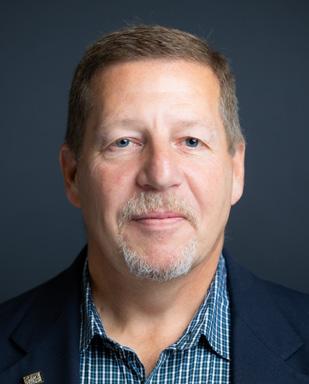
designer, inspector, contractor, and engineer. He is a member of the NFPA 13 (SSI), 30B, 72 (IDS), 200, 909 and 914 technical committees. He is an SFPE International board member, SFPE Fellow, immediate past president of the SFPE Chesapeake Chapter, Maryland State Fire Prevention Commissioner, and an adjunct lecturer for the University of Maryland Department of Fire Protection Engineering. Hopkins has authored many technical articles, newsletters, and other publications.
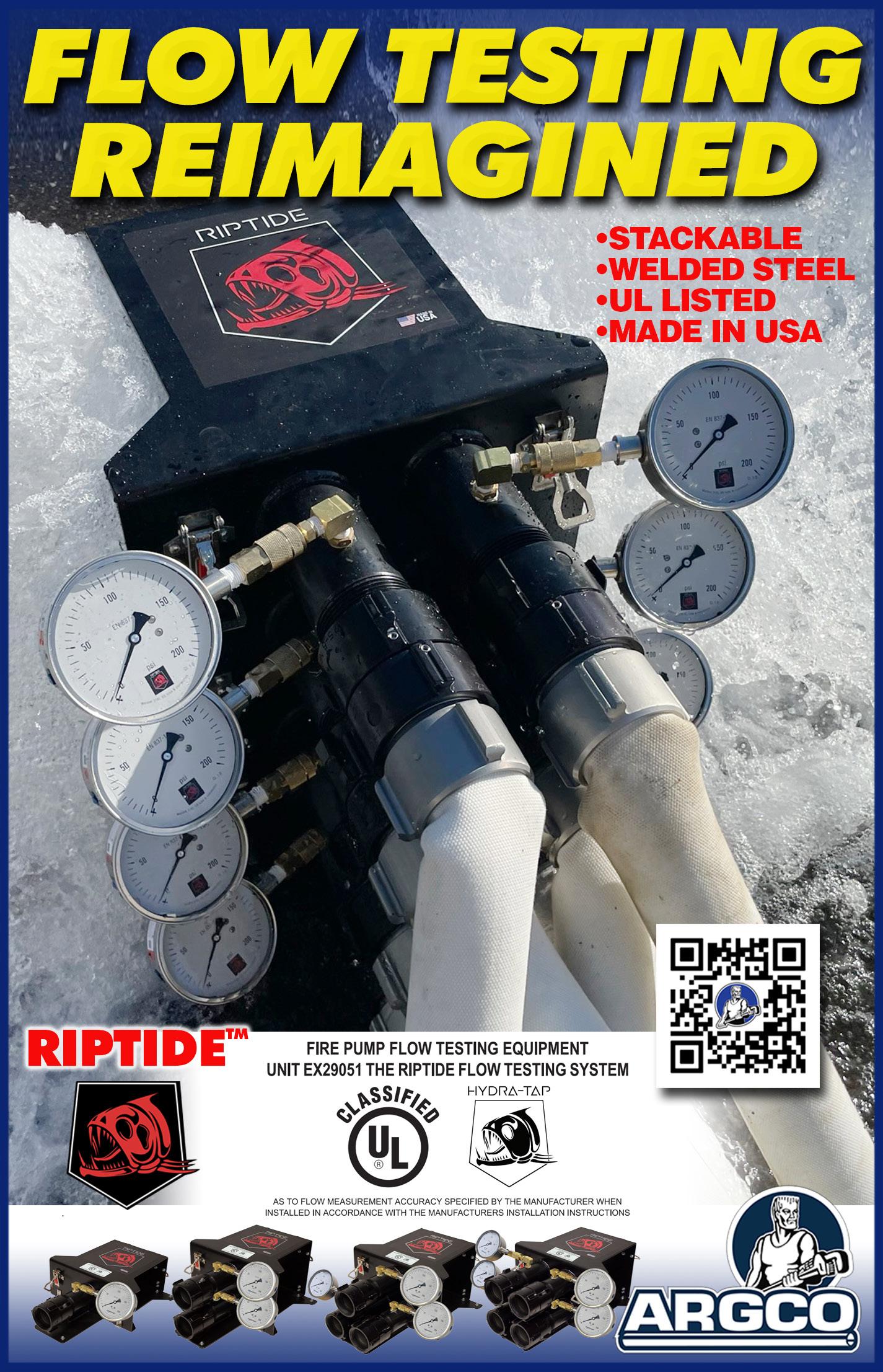
NFPA, HFSC PRESENT AWARDS
LAS VEGAS FIRE & RESCUE AND STOUFFVILLE FIRE & EMERGENCY SERVICES RECOGNIZED
The National Fire Protection Association (NFPA) Fire Sprinkler Initiative and the Home Fire Sprinkler Coalition (HFSC) have awarded the U.S. and Canadian Bringing Safety Home awards to Las Vegas Fire & Rescue and Stouffville Fire & Emergency Services.
This award honors fire safety advocates in North America who diligently promote the importance of home fire sprinklers, use HFSC and NFPA resources to educate decision-makers, and recognize that protecting all new homes could have a tremendous impact on public safety and community risk reduction.
Las Vegas Fire & Rescue was recognized because of their work establishing relationships with the local home builder associations to learn about and address their concerns. The University of Nevada, Las Vegas conducted a cost-benefit analysis and concluded there were significant benefits in protecting all new homes with fire sprinklers. Through collaboration, their efforts led to the Las Vegas City Council approving a sprinkler ordinance in 2019. Since then, more than 18,000 new homes have been built with fire sprinklers protecting residents and firefighters.
Stouffville Fire & Emergency Services was recognized because their team worked closely with their building and planning departments, engaging developers and offering incentives to protect entire developments with fire sprinklers. These incentives, combined with strong advocacy and education, made home fire sprinklers an increasingly attractive option, contributing to safer and more resilient communities. As a result, all new homes in four subdivisions
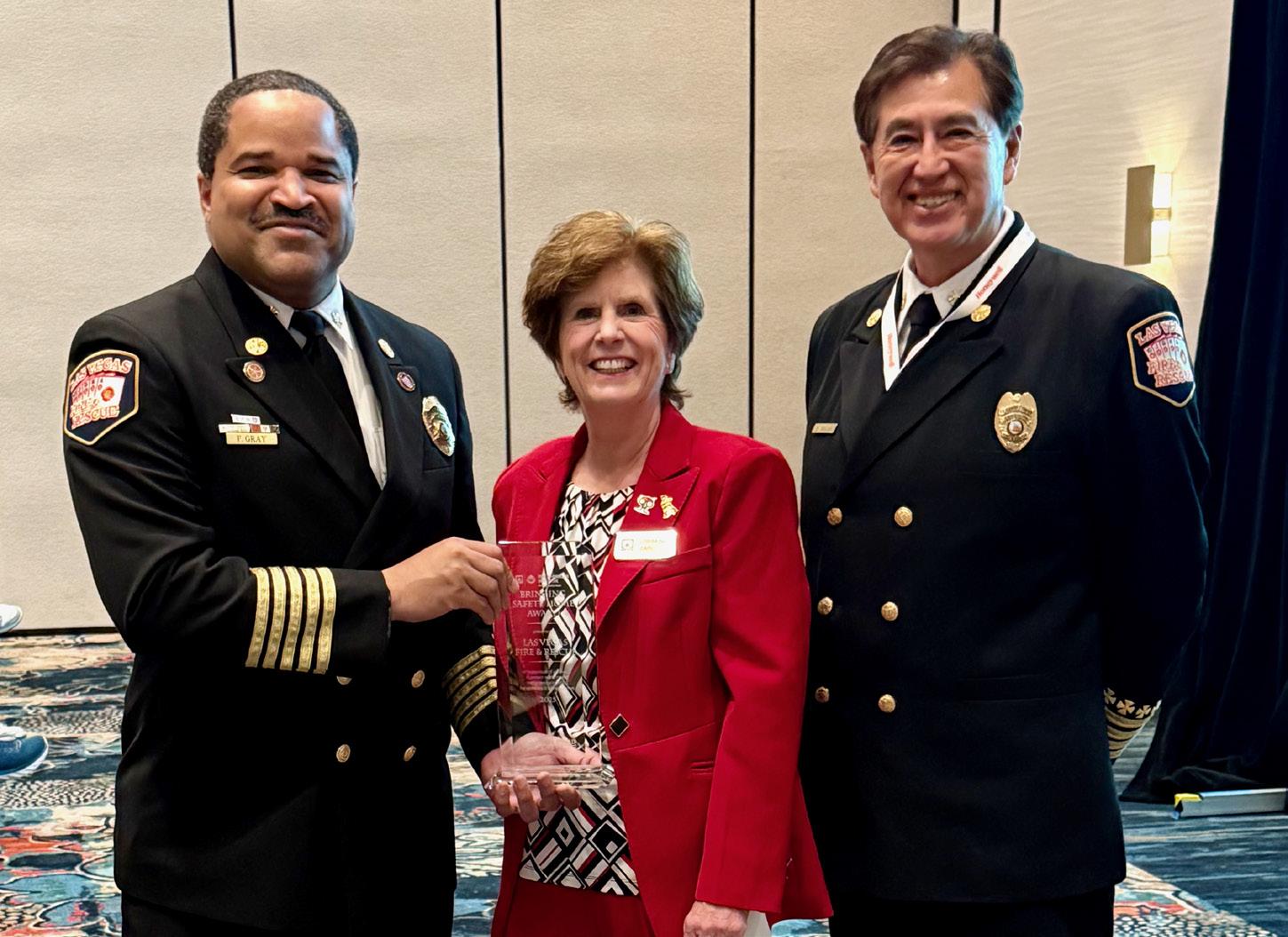
and two future developments will be protected with home fire sprinklers.
“Both fire departments had dedicated teams that understood the challenges and the need to work closely with builders during the early stages and learn about their concerns and how fire sprinklers can benefit all stakeholders,” said Lorraine Carli, NFPA Vice President of Outreach and Advocacy and HFSC President. “Thanks to their efforts, citizens and firefighters will be better protected.”
As recipients of the Bringing Safety Home Award, both fire departments will each receive a $1,000 stipend to support further fire sprinkler advocacy and educational initiatives. n
ABOUT THE HOME FIRE SPRINKLER COALITION (HFSC): For 27 years, HFSC has developed and provided comprehensive, non-commercial, educational resources that highlight the life safety benefits of protecting homes
with fire sprinklers. HFSC’s mission is solely educational and its materials are available to everyone at no cost through HFSC’s website: homefiresprinkler.org. AFSA is one of the founding members of HFSC and serves on its board of directors.
ABOUT THE FIRE SPRINKLER INITIATIVE®: The Fire Sprinkler Initiative®, a project of the National Fire Protection Association, is a nationwide effort to require the use of home fire sprinklers and the use of fire sprinkler requirements for new construction. Visit the Fire Sprinkler Initiative website at firesprinklerinitiative.org.
ABOUT THE NATIONAL FIRE PROTECTION ASSOCIATION (NFPA): Founded in 1896, NFPA is a global self-funded nonprofit organization devoted to eliminating death, injury, property and economic loss due to fire, electrical and related hazards. The association delivers information and knowledge through more than 300 consensus codes and standards, research, training, education, outreach and advocacy; and by partnering with others who share an interest in furthering the NFPA mission. For more information, visit nfpa.org. All NFPA codes and standards can be viewed online for free at nfpa.org/freeaccess.
NFPA Vice President of Outreach and Advocacy and HFSC President Lorraine Carli (center) presented a 2025 Bringing Safety Home award to Fire Chief Fernando Gray (left) and Sr. Deputy Fire Chief Robert Nolan (right), both with the Las Vegas Fire & Rescue (right).
MULTI-USE AFSA PLAYGROUND
RECENT TRAINING HIGHLIGHTS INCLUDE CONTRACTORS, MANUFACTURERS, SUPPLIERS, CHAPTERS, AND AHJS
What began as a state-of-the-art training hub for AFSA programs has evolved into a multi-use facility supporting all aspects of the fire protection industry. The AFSA playground, built to host AFSA’s roster of training courses, is now becoming popular for private bookings. Companies, contractors, fire departments, and even those in the insurance sector have capitalized on the lab’s resources for internal training. The Playground has provided a hands-on environment for training and has seen it wanted across the country to enhance training programs.
“The lab is a great setup and an awesome opportunity to get hands-on and see many things you might not always get to see, whatever your role in your company. I’ll definitely be back for more training,” says Tyler Gibson with BlazeX Sprinkler Corp., who attended a training with AFSA’s DFW Chapter.
WHO’S TRAINING IN THE LAB?
AFSA’s technical team is filling out the calendar between training sessions. AFSA is thrilled to host and support a wide range of training needs across the industry. Some recent events include VSC Fire & Security, Inc., who booked a private fire pump class. AFSA instructors led the course, and participants applied what they learned in the lab.
Hose Monster University delivered product-specific training. Their team led demonstrations and hands-on sessions using their equipment in AFSA’s lab, with AFSA trainers on standby providing support wherever needed.
Verisk Property Solutions used the facility for internal staff development.
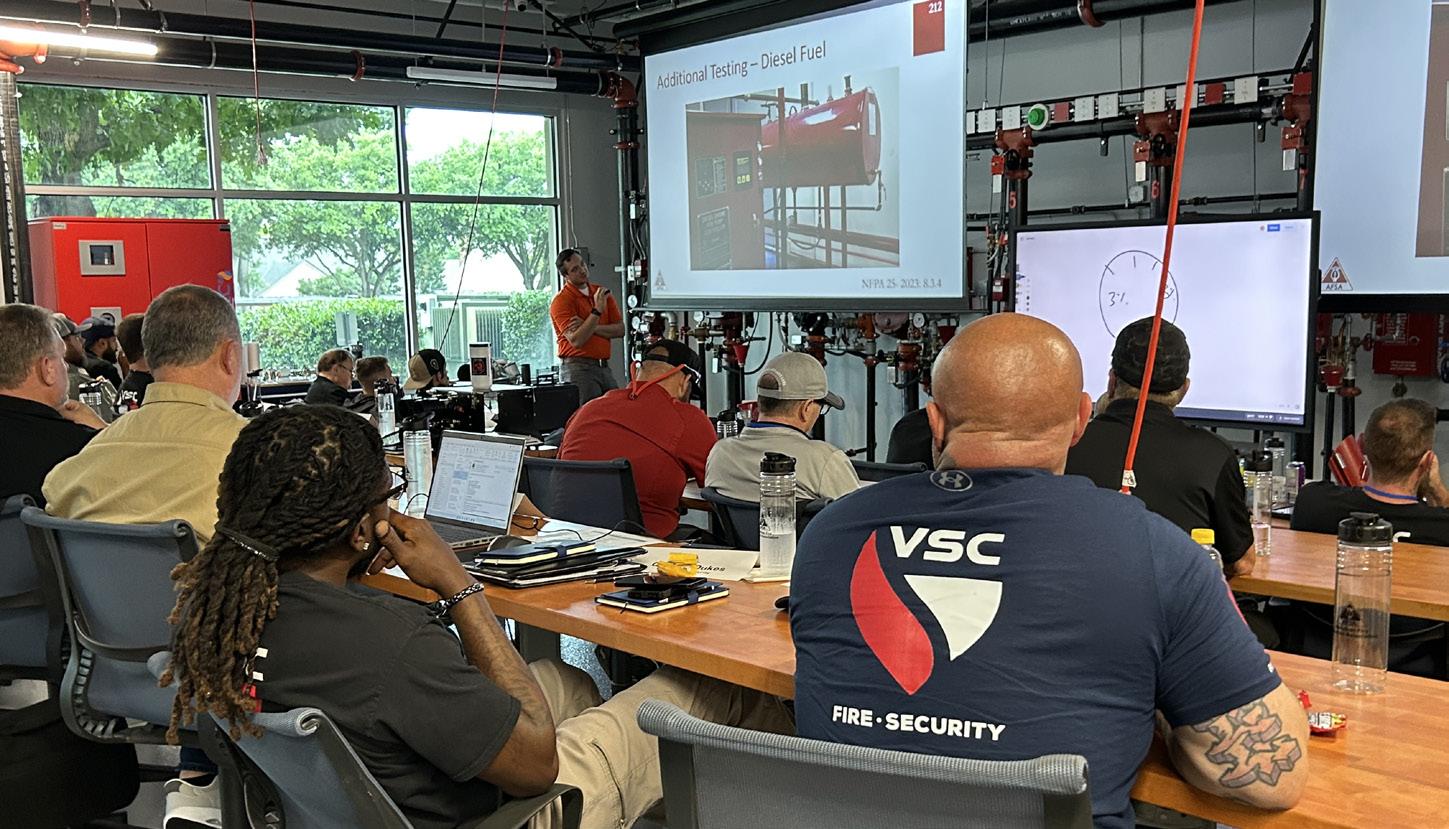
Their team led the instruction, while AFSA assisted with the hands-on portions and provided technical insight.
Local fire departments, such as Dallas and Richardson Fire, are utilizing the lab to familiarize their teams with fire sprinkler systems they’re likely to encounter in real-world emergencies. Their internal sessions covered fire ground operation discussions, how to operate fixed water-based systems, and what to do during a freeze-up.
AFSA’s DFW Chapter recently hosted an advanced crash course focused on ITM practices and clarifying important definitions found in NFPA 25 and its current editions. The session included in-depth discussions on proper sprinkler system inspection, testing, and maintenance procedures. Talon Hernandez with Automatic Fire Protection attended and described the lab as “a cool place for me and other designers to be because it gave me a chance to get hands-on with some of the valves and see how things work compared to how they look on the plans.”
“I’m most excited that we’re using our sprinkler spray demonstration. Being able to show how movable obstructions impact spray patterns brings the NFPA 13 rules to life,” comments Eric Andresen, WBITM, technical training specialist. “It’s one thing to read it in the book, but another to see it in action. In our ITM classes, we often see things like shipping clips, tin foil, or painter’s tape left on sprinklers during inspections. Now we can test these real-world aspects and show their effects, which is incredibly valuable and pretty cool to watch.”
RENT THE LAB
AFSA has your training needs covered. The technical team balances AFSA’s original course roster and provides support and resources for quality training across the fire protection industry. AFSA’s facility is one of the few hands-on training spaces that houses several vendors and parts in one space. Book a training or reserve the lab for your team at firesprinkler.org/facilityrequest-form. You can also view a 360 virtual lab tour at firesprinkler.org/lab. n
VSC Fire & Security reserved a private fire pump class and hands-on lab time with AFSA’s team of technical experts.
BRINGING THE INDUSTRY TOGETHER
SACRAMENTO VALLEY CHAPTER HOSTS 13TH ANNUAL TRADE SHOW
MORGAN BARLOW | MARQUEE FIRE PROTECTION
On Thursday, March 6, 2025, the Sacramento Valley Chapter of the American Fire Sprinkler Association (SVC AFSA) hosted its 13th Annual Training & Trade Show at The Venue at Thunder Valley Casino Resort in Lincoln, Calif. AFSA’s Vice President of Engineering & Technical Services, John Denhardt, P.E., FSFPE presented three courses: “Inspection, Testing, and Maintenance of Water-Based Fire Protection Systems,” “Water Supplies for Water-Based Fire Protection Systems,” and “Fire Pump Suction and Discharge Piping.” Sacramento Valley AFSA is proud to bring nationally recognized and CAL-FIRE-accredited training to industry professionals and looks forward to bringing more sessions to the region.
The energy was electric as industry professionals gathered for one of the year’s most anticipated events on the West

Coast. In what Dennis Serkermestrovich of DES Associates has called “The BEST annual fire sprinkler trade show in California!”—the dynamic and high-
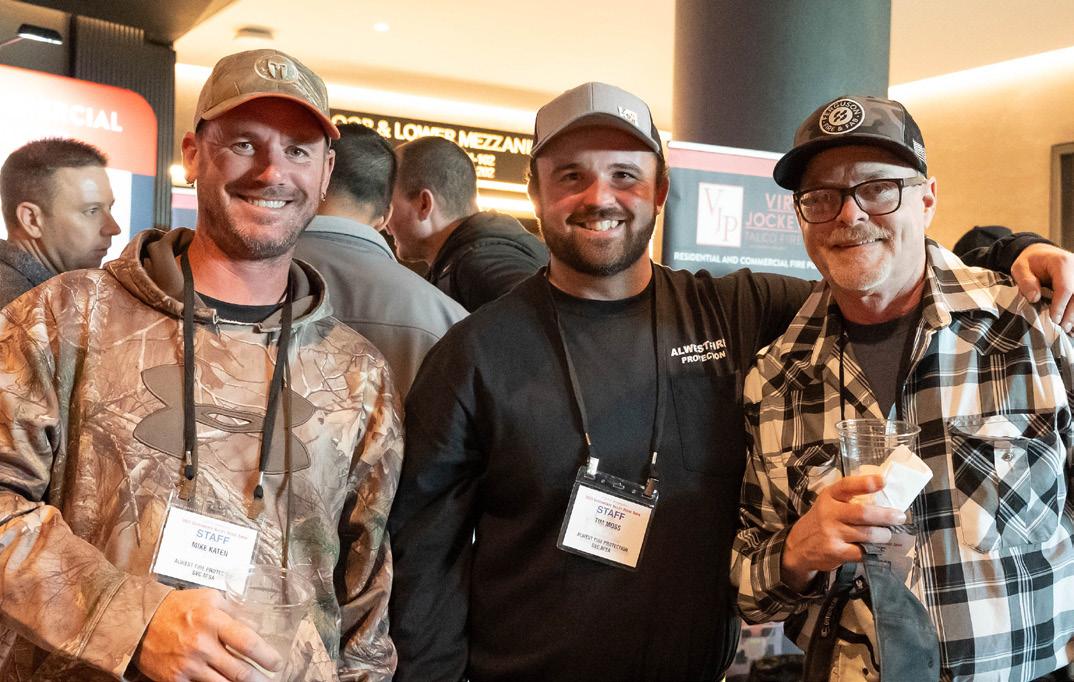
energy event drew over 600 attendees across the fire sprinkler industry. The event brought together contractors, designers, fitters, apprentices, office personnel,
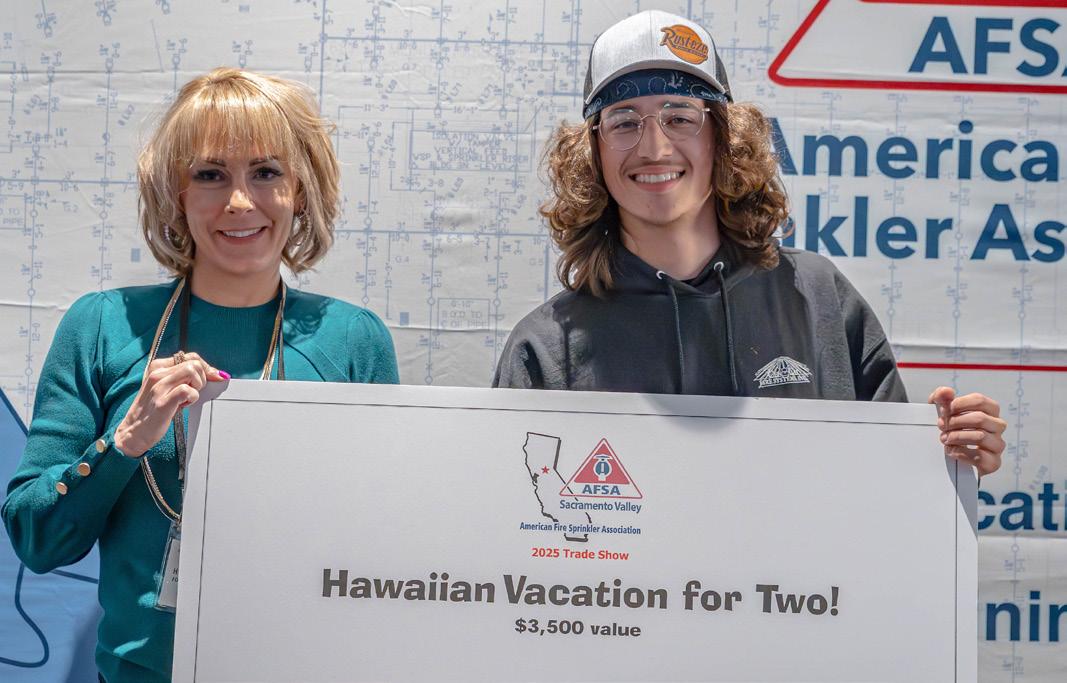
Enjoying the trade show were (from l to r): SVC AFSA Executive Director Paulene Norwood, SVC AFSA Chair Holly Gray Salmon, National AFSA Chair of the Board Linda Biernacki, SVC AFSA Vice Chair Joel Myers, and SVC AFSA Board Member Morgan Barlow.
SVC AFSA Chair Holly Gray Salmon (left) presenting the Hawaii Trip check to Andre Saldivar of Cen-Cal Fire Systems.
Volunteer staff from Alwest Fire Protection also had a little time for fun at the event!
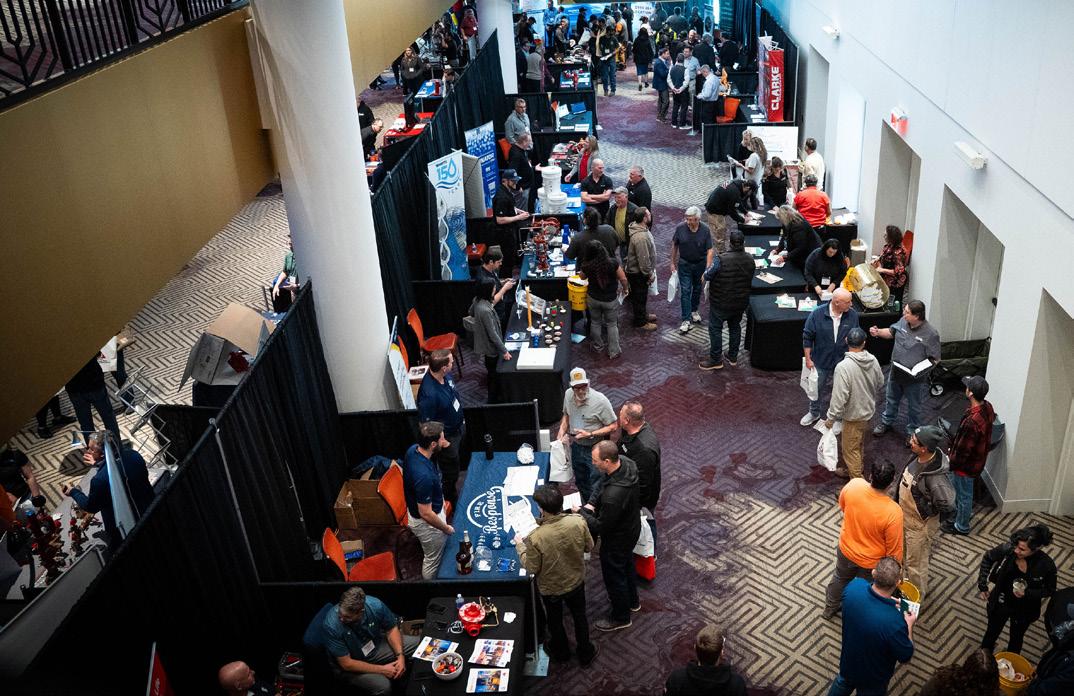
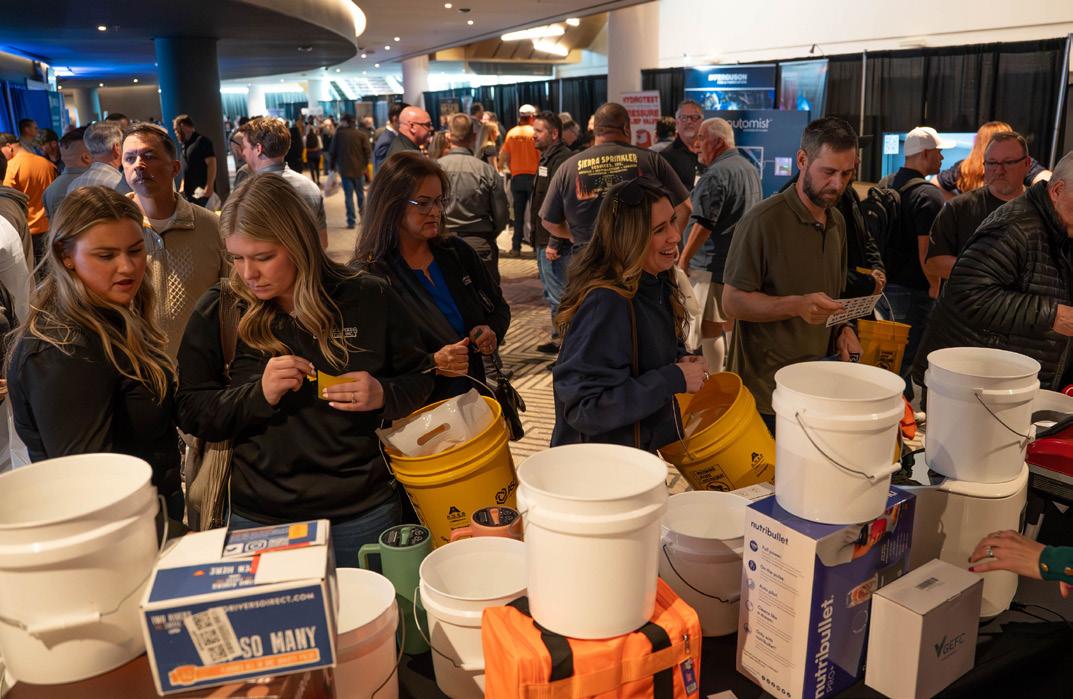
inspectors, manufacturers, suppliers, and industry leaders for an evening of connection, innovation, and shared purpose. AFSA Chair of the Board and Region 5 Director Linda Biernacki, president of Fire Tech Systems, Inc., Shreveport, La., and other members from AFSA attended this year as well.
With 50 exhibitors on the show floor, attendees experienced a vibrant mix of hands-on demonstrations, new technologies, and meaningful discussions. The buzz was constant, the aisles full, and the enthusiasm contagious.
Cole Rigney, U.S. national sales manager at Tornatech, Inc., noted, “It was a great show, as usual. It’s always a good opportunity to connect in person with other professionals in the industry, and the Sac Valley Chapter of AFSA does a fantastic job organizing the event.”
For many vendors, the engagement exceeded expectations. “The booth stayed busy with a mix of new contacts and familiar contacts,” shared Will Fassler, technical services representative at Spears® Manufacturing Company. Steve Brown, senior account manager at Engineered Corrosion Solutions, summed it up. “It was a great interaction with the members. We walked away with some good opportunities!”
The event continues to impress. “We love the Sac Valley AFSA Trade Show! Paulene and the team put on an amazing event! Every year, we love to see the growth of the industry—from
the contractors to the vendors and even the products themselves. It’s an honor to be a part of this show.” That sentiment was echoed by Patrick Spillane, CFPS, global portfolio leader at Hose Monster, who shared, “We always look forward to the Sac Valley AFSA Trade Show. The chance to demonstrate our innovative products, new fire pump and hydrant testing software, and to discuss real-world applications with the inspectors is invaluable. Thank you for another successful event.”
The positive feedback wasn’t limited to returning exhibitors. Kim Previti, Northeast sales manager at Steven Brown & Associates, Inc., noted, “As a first-time vendor participant, it is by far the best show to date in attendance, participation, and organization—thank you to everyone who stopped by our booth.”
Rounding out the excitement, Erik Nielsen from Repcor summed it up perfectly: “I do a ton of shows, and this year’s event was extremely impactful! The engagement from the huge crowds was impressive. We were able to show off [our new product] to the exact target audience we were looking for! I, for one, can’t wait for next year. Thanks for all of your efforts in making this an amazing event!”
Behind the scenes, the seamless execution and welcoming atmosphere were no accident. A heartfelt thank you goes to Paulene Norwood, chapter
executive director, whose leadership, organization, and tireless commitment to excellence made this event not only possible but truly unforgettable. The success of this event is a testament to the passion and dedication of everyone involved in its planning and execution.
The Sacramento Valley AFSA Trade Show is not just an event—it is a celebration of the fire sprinkler industry’s dedication, resilience, and ongoing innovation. As the industry continues to grow, this gathering remains a vital cornerstone for building relationships, showcasing progress, and inspiring the next generation of fire sprinkler professionals.
The Sacramento Valley Chapter of AFSA hopes you’ll consider joining the fun in 2026! For more information on the 2026 trade show and other chapter events, visit the SAC AFSA website at sacvalleyafsa.org or email Paulene Norwood, chapter executive director, at paulenesacvalleyafsa@gmail.com. n
ABOUT THE AUTHOR:
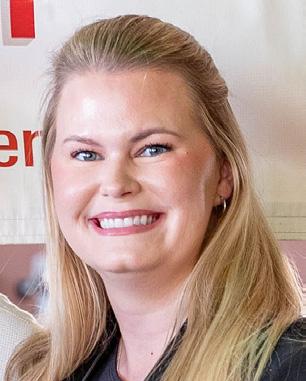
Morgan Barlow is an AFSA Sacramento Valley Chapter board member. She is the HR/benefit coordinator for Marquee Fire Protection in Rocklin, Calif.
The show kept flowing with this year’s “Blackout Bingo,” which brought the majority of attendees to each exhibitor who stamped their bingo card.
The raffle table was a great success with every attendee receiving tickets when they registered.
HIGHER STANDARDS
AFSA staff represented the association and the TAC at the 2025 NFPA Technical Meeting in Las Vegas. In addition to the results of the 2025 NFPA Technical Meeting, a summary of the discussions during the meeting and future action plans are discussed in this issue’s column.
NFPA 25, STANDARD FOR THE INSPECTION, TESTING, AND MAINTENANCE OF WATER-BASED FIRE PROTECTION SYSTEMS
CAM 25-3 – Qualified Personnel
Reject Second Revision No. 3
Vote of NFPA Membership: PASSED
CAM 25-3 re-inserts language that was deleted by SR-3. Based on this action, NFPA 25 would require all records for ITM and the original installation—as-built system installation drawings, hydraulic calculations, original acceptance test records, and device manufacturer’s data sheets—to be maintained in a documentation cabinet. The requirement to provide a documentation cabinet was added to the 2025 edition of NFPA 13. It should be noted that a documentation cabinet is not required by other installation standards under the scope of NFPA 25, including NFPA 13R, NFPA 14, NFPA 20, NFPA 22, NFPA 24, NFPA 750, and NFPA 770.
The recommendation of the NFPA membership will ultimately go back to the technical committee for a final ballot. The technical committee has the option to accept the action at the 2025 Technical Meeting or revert to the prior edition language for that section. When given the option, the technical committee typically votes for the option that aligns with their intent during the second draft stage, so I would expect this to fail committee ballot.
CAM 25-10 – Qualified Personnel Definition
Reject Second Revision No. 38
Vote of NFPA Membership: PASSED
CAM 25-10 reverts section 14.3.1(16) and the associated annex back to the language included in the previous edition of NFPA 25. Since the CAM passed on the floor of the NFPA Technical Meeting, an obstruction investigation would only be required where the nitrogen supply is not maintained on a system AND the hydraulic calculations for the system utilized an increased C Value of 120. It should be noted that requirements were added to Chapter 4 during this revision cycle to address required corrosion mitigation systems and acceptable replacements. During the next revision cycle, this requirement may be proposed to be removed altogether as the lack of nitrogen in a system doesn’t necessarily indicate that an obstruction investigation is warranted. There are plenty of dry systems using regular air that only require an obstruction investigation when an issue is identified during the 5-year internal assessment. Why should a dry system with nitrogen be penalized more than a dry system using air?
The recommendation of the NFPA membership is final in this case as the language recommended by the NFPA membership is the same as the language included in the previous edition of the document. n
AFSA TECHNICAL ADVISORY COUNCIL
E. Parks Moore, P.E., Chair (National Scope)
S&S Sprinkler Co. (Pye-Barker)
Alternate: Phillip Clemen, Rapid Fire Protection Group
Robert Anderson (Region 3)
Silco Fire & Security
Chris Campion (Region 9)
Eastern Fire and Safety
Alternate: Thomas Carlock
Jason Gill (Region 8)
Crews and Gregory Fire Sprinkler, Inc.
Alternate: Bob Beckwith, Cavalier Fire Protection, LLC
Matthew Heidler (National Scope)
Johnson Controls Fire Protection
Alternate: Kevin Galligan
Chris Johnson (Region 7)
Piper Fire Protection
Alternate: Steven Helkin
Chris Kachura (National Scope)
VSC Fire and Security
Alternate: Andrew Hafner
Adam Levine (Region 9)
Capitol Fire Sprinkler
Alternate: Chris Ribando, Approved Fire Protection
Jeff Lewis (Region 8)
VSC Fire and Security
Alternate: David Victor
Dale Lindh (Region 4)
Summit Companies
Alternate: Paul Szafranski
Eric Rieve (Region 10)
Rieve Fire Protection
Alternate: Connor Rieve
Chris Russell (Region 1)
Security Solutions NW
Alternate: Cody Sharp, Security Solutions NW
Steven Scandaliato (Region 5)
SDG, LLC
Alternate: Michael Newell, Belvedere
John Schotz (National Scope)
Davis Ulmer Sprinkler Co. (APi Group)
Alternate: Steve Ulmer
Taylor Schumacher (Region 4)
Security Fire Sprinkler
Alternate: Calen Schumacher
Byron Weisz (Region 2)
Cen-Cal Fire Systems, Inc.
Alternate: Erik Weisz
Jason Williams (Region 3)
Telgian Corporation
Alternate: Tammy Mayo
KEVIN HALL, M.Eng, P.E., ET, CWBSP, PMSFPE Staff Liaison
American Fire Sprinkler Association
EX-OFFICIO MEMBERS
AFSA Manufacturers/Supplier Council Chair
Phil Schechinger, Viking SupplyNet
Alternate: AFSA Manufacturers/Supplier Council Vice Chair
Andy Kaempfer, Safe Signal
Johnson Controls
Melisa Rodriguez
Reliable Automatic Sprinkler Co.
Cary Webber, Alternate: Brandon Telford
UL Solutions
Kerry Bell, Alternate: Jeff Hebenstreit
KEVIN HALL, M.ENG, P.E., ET, CWBSP, PMSFPE AFSA DIRECTOR OF ENGINEERING

Victaulic
Kevin Kelly, Alternate: Alaina Schwall
Viking Corporation
Martin Workman, Alternate: Josh Overholt
ABOUT THE TAC: TAC meetings are open to all AFSA members in good standing. Contact your regional representative to discuss any issues that the TAC should hear. While the number of voting members on the TAC is currently restricted to 20 contractor companies, there are other opportunities for interested AFSA members. If you are interested in serving on an NFPA or UL technical committee, email technical@firesprinkler.org. All technical committee appointments are made by the TAC.
TECHNICAL CHALLENGES
CAN YOU MEET THE CHALLENGE?
AFSA’s Engineering & Technical Services Department staff present technical challenges here for you and your co-workers. These exercises are also excellent preparation for professional certification tests and may count as CEUs. Check with your certification organization. Answers to this issue’s questions will be presented in the next issue.
MAY/JUNE ANSWERS
The following questions are based on NFPA 20, 2025 edition.
1. Fuel tanks for diesel engine drivers are required to have a minimum volume based on what statement? (11.4.1.3 Fuel Supply Tank Capacity.)
A. 1 gal per horsepower x 8 hours + 5% for sump + 5% for expansion
B. 1 pint per horsepower x 8 pints per gallon x 8 hours + 5% for sump + 5% for expansion
C. 250 gallons for all applications
D. The manufacturer’s published fuel consumption rate x 12 hours + 5% for sump + 5% for expansion
2. Fuel tanks for diesel engine drivers are required be: (11.4.1.5.2.2)
A. equipped with a 1/2-in. NPT drain valve.
B. pitched to the drain valve.
C. installed level.
D. of the double wall construction type.
3. When selecting a diesel engine driver power rating, what factors are required to be considered when derating the performance of the listed driver? (11.2.2.3 and A.11.2.2.5)
A. The maximum incoming air temperature at the air inlet filter connection during the hottest expected ambient conditions under full operating load and the elevation of the fire pump relative to sea level.
B. The maximum air temperature in the fire pump room during the hottest expected ambient conditions under full operating load and the elevation of the fire pump relative to sea level if it is over 1,000 ft.
C. The length and elevation change of the exhaust system piping.
D. The type and grade of diesel fuel utilized in the area where the installation of the fire pump is being installed.
4. The exhaust piping system (piping and muffler) from a diesel driver must: (11.5.2.5)
A. be acceptable to the engine manufacturer, and the exhaust back pressure shall not exceed the engine manufacturer’s recommendations.
B. be approved.
C. be listed by UL.
D. comply with the local regulations regarding noise levels.
JULY/AUGUST QUESTIONS
The following questions are based on NFPA 14, 2024 edition.
1. For an exposed 21/2-in. fire hose valve located in a stairway, what is the minimum distance in inches between any surface or object to allow a gloved hand of a firefighter space to operate the valve?
A. 2 in.
B. 3 in.
C. 4 in.
D. 6 in.
2. For a 21/2-in fire hose valve located in a fire hose cabinet, what is the minimum distance in inches between any surface or object to allow a gloved hand of a firefighter space to operate the valve?
A. 1 in.
B. 2 in.
C. 21/2-in.
D. 3
3. What is the mounting height above the finished floor for a fire hose valve (centerline of the valve to the finished floor)?
A. not less than 3 ft or more than 5 ft
B. not less 2.5 ft or more than 6 ft
C. not less than 3 ft of more than 4 ft
D. not less than 3 ft or more than 6 ft
4. As far as cost is concerned, rank the order (from lowest to highest) of the following finishes of fire hose valves.
A. Rough brass, polished brass, rough chrome, polished chrome
B. Rough brass, rough chrome, polished brass, polished chrome
C. Rough brass, rough chrome, polished chrome, polished brass
D. Rough chrome, rough brass, polished chrome, polished brass
5. A manual dry standpipe system must:
A. be supervised with air pressure to monitor the pipe system integrity and the fire hose valves are in the closed position.
B. be equipped with a fire department connection to provide supplementary water to the system.
C. fabricated with galvanized steel piping and brass valves.
D. be fabricated with black steel piping, galvanized steel piping, copper Type L copper tubing, or Type K copper tubing.
UNCLE RUSS
Preface: The purpose of “Uncle Russ” is to provoke thought. Uncle Russ is not arrogant enough to think that he has all the answers, and, in some cases, he has no answers at all but only questions. I hope upon reading this, you can discover both questions and answers to consider.
Engineer, sales, estimator, designer, inspector, fitter, project manager, accountant, or administrator— regardless of our role in the fire protection industry, we have the obligation to represent ourselves and the companies for which we work as professionals. While it might be difficult to place a specific definition with the term “professional,” I believe we “know it when we see it.”
Professionalism is manifested in multiple ways, but at this time I focus on just two—appearance and speech. Fair or not, we judge someone’s professionalism on physical cues such as how they look and sound. I recognize that negative impressions can be overcome but it costs time, and as a result, money to do so. As a result, it is shortsighted and inefficient to place unnecessary obstacles that we must overcome.
HOW WE LOOK
Professionals are compensated and amateurs are not. With this in mind, we expect that a professional has a higher skill set than an amateur. We also expect a higher level of decorum and behavior.
Case in point—many of you know of Dennis Rodman, a hall-of-fame professional basketball player. However, when seeking an example of someone who “looks” professional, Dennis would not come to mind. On the other hand, Michael Jordan is also a hall-of-fame professional basketball player, perhaps the best player ever to play the game, but unlike Dennis, he “looks” professional.
Dennis Rodman is colorful. Athletes, entertainers, and actors can be colorful. However, no one wants a “colorful” inspector, project manager, or fitter. We want a professional, and how someone appears is our first cue in measuring.
This is not to say that we must dress and groom to a particular look. We dress for the job at hand. If an inspector were to show up for an annual fire pump test wearing a coat and tie, it would be natural to question whether he or she understands the job at hand. Conversely, if a project manager were to attend a construction coordination meeting wearing a tank top, shorts, and flip-flops, it would likely cast doubts about their qualifications. When asked about how we should dress, I like to use the word “crisp.” We dress for the job looking sharp and competent.
One thing to keep in mind. If we are not sure what “look” might be appropriate, then dress up, not down. For example, if I am meeting with a prospective customer and I am unsure of their culture, I wear a coat and tie. If I arrive to find that I am “overdressed,” it is easy to remove the tie or take off the coat. However, it is extremely difficult to overcome being “underdressed.”
It seems today that some take pride in dressing sloppily or down. I hear it said, “I work at home, or I do not interact with customers or vendors in person, so why does it matter if I wear my pajamas or exercise gear”? I believe that dressing for work helps us “to be at work.” For me, it is easier to be on the job if I am dressed for it. If I dress for the beach, it is harder for me to be mentally at work.
HOW WE SPEAK
Professionals use speech to their advantage. Just as our competency is judged by our appearance, it is also evaluated by how well we speak. Professionals talk in ways that connotate job mastery, intelligence, and self-control. One particular point is there is no place for vulgarity. We all know that there are words and phrases that have no place when speaking as a professional. I continue to be amazed at how vulgarity has become so commonplace that many are desensitized to it. This happened to me.
It took a conscious and concerted effort on my part to speak in a professional manner, particularly when things were emotionally charged. However, I discovered that when I speak calmly and quietly and use words that are not offensive, people hear me better. I have a son-in-law who is a 20-year highway patrol veteran. He never swears or loses control of his speech. During ride-a-longs, I have watched him diffuse extremely volatile situations, and he does it by not responding to vulgar verbal attacks with his own vulgarity. When I questioned him about it, he explained to me that if he gives back tit for tat, people do not “hear” him.
Last, do not fall into the trap of using vulgarity because your customer or associate does so. I will never forget when I had a long-time customer complain about one of our best consultant’s poor speech habits. He told me that even though he (the customer) swears and cusses up a storm, he did not want his consultant to do so. He stated, “I pay for this person to represent my professional side.” Ok—lesson learned.
In conclusion, the way we dress and speak matters. Again, I understand that we can often overcome the obstacles created by our non-professional appearance or speech, but why place an unnecessary barrier between us and a customer, supplier, vendor, or associate simply because we are too lazy or rebellious to act in a way that does not create obstacle? Ask, “Do I present myself as a professional or not?”. Something to think about. n
RUSS LEAVITT, CFPS, S.E.T. TELEGIAN HOLDINGS EXECUTIVE CHAIR AFSA COMMITTEE MEMBER & SPEAKER

YOUR NEXT TOP DESIGNER STARTS HERE
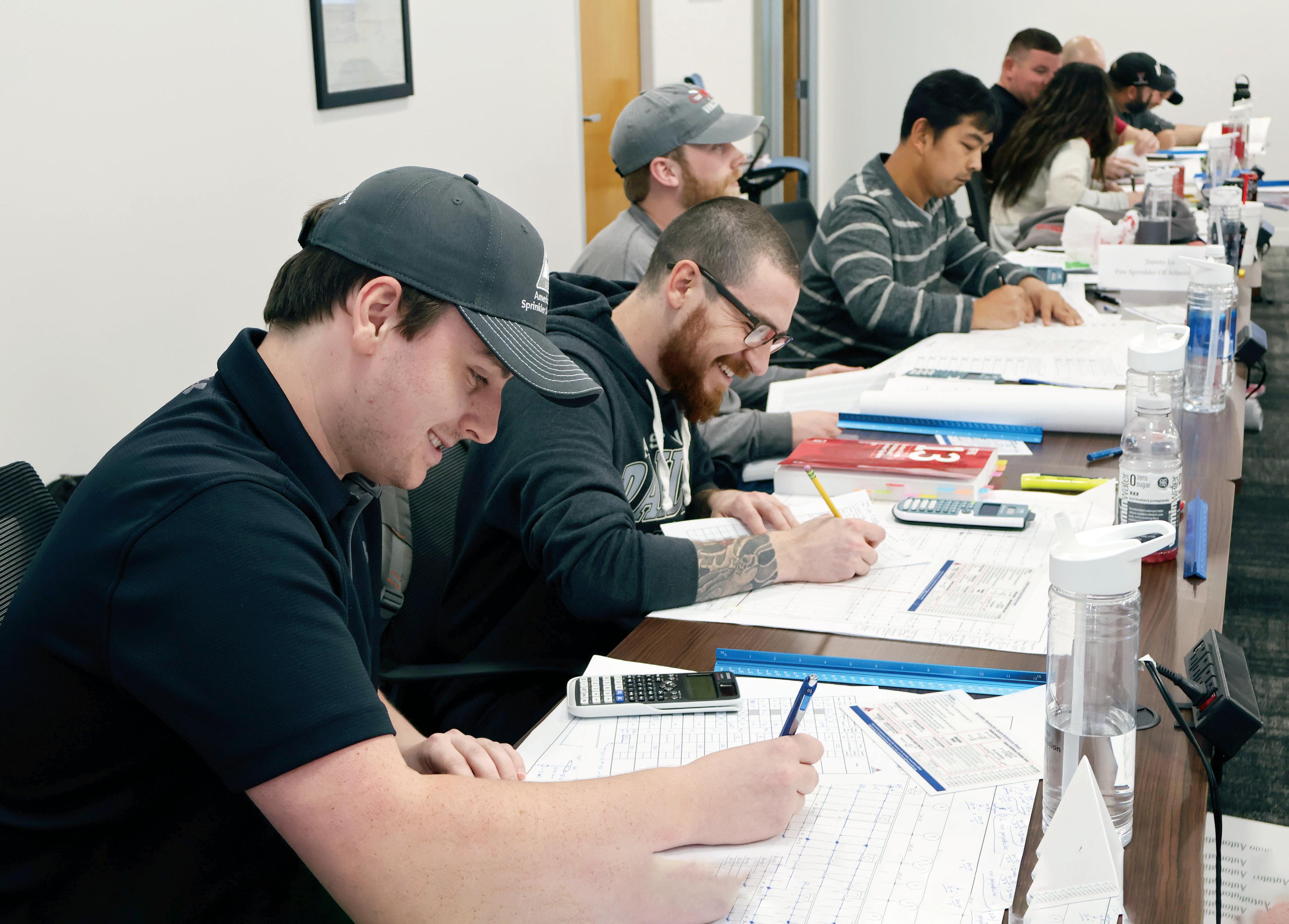
Register Early and Save
Beginning Design School
Sept. 9 - Oct. 3
Nov. 17 - Dec. 12
Intermediate Design School
Sept. 3 - 12
Both schools begin with live webinar instruction followed by in-person training in Dallas, TX.
Redesigned for a hybrid approach, with six live webinars offered first, followed by one week of in-person instruction. Students will study the installation & design approach requirements of NFPA 13 (2022), prepare system layout drawings, and perform hydraulic calculations by hand.
Experienced layout technicians will find this blended learning course useful to understand the tools they utilize in-depth and gain a deeper knowledge of layouts for standpipe systems, fire pumps, seismic protection, and the design requirements for general storage.
#MEMBERSMATTER!
In today’s competitive professional landscape, joining a trade association is one of the smartest moves you can make to accelerate your career. Whether you’re new to the industry or an expert with years of experience to sharpen your skills and expand your network, trade associations offer many opportunities that extend far beyond attending an annual conference.
Every year, thousands of professionals gather at industryspecific association conferences, trade shows, and expositions to connect, learn, and grow. These events offer more than just a few days away from the office; they are gateways to opportunities. Whether you’re a first-time attendee or a seasoned participant, the benefits of attending an association conference go far beyond the event itself. From elevating your professional profile to enhancing your resume and inspiring you to give back, association events are powerful catalysts for career and professional development.
One of the most immediate and valuable benefits of attending an association event is exposure. You’re surrounded by industry leaders, decision-makers, innovators, and peers at a well-organized conference or trade show. These are the people shaping the future of your field and they’re all in one place. Engaging in sessions, asking thoughtful questions, and participating in networking events helps make your presence known. Many conferences also offer opportunities to speak on panels, present research or case studies, or even compete in industry-related competitions like AFSA’s Annual National Apprentice Competition. These moments place you in front of an audience that matters, helping to establish your credibility and expertise.
Even if you’re not presenting, simply being present is an opportunity to build relationships. Introduce yourself at breakfast roundtables, visit exhibitor booths, and follow up with connections you make. With every handshake or business card exchanged, you’re growing your professional network and increasing your visibility in the industry.
Additionally, many associations highlight attendees and contributors in their newsletters, websites, or social media. Sharing your conference participation online or being featured by the organization can lead to further recognition within your professional circle.
Attending a professional conference shows initiative, curiosity, and a commitment to staying current in your field. These are traits employers look for when reviewing resumes. Listing conference attendance on your resume demonstrates that you are actively involved in professional development. It shows that you value learning and are willing to invest your time in gaining knowledge and staying ahead of industry needs.
But you can take it even further. Were you a speaker or panelist? Did you help organize a session? Did you attend specialized training or earn continuing education credits? These
are concrete experiences that go beyond passive attendance. They signal leadership potential, project management abilities, and subject matter expertise.
Expositions often showcase emerging technologies, products, and solutions. Getting hands-on experience or demos with these tools gives you practical knowledge that can set you apart from your peers. When you bring fresh ideas or new technologies back to your company, you become a resource and possibly a leader for innovation within your organization.
At association events, many attendees discover a renewed sense of purpose and connection to their industry, which often manifests as a desire to give back. Volunteerism can begin with simple steps like helping at registration, moderating a session, or serving as a room host. From there, it can grow into committee work, task forces, or even board service. Many associations actively recruit volunteers during events, recognizing that in-person engagement often leads to long-term involvement.
Volunteerism through an association not only gives back to your profession but also deepens your engagement and expands your network. Volunteers often gain behind-the-scenes access to industry happenings, build relationships with key leaders, and play a role in shaping the association’s future.
The true impact of attending a conference or trade show isn’t limited to the days you spend at the event; it ripples out in every direction. You return to your company with new insights, expanded networks, and fresh energy. You may discover a new career path, meet a mentor, or find yourself inspired to mentor someone else.
You also walk away with a stronger professional story. You weren’t just an attendee; you’re a contributor, a learner, a connector, and potentially a leader. This narrative enhances your personal brand and makes you more marketable in an increasingly competitive environment.
Attending an association’s conference, trade show, or exposition is more than a professional obligation; it’s a strategic move that can transform your career. From gaining exposure and enhancing your resume to discovering the joy of giving back through volunteerism, these events are powerful platforms for growth. So, the next time you attend an AFSA annual convention, don’t just sign up. Show up, speak up, and get involved! We look forward to seeing you at AFSA44 in Washington, D.C., October 15-18! n
MEDA MERRITT, CAE AFSA VICE PRESIDENT OF MEMBERSHIP & CHAPTER DEVELOPMENT

INTRODUCTION TO FIRE SPRINKLERS
1 Day Course
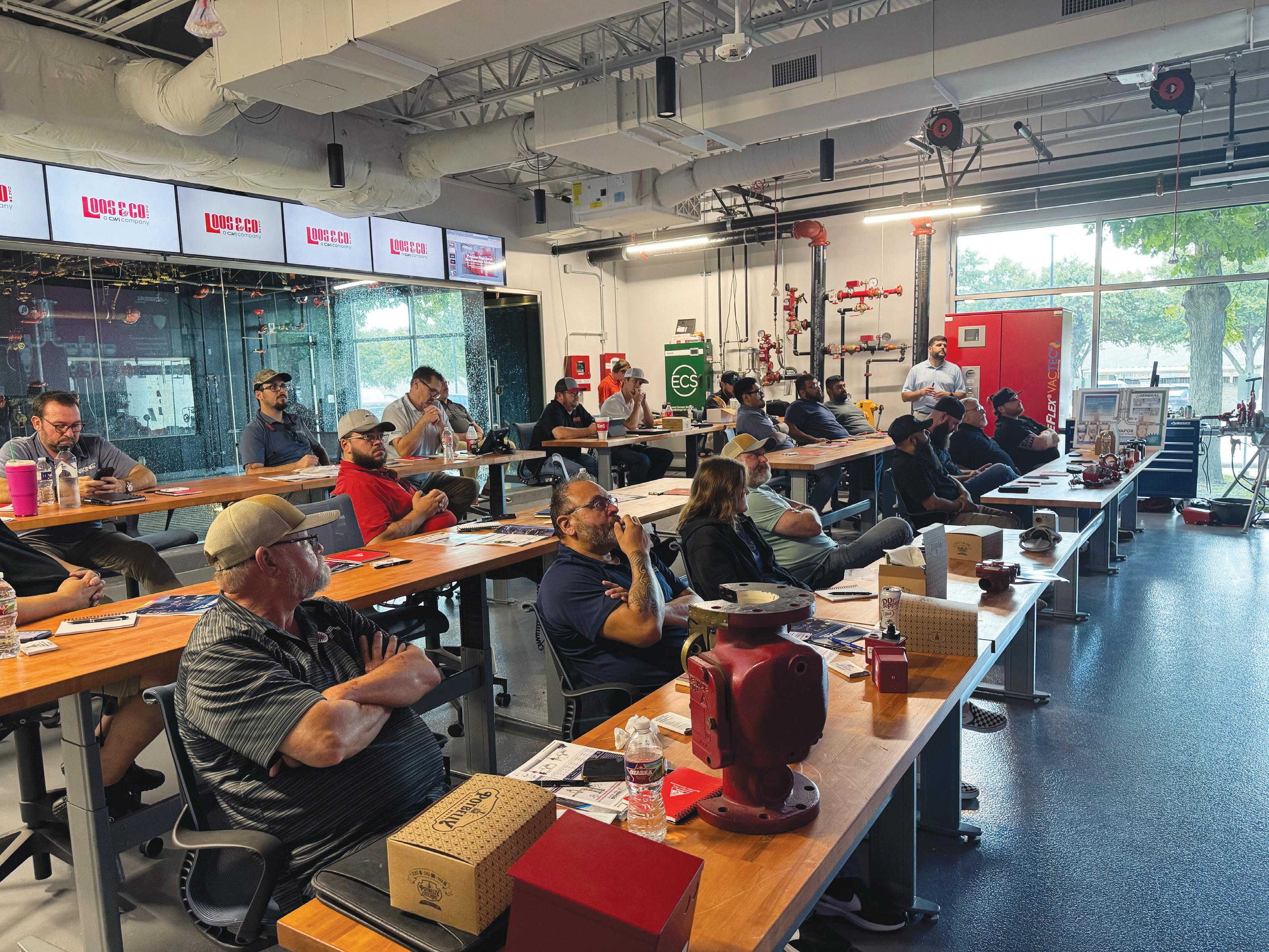
Learn the Fundamentals of Fire Sprinkler Systems
Whether you’re new to the industry or looking to refresh your knowledge, this introductory class is the perfect starting point to understand how fire sprinkler systems work and why they’re critical for life safety.
No Dumb Questions! This class is for those who want to learn the basics of fire sprinkler systems and gain a better perspective of their major contribution to fire and life safety. In this course, we’ll guide you through the essential concepts of fire sprinkler systems. With expert insights, and hands-on exercises, you’ll leave with a robust understanding of how fire sprinkler systems play a critical role in life safety and property protection.
Fire safety is not just a regulatory requirement — it’s a responsibility. Are you ready to dive in and learn how to help save lives and protect valuable assets? Start your journey today to becoming a fire sprinkler expert!
Schedule
August 1, 2025 | October 27, 2025
8am-4:30pm
Richardson, TX
Who Is This For?
• New staff
• Administrative staff in fire protection
• Sales personnel
• Estimators
• Facility managers
• Helpers, Pre-apprentices, Apprentices
• Students
• Career changers
• Anyone who wants to learn about the fire sprinkler industry
Course Highlights
• History and purpose of fire sprinkler systems
• Overview of system types (wet, dry, preaction, deluge)
• Key components and how they function
• Introduction to industry codes & standards
• Installation basics and maintenance principles
• Real-world case studies and system demos
AFSA NEWS
CALENDAR
AUGUST 2025
1
• Introduction to the Fire Sprinkler Industry
AFSA Headquarters, Richardson, TX firesprinkler.org/programs/introduction-to-the-firesprinkler-industry
5
• Level 2 Virtual Instruction Program (VIP) Begins firesprinkler.org/sprinkler-fitter-apprentice-training-vip 25-26
• NFPA 25 Essentials Workshop
AFSA Headquarters, Richardson, TX firesprinkler.org/programs/nfpa-25-essentials-workshop 25-27
• Advanced Hydraulic Calculations
AFSA Headquarters, Richardson, TX firesprinkler.org/programs/advanced-sprinkler-hydrauliccalculations-workshop 27-28
• NFPA 25 Fire Pump Workshop
AFSA Headquarters, Richardson, TX firesprinkler.org/programs/nfpa-25-fire-pump-workshop
SEPTEMBER 2025
3-12
• Intermediate Design School
AFSA Headquarters, Richardson, TX firesprinkler.org/programs/intermediate-fire-sprinklersystem-planning-school
29 – OCT. 1
• NFPA 25 Advanced Systems Workshop
AFSA Headquarters, Richardson, TX firesprinkler.org/programs/nfpa-25-advanced-systemsworkshop
OCTOBER 2025 2-3
• NFPA 25 Fire Pump Workshop
AFSA Headquarters, Richardson, TX firesprinkler.org/programs/nfpa-25-fire-pump-workshop 15-18
• AFSA44: Convention, Exhibition, & Apprentice Competition
Gaylord National Resort & Convention Center, National Harbor, MD
28 – Nov. 21
• Beginning Design School
AFSA Headquarters, Richardson, TX firesprinkler.org/programs/beginning-fire-sprinklersystem-planning-school
Seminars subject to change. Call (214) 349-5965 to confirm locations and times. For more events and details, visit firesprinkler.org and click on “Events” and “Events List.”
DENHARDT RECEIVES UMD FPE AWARD
AFSA proudly announces that John August Denhardt, P.E., FSFPE, vice president of engineering and technical services, has received the Distinguished Alumni Award from the University of Maryland Fire Protection Engineering Department (UMDFPE). UMDFPE Chair Arnaud Trouvé, Ph.D., presented Denhardt with the award at the Distinguished Alumni Dinner during NFPA’s 2025 Conference & Expo.
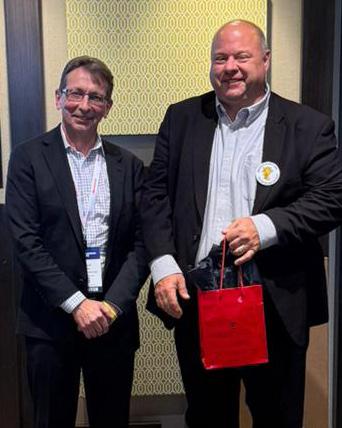
The award honors those in the Department of Fire Protection Engineering who have contributed to the mission and ideals of the department. Candidates should have accomplished one or more of the following:
• Contributed truly exceptional service to their community, the Department of Fire Protection Engineering, the profession, and/or the public, or;
• Enhanced the student experience, research scholarship, academic excellence, technology commercialization, national and international reputation, and impact of the Department of Fire Protection Engineering or;
• Made significant accomplishments in the theory and practice of fire protection engineering, or;
• Managed or directed an organization that has made noteworthy national or international contributions in design, construction, production, or service delivery by applying complex fire protection engineering principles.
“Congratulations to John for the recognition by his peers and fellow alumni. This award acknowledges him as a premier industry speaker and personality,” says AFSA President Bob Caputo, CFPS. “His many years of service in the code development process and sharing his knowledge and experience are unsurpassed.”
SCHOLARSHIPS AVAILABLE
Through August 31, 2025, eligible college or trade school students can visit afsascholarship.org to apply for one of AFSA’s “second chance” scholarships. Created by AFSA’s Public Education & Awareness Committee to raise awareness about fire sprinklers, the fire protection industry, and its careers, the contest is open to students who want to pursue a college degree or trade school education. Five winners are randomly selected to receive a one-time $1,000 scholarship payable to their respective college, university, or trade school. For more details and to enter, visit afsascholarship.org/secondchance.
SHARE YOUR STORY!
AFSA is encouraging members to “Tell us your story!” It could include a successful result resulting from a Technical Review (saved time and money), someone who started out as a sprinkler fitter apprentice and now owns a business, or a design school graduate who is now a lead designer, etc. Stories may be featured in Sprinkler Age and on AFSA’s social media platforms. Email communications@firesprinkler.org to share your story. n
CHAPTER NEWS
CHESAPEAKE BAY
On June 20, AFSA’s Chesapeake Bay Chapter held a day of free AHJ training. The event was coordinated by David Victor, chapter treasurer, and the training was given by Kevin Hall, M.Eng., P.E., ET, CWBSP, PMSFPE, AFSA’s director of engineering. The event covered four hours of hydraulics training, two hours of fire pump selection, and two hours of standpipe design. The event was held at the Salisbury Fire Department’s headquarters. Over 25 code officials, plan reviewers, fire marshals, and fire inspectors attended. Everyone enjoyed a delicious breakfast and lunch supplied by the Chesapeake Bay Chapter.
DFW
Thank you to everyone who attended the Corrosion Prevention Luncheon at AFSA headquarters! We truly appreciate your participation and engagement. A special thank you goes out to our outstanding presenters Tate Hitzman with Potter Signal, Allan Diaz with FireFlex, and Steve Trajer with General Air, for sharing their expertise and valuable insights during the session. Your contributions were instrumental in making the luncheon informative and impactful. We would also like to extend our gratitude to all the registrants for their interest and attendance, as well as the dedicated AFSA staff whose hard work helped make this event a success.
NEW MEXICO
The New Mexico Chapter held a training on May 6 that had 50 attendees. Kevin Hall, M.Eng., P.E., ET, CWBSP, PMSFPE, AFSA’s director of engineering, presented on four topics to a room full of AHJs, plan reviewers, designers, and installers. Each attendee received a t-shirt and a gift bag. The New Mexico Chapter is working hard to rebuild a strong group of people dedicated to life safety and fire prevention.
VIRGINIA
AFSA’s Virginia Chapter conducted a meeting on April 8, at the Academy at Virginia Randolph located in Glen Allen to celebrate the grand opening of the new fire sprinkler lab and fire sprinkler curriculum at the school. The meeting was a great success with 48 attendees and a
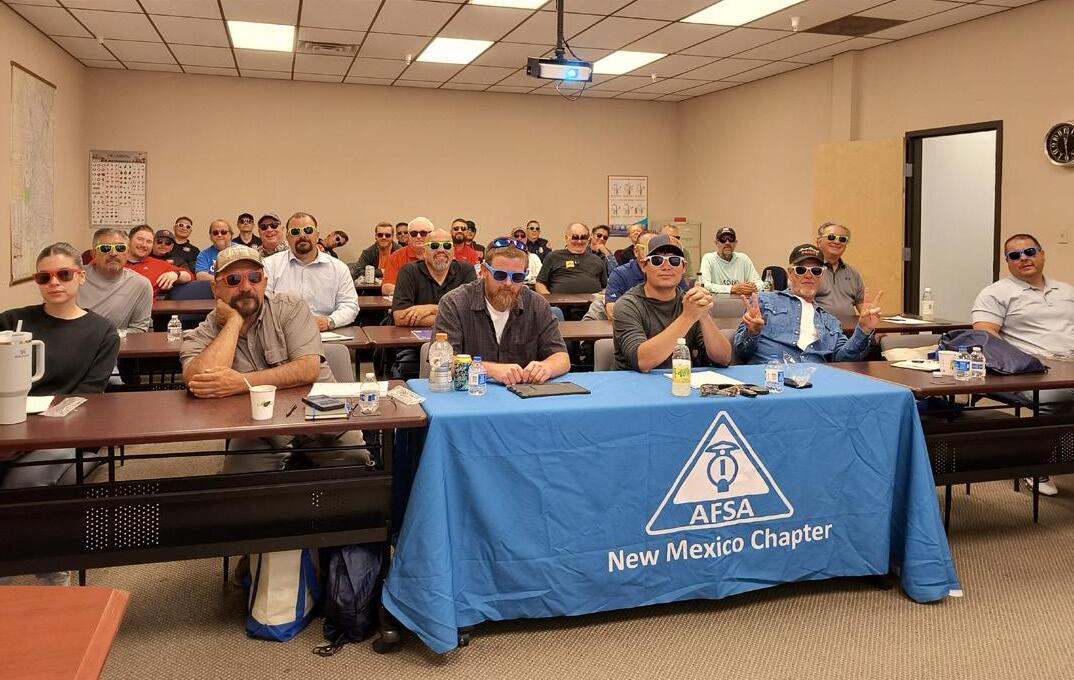
delicious lunch prepared by the HCPS culinary students. Mac Beaton and Bev Cocke with HCPS gave a presentation on the genesis of the fire sprinkler lab and future projects. Virginia Chapter Board member, MaryCatherine Coyle, social media chair, prepared a presentation on “How to Retain Employees.” n
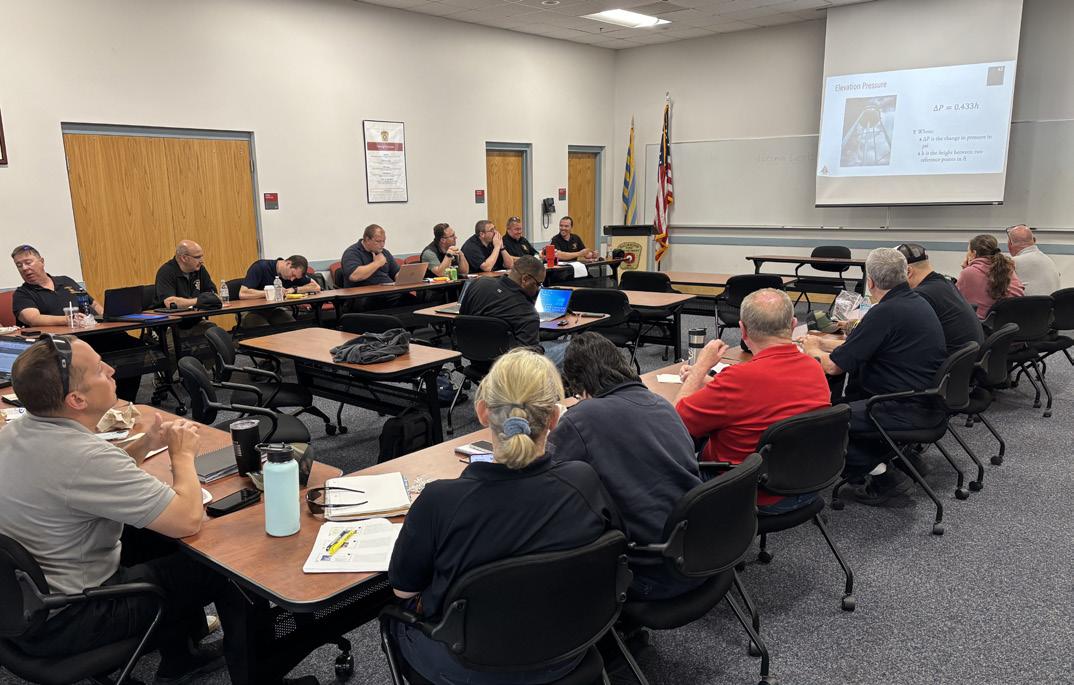
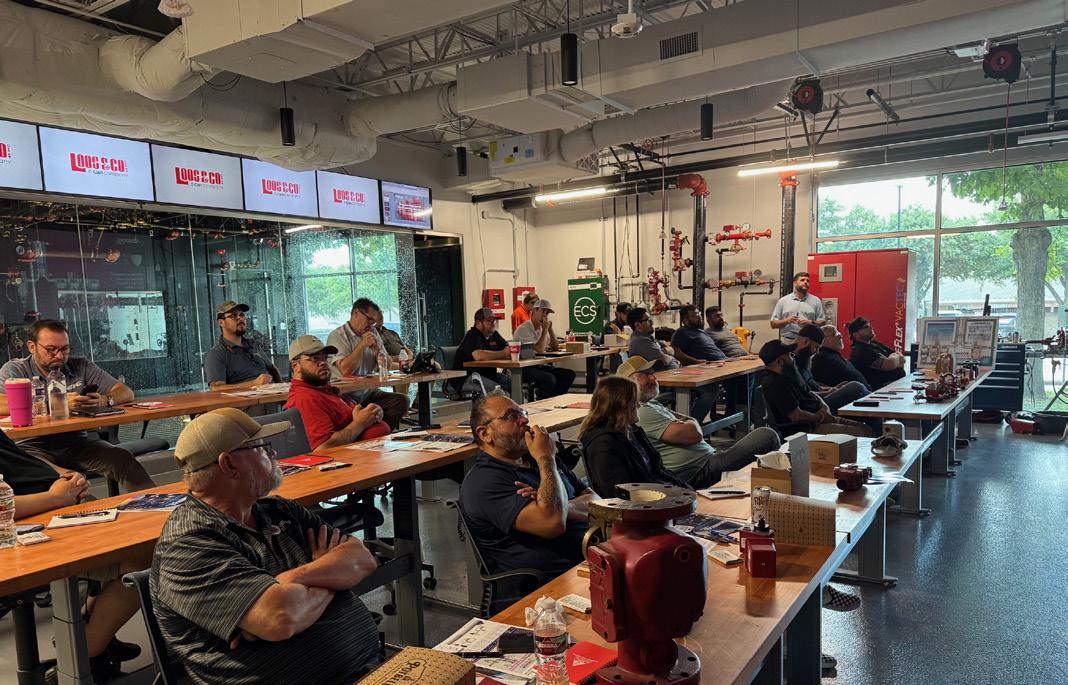

The DFW Chapter met at AFSA’s training center for a corrosion prevention meeting and luncheon.
AFSA’s Chesapeake Bay Chapter held a free training day for AHJs.
The new fire sprinkler lab and curriculum were on display at AFSA Virginia Chapter’s April 8 meeting.
New Mexico Chapter members participated in a day of training and networking on May 6.
AFSA CHAPTERS
ALABAMA
Lee Seewald – Pres.
202-252-5101
Greg Willis – Exec. Dir. 334-567-4257
ARIZONA
Jason Williams – Chair
480-421-8411
Denniece Cooper - Exec. Dir.
DALLASFORT WORTH
Eric Davis – Chair 903-771-6811
Merle Hittle – Vice Chair 214-282-0350
FLORIDA
Bob DiModica - Chair 239-514-7155
ILLINOIS-INDIANA
Skyler Bilbo – Chair 217-342-2242
LOUISIANA
Randy Laguna – Chair 504-464-6236 ext 224
Ellen Ballard – Exec. Dir. 318-688-8800
NEW JERSEY
Thomas Bowlby, Jr. – Chair 908-226-5313
Victor Lugo – Exec. Dir. 201-635-0400
NEW MEXICO
Paul Chavez – Chair 505-898-9197
Renee Nix - Exec. Dir.
SACRAMENTO VALLEY
Holly Gray Salmon – Chair 916-296-9913
Paulene Norwood – Exec. Dir. 916-296-0635
SAN DIEGO
Mark Scott – Chair 619-778-2377
SOUTHERN CALIFORNIA
Vahe Zohrabian – Chair 818-822-1797
TENNESSEE
Casey Milhorn – Chair 615-349-5278
David Pulliam– Exec. Dir. 901-484-0605

10 9 8 7 6 5 4 3 2 1
AFSA NEW MEMBERS
New members as of June 27, 2025
CONTRACTORS
Connecticut Fire Prevention Company, Orange, CT
Eastern Fire Protection Services Inc, Crofton, MD
Great Moose Fire Protection Inc., Bangor, ME
Mark Woodley Fire Protection, Inc., Fresno, CA
Phoenix Fire Protection, East Helena, MT
Reagan Mae Contracting LLC, Fishkill, NY
Ridge Fire Protection Inc., Chicago, IL
Twin Cities Fire Protection, Stacy, MN
DESIGNER
Grace Design, New Castle, DE
FACILITY MANAGERS
Michael Fry, Carlsbad, NM
AHJS
Clinton Allen, APO, NY
Jason Applegate, Texarkana, TX
Greg Aucoin, Texarkana, TX
Jaden Barger, Texarkana, TX
Cole Beckham, Texarkana, TX
Chris Black, Texarkana, TX
Braden Bolin, Texarkana, TX
David Bradley, Texarkana, TX
Nathaniel Brown, Kernersville, NC
Mason Burrows, Texarkana, TX
Ethan Carroll, Texarkana, TX
Bobby Chambers, Texarkana, TX
Kenneth Chamblee, Texarkana, TX
Lance Cheatham, Texarkana, TX
Joseph Cink, Mobile, AL
Michael Clark, Texarkana, TX
Scott Daniel, Texarkana, TX
Jeff Davidson, Texarkana, TX
John DeSimone, Mechanicville, NY
Marc Dessel, San Diego, CA
Danny Douglas, Texarkana, TX
Nick Falley, Cosmopolis, WA
Larry Fassauer, San Marcos, TX
David Fernandez, San Marcos, TX
Joseph Fowler, Bloomington, IL
George Georgeou, Maywood, NJ
Marcus Gilliam, Texarkana, TX
Jeremy Gingery, Texarkana, TX
Lorena Gonzalez, Fremont, CA
Robert Greenway, Texarkana, TX
Alan Guymon, Idaho Falls, ID
Jacob Guzman, Chula Vista, CA
Jason Hale, Texarkana, TX
Aaron Hammonds, Texarkana, TX
Roger Hand, Texarkana, TX
Andy Harper, Texarkana, TX
Chris Hengstenberg, St. Petersburg, FL
Dakota Huddleston, Texarkana, TX
David Jackson, Texarkana, TX
Aaron Johnson, Texarkana, TX
Cory Jolly, Georgetown, TX
Payton Jones, Texarkana, TX
Peter R. Lantin, New Hyde Park, NY
Rodney Lathrop
Jim Leigh, Sterling Heights, MI
Fred Link, DeLand, FL
Terrance Lomax, Texarkana, TX
Eric McCaslan, Texarkana, TX
Reyshawn McKinney, Texarkana, TX
Bradley McKinnon, Texarkana, TX
Sean Medders, Texarkana, TX
Angel Mejia, Texarkana, TX
James Mixon, Texarkana, TX
Hayden Moore, Texarkana, TX
Mason Moses, Texarkana, TX
Timothy Murray, West Chester, PA
Dustin Newman, Texarkana, TX
Danielle OToole, Chino Hills, CA
Willard Page, Texarkana, TX
Eric Pastrama, Auburn, CA
Jones Payton, Texarkana, TX
Lane Peeples
Ethan Phillips, Texarkana, TX
Krysta Pinson, Campbell, CA

VIRTUAL INSTRUCTION PROGRAM (VIP)

• Online testing accessible 24/7 • AFSA’s VIP can be used as part of your registered apprenticeship program • Convenient format and schedule
• Training is 10 months per level
U.S. CONSTRUCTION REPORTS
CONSTRUCTION STARTS DECLINED 9% IN APRIL
Total construction starts were down 9% in April to a seasonally adjusted annual rate of $1.03 trillion, according to Dodge Construction Network. Nonresidential building starts declined 3%, residential starts fell 4%, while nonbuilding starts decreased 22%. On a year-to-date basis through April, total construction starts were down 3% from last year. Nonresidential starts were down 10%, residential starts were down 5%, and nonbuilding starts were up by 8% over the same period.
For the 12 months ending April 2025, total construction starts were up 2% from the 12 months ending April 2024. Residential starts were flat, nonresidential starts were up 1%, and nonbuilding starts rose 5% over the same period.
“Broad-based monthly declines in construction starts represent a troubling signal for the sector,” stated Eric Gaus, chief economist at Dodge Construction Network. “While not definitive, the slowdown in April aligns with delays in the planning pipeline and other economic data that capture the volatility and uncertainty of all the April tariff announcements. Uncertainty around trade policy and the economy’s direction will continue to weigh on construction activity in the coming months.” n
CONSTRUCTION STARTS IMPROVED 13% IN MAY
Total construction starts were up 13% in May to a seasonally adjusted annual rate of $1.16 trillion, according to Dodge Construction Network. Nonresidential building starts improved by 18%, residential starts rose 2%, and nonbuilding starts grew 20% over the month. On a year-to-date basis through May, total construction starts were down 4% from last year. Nonresidential starts were down 6%, residential starts were down 5%, and nonbuilding starts were 2% lower over the same period.
For the 12 months ending May 2025, total construction starts were up 1% from the 12 months ending May 2024. Residential starts were flat, nonresidential starts were up 2%, and nonbuilding starts fell 1% over the same period.
“Construction starts rebounded across most sectors in May, bouncing back from a sluggish April,” stated Sarah Martin, associate director of forecasting at Dodge Construction Network. “However, year-to-date figures remain below last year’s pace. Ongoing uncertainty around trade policy and the economic outlook is likely to keep construction activity in check in the months ahead.” n
MONTHLY SUMMARY OF CONSTRUCTION CONTRACT VALUE
MONTHLY SUMMARY OF CONSTRUCTION CONTRACT VALUE
Prepared
NFPA 25 WORKSHOPS
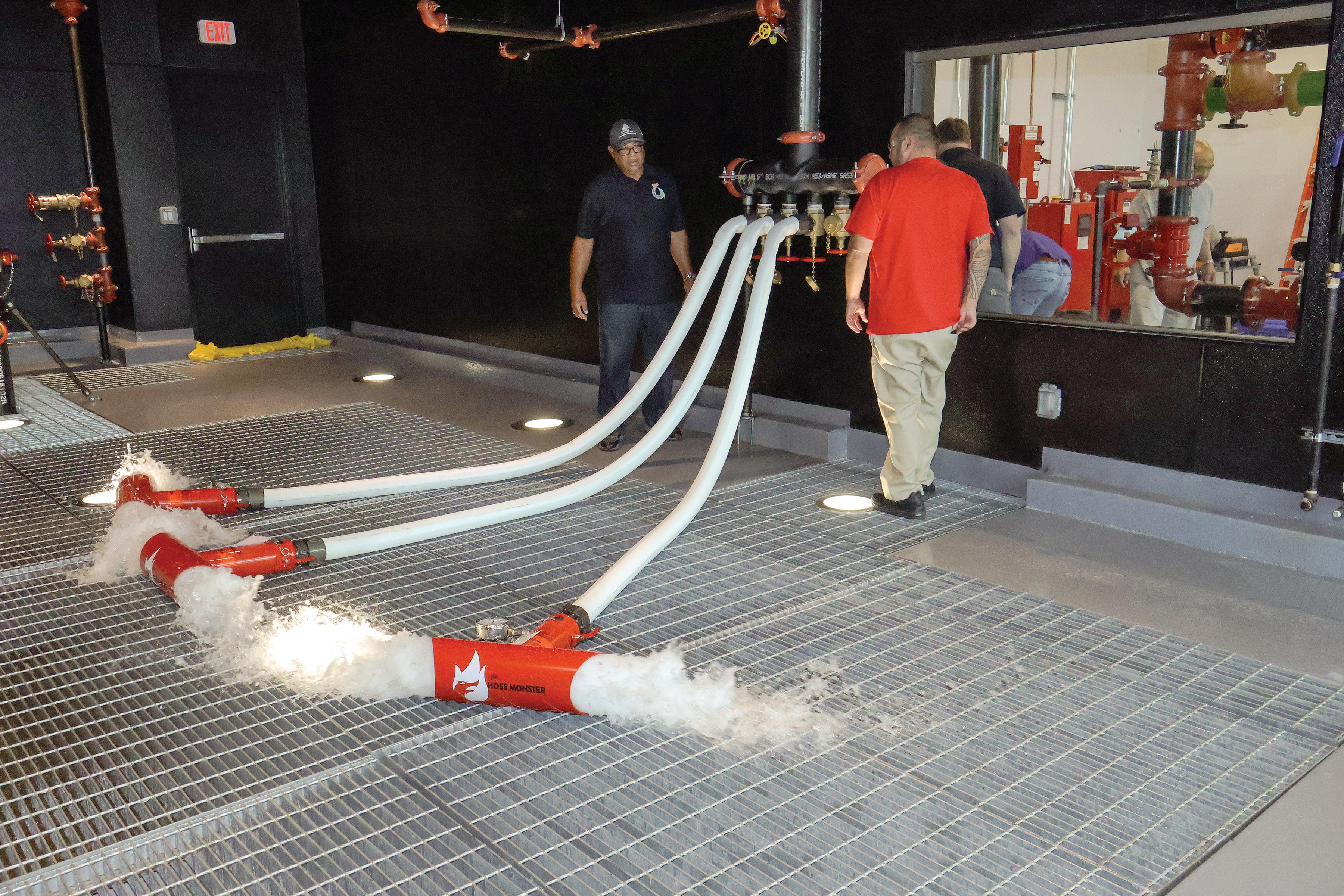
NFPA 25 Essentials Workshop
2 Days
Immersive training course, including hands-on demonstrations & interactive exercises designed for all experience levels of technicians, inspectors, AHJs and facilities maintenance personnel.
NFPA 25 Advanced Systems Workshop
3 Days
Take your skills to the next level with a focus on NFPA 25 ITM procedures for water supplies, standpipes, preaction and deluge systems, and specialized sprinkler systems.
NFPA 25 Fire Pump Workshop
2 Days
Develop ITM skills for fire pumps through hands-on practice, including no-flow and full-flow tests, and gain a deeper understanding of fire pump systems.
If you’re an ITM technician of any experience level, facility managers, AHJ, Designer, Fire Protection Engineer, sprinkler fitter, or a training manager whose responsibilities include inspection, testing, and maintenance of water-based fire protection systems, then these courses are for you.
INDUSTRY NEWS
WINSUPPLY ACQUIRES UNITED LIGHTING & SUPPLY CO.
Winsupply Inc. has acquired United Lighting & Supply Co. United Lighting & Supply (ULS), which operates four locations in Florida, specializes in the wholesale distribution of electrical apparatus, supplies, lighting, and major household appliances. From its main operation in Fort Walton Beach, Fla., ULS sells electrical products and hosts a lighting and appliance showroom. Its customers include those in residential, commercial, industrial, and government construction and maintenance markets.
Visit WinSupplyInc.com.
SERVICETRADE AND VIEWPOINT SPECTRUM INTEGRATE
ServiceTrade, Inc., a commercial field service management software provider tailored specifically for mechanical and fire protection contractors, expanded its integrations portfolio with a new seamless integration with Viewpoint Spectrum, a widely adopted web-based construction ERP solution. The integration enables contractors to connect ServiceTrade’s leading field service management platform with Spectrum’s comprehensive ERP system. It combines ServiceTrade field efficiency, customer communications, office coordination, and sales enablement workflows with Spectrum’s powerful accounting, payroll, project management, equipment tracking, inventory, and reporting tools. Visit ServiceTrade.com.
FPRF & FSRI ISSUE A JOINT NOTICE
The Fire Protection Research Foundation (FPRF), the research affiliate of NFPA, and The Fire Safety Research Institute (FSRI), part of UL Research Institutes, has issued a notice about a potential explosion hazard when fire blankets are used during electric vehicle fire suppression efforts with battery involvement. During experiments involving the use of electric vehicle fire blankets to suppress an EV fire with battery involvement, it was observed that the deployment of a fire blanket eliminated flaming by denying oxygen to the vehicle and the battery fire. While the flaming was eliminated, battery thermal runaway propagation continued after blanket deployment, which resulted in the continued release and accumulation of flam-
mable battery gases into the volume under the blanket. In some of the experiments, this accumulation of flammable gases under the blankets presented an explosion risk to firefighters operating near the vehicle. The risk of an explosion can be increased when re-introducing air into an oxygen-depleted accumulation of unburned flammable battery gases. View the report at NFPA.org.
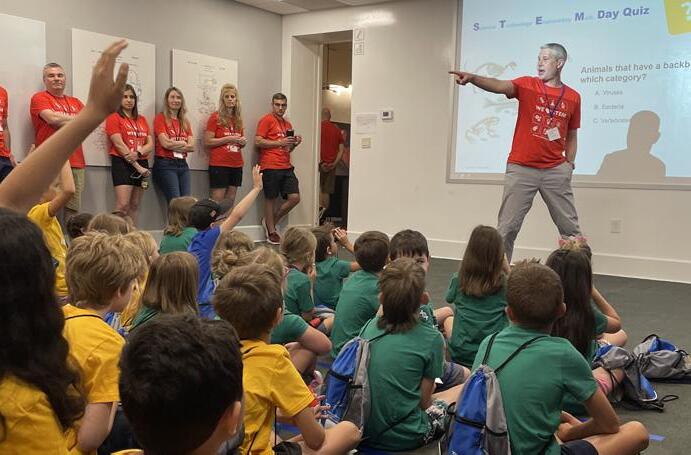
RIDGID® “WE LOVE STEM DAY”
RIDGID®, a part of Emerson’s professional tools portfolio, held its annual “We Love STEM Day” in June for 60 local students in kindergarten through eighth grade. The day-long event, held at RIDGID global headquarters in Elyria, Ohio, let students experience the real-world role science, technology, engineering, and mathematics (STEM) plays in manufacturing. Students participated in a variety of handson activities, including making straw airplanes, rubber band powered cars, electroscopes and mini speakers. Each activity allowed students to learn about the importance of mechanical engineering, electrical engineering, renewable energy and natural resources in manufacturing. Visit Emerson.com.
SFPE 2025 ANNUAL CONFERENCE & EXPO DETAILS
The Society of Fire Protection Engineers (SFPE) announces the opening of registration for the SFPE Annual Conference & Expo. Held at The Westin Bayshore in Vancouver, British Columbia, Canada, from October 21-23, the SFPE Conference & Expo is the place where fire protection engineers and fire safety professionals come together to learn, network, engage, and be inspired.
This year’s event holds special significance as SFPE celebrates its 75th anniversary. The conference will also recognize the 2025 recipi-
ents of the SFPE and SFPE Foundation Awards, honoring outstanding contributions in engineering innovation, education, research, and service to the profession.
The conference will feature 50-plus presentations structured around the topics of Building Design, Industrial Risks, WUI, Battery Fires, Human Behavior, Fire Safety Systems - Special Hazards Water Systems, Structural Fire Engineering, Emerging Technologies & Infrastructure, SFPE Foundation Research, Case Studies, Ai/Digitalization, and much more. The opening keynote will feature a presentation by Fire Chief & General Manager of City of Vancouver, Karen Fry. A panel discussion on Single Egress Design, poster presentations and sessions specifically curated on SFPE Foundation initiatives will also be featured. A total of 14.25 hours of professional development credits are available. Visit SFPE.org.
FIREDOS DZ1000 INRODUCED
With the new DZ1000 light, FireDos presents a proportioner that offers maximum flexibility for firefighting operations. The DZ1000 light can be installed in fire trucks or used as a portable system. Weighing only 25 kg and measuring the size of a standard Eurobox (35 cm high), it can be converted from the installed to the portable version in just one minute.
Key features of the DZ1000 light: Application range from 80 to 1000 l/min for extinguishing foam and wetting agent; precise proportioning rates: 0.1% (wetting agent), 0.5% and 1% (extinguishing foam); powerful alternative to Venturitype inductor proportioners. The system is suitable for a wide range of applications, from fighting forest fires to building fires and tanker fires. It can be easily integrated into new vehicles or used to retrofit existing fire engines. Visit FireDos.de.
NEW NFPA CAMPAIGN LAUNCHED
The National Fire Protection Association® (NFPA®) has launched A Code for Every Moment, one of the most significant public awareness campaigns in its more than 125-year history, to educate the public and policymakers about the life-saving role of independently developed safety codes and standards—and to defend a system now under threat.
From the wiring in our homes to the exits in our workplaces, safety codes keep everyday mo-
ments safe, but there’s a gap in public understanding that has left the system vulnerable—to complacency, misinformation, and special interests. To learn more about the campaign and how you can get involved, visit DontChanceSafety.org.
FIRE PREVENTION WEEK THEME
The National Fire Protection Association® (NFPA®)—the official sponsor of Fire Prevention Week™ for more than 100 years—has announced “Charge into Fire Safety™: Lithium-Ion Batteries in Your Home” as the theme for Fire Prevention Week, October 5-11, 2025. This year’s focus on lithium-ion batteries works to better educate the public about how to buy, charge, and dispose of them safely. Visit NFPA.org.
SFPE ENGINEERING SOLUTIONS SYMPOSIUM IN AUGUST
The Society of Fire Protection Engineers (SFPE) invites fire protection engineering professionals to the SFPE Engineering Solutions Symposium on Storage Fire Protection Challenges, August 12-14, 2025, in Chicago, Ill. Join SFPE for a technical symposium dedicated to addressing the evolving challenges of protecting modern storage facilities, including
warehouses, distribution centers, cold storage, and the integration of new storage materials and technologies.
SFPE’s technical symposia are structured to convene and educate engineers on emerging topics and challenges facing the fire protection profession. These programs are delivered by distinguished experts in the relevant field and the format maximizes the exchange of ideas among attendees and speakers through brief technical presentations followed by discussion periods with the audience. Visit sfpe.org/storagesymposium.
JOHNSON CONTROLS CONNECTED SPRINKLER SERVICE RELAUNCHED
Johnson Controls (NYSE: JCI) has relaunched its Connected Sprinkler service, which provides real-time insights and predictive maintenance to help save facility managers and building owners time and money. This service uses digitally enabled solutions, to enhance fire safety throughout the building lifecycle by providing data-driven maintenance information.
Designed to be hardware agnostic, Connected Sprinkler service integrates with any
existing sprinkler system and identifies data insights from indicators including water presence, temperature and pressure. Facility managers can proactively identify maintenance needs, and according to the Department of Energy’s Operations & Maintenance Best Practices Guide, reduce downtime up to 40% by shifting from reactive to predictive maintenance. Visit JohnsonControls.com.
CREATION OF SFPE CANADA
The Society of Fire Protection Engineers (SFPE) proudly announces the creation of SFPE Canada/Association des ingenieurs enprotection incendie Canada—a new regional division dedicated to expanding support, collaboration, and professional growth opportunities for fire protection engineers across Canada. SFPE Canada will operate similarly to SFPE Europe, focusing on advancing the practice of fire protection engineering, facilitating education and training, promoting the development and adoption of technical standards, and providing a forum for collaboration within the Canadian fire engineering community. Visit SFPE.org. n
The REPAIR PARTS Experts

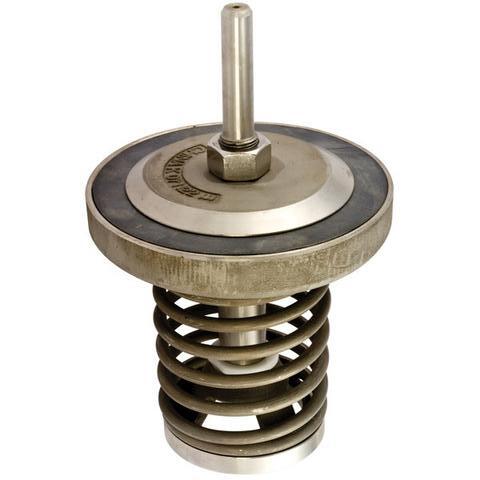
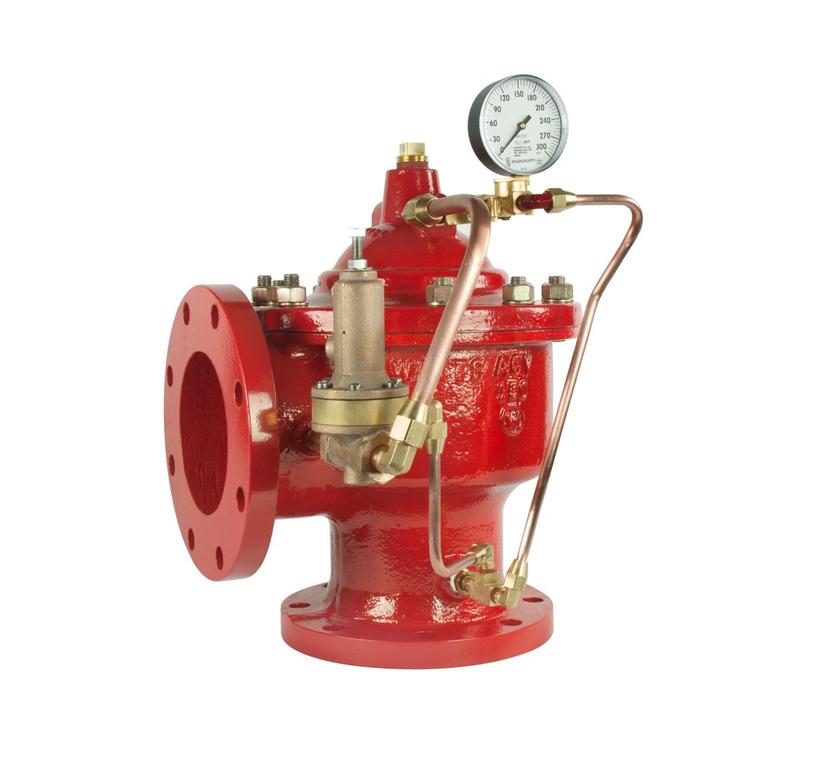
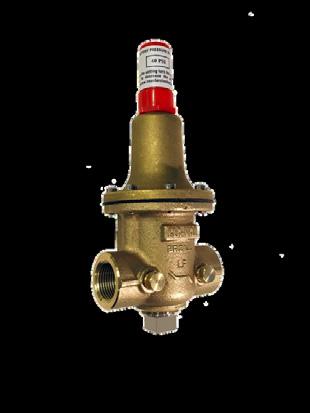

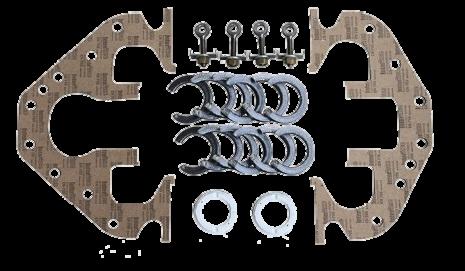
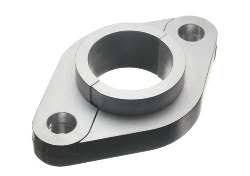
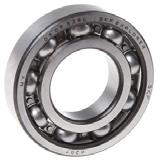
PRODUCT NEWS
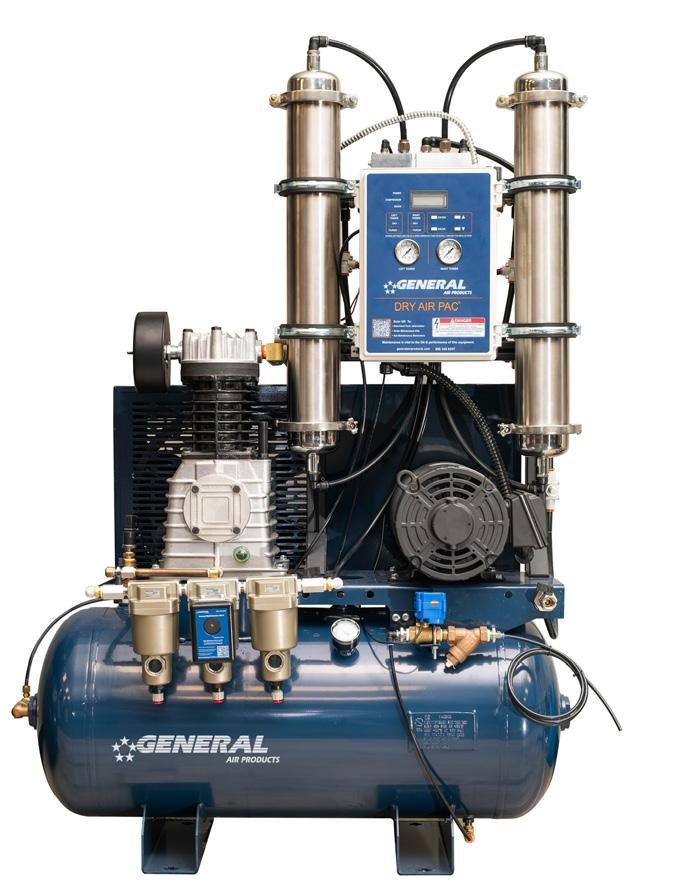
GENERAL AIR PRODUCTS DRY AIR PAC® NOW AVAILABLE
The Dry Air Pac® is getting an upgrade. For almost 30 years, General Air Products’ Dry Air Pac® has been the benchmark for cold storage and moisture-sensitive air supply solutions in the fire sprinkler industry. General Air Products is pleased to introduce the Dry Air Pac® Advance Series, a new and improved version of the equipment you’ve come to rely on in environments prone to moisture or temperature fluctuations. Engineered for durability, reliability, and performance in harsh conditions, the Dry Air Pac® Advance Series is built to combat the elements that cause costly ice plugs. Thanks to enhancements made by the General Air Products team, the Dry Air Pac® is now better than ever.
The Dry Air Pac® Advance Series includes prepackaged desiccant sleeves for easy installation and maintenance, an automatic drain valve with timer controls, push-connect fittings to make testing and inspection more convenient than ever before, updated oil less compressor options, and a digital control panel standard on every unit, among other new and improved features. General Air Products is proud to offer a piece of equipment that is both a workhorse and a powerhouse when it comes to dry pipe sprinkler systems. Visit generalairproducts.com.
ARMSTRONG INTRODUCES THE INTEGRATED DESIGNER
Armstrong Fluid Technology has introduced a powerful new capability within its ADEPT selection platform: the Integrated Designer. The
Integrated Designer simplifies the process of selecting and sizing pumps, accessories and more—all from a single interface. Designed to save time, and improve accuracy and energy efficiency, the tool enables the seamless creation of comprehensive equipment schedules and system layouts with pre-configured solutions. Using the supplied values for system flow and pressure, as well as flow redundancy and flow turn-down, the Integrated Designer recommends the optimum pump size plus the number of pumps and suggests alternative combinations. “This tool is a game-changer for mechanical engineers and system designers,” said Zeljko Terzic, global offering manager for pumps. Visit Armstrongfluidtechnology.com.
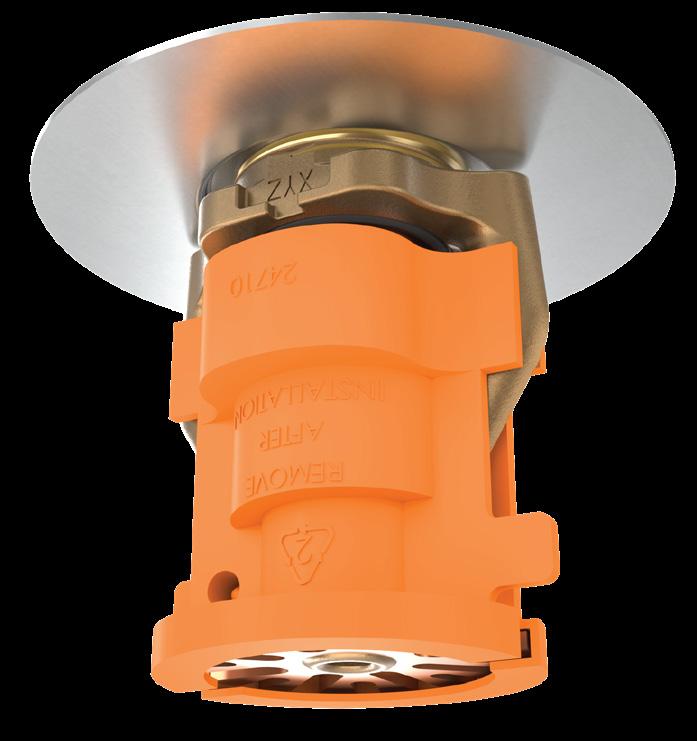
VIKING UNVEILS ELO AND ESFR SPRINKLER FAMILY
Viking Group, Inc., a Michigan-based manufacturer and distributor of fire protection solutions, is excited to announce over 20 sprinkler configurations in its brand-new FM Approved intermediate level in-rack storage family. Including both ELO and ESFR sprinklers, guards, watershields, and various installation tools, this new line of intermediate in-rack solutions ensures that customers can solve extensive storage obstacles in a world of growing automation and storage footprint expansion. In addition to the family’s broad FM Approval, the ESFR offering includes UL Listed options.
Applications such as automatic storage retrieval warehouses face unique challenges—contractors need to provide sufficient protection from difficult storage fires while simultaneously avoiding racking or container obstructions that could limit the sprinklers’ cover-
age. With the 20-plus sprinkler and accessory configurations in this new offering, including a new recessed wrench that simplifies the installation, and the ability to use InstaSeal® compatible features and tools, and newly added guard and watershield sizes, this complete solution offers flexibility and ease. Visit VikingGroupInc.com
JOHNSON CONTROLS LAUNCHES ANSUL® INERT GAS SYSTEM 300
Johnson Controls has announced the new ANSUL® Inert Gas System 300 (IGS-300), strengthening its position in the fire suppression category. Engineered for simplicity and designed for safety, the new ANSUL IGS-300 helps protect a diverse array of buildings with valuable or sensitive assets and provides several capabilities that align with market and customer expectations for performance, cost and lead time.
The ANSUL IGS-300 is suitable for a wide range of applications including control rooms, data centers, electrical switch rooms, financial institutions, museums, laboratories, medical facilities, petrochemical, oil and gas facilities, air traffic control towers, archives, mining centers, telecommunication sites, cultural and historic sites and e-houses.
The ANSUL IGS-300 utilizes clean agents INERGEN® or IG-55, coupled with enhanced regulated flow technology and simplified actuation, to effectively extinguish fires while minimizing turbulence during discharge. This helps protect the integrity of sensitive equipment and materials critical for business continuity. Visit JohnsonControls.com
NEW EFFICIENT SERVICETRADE INSPECTIONS
ServiceTrade, Inc. has announced ServiceTrade InspectionsTM. ServiceTrade Inspections is the only solution for fire inspection and compliance management that is fully integrated within a field service management platform. The expanded functionality streamlines every aspect of the inspection workflow through a single, mobile user interface, enabling greater efficiency, increased revenue, and superior customer service.
Fully integrated within ServiceTrade’s field service management platform, the new functionality consolidates essential inspection manage-
ment capabilities in a seamless experience that accelerates inspections and maximizes technician productivity. Rather than dealing with administrative paperwork, technicians can focus on performing inspections, testing, and maintenance work. ServiceTrade captures inspection data once and puts it to work everywhere—automating deficiency creation, updating asset information, and creating polished customer-ready reports in less time. Visit ServiceTrade.com.
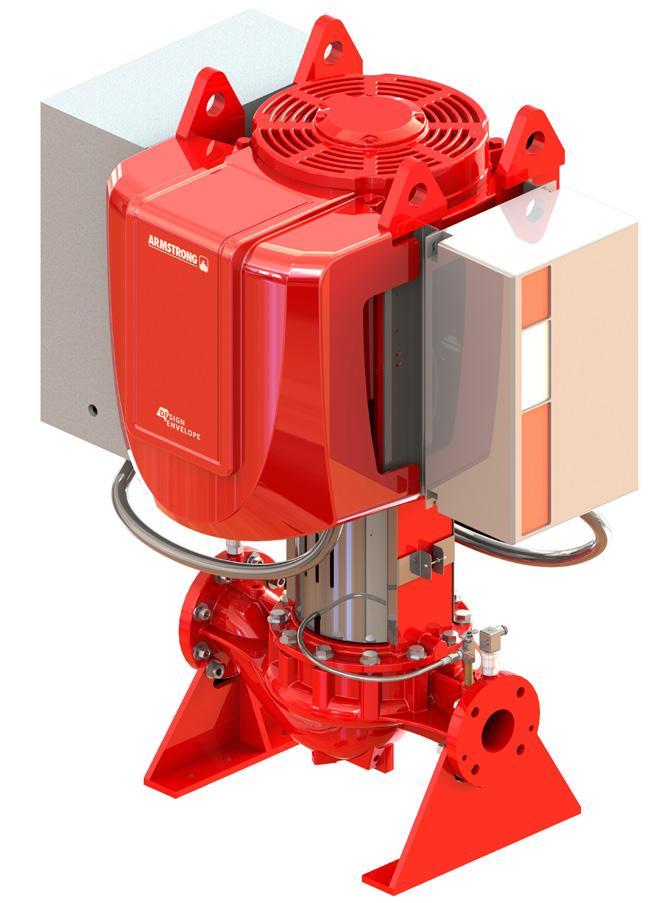
ARMSTRONG EXPANDS ITS RANGE OF VERTICAL-IN-LINE FIRE PUMPS
Armstrong Fluid Technology has expanded its family of vertical-in-line Fire Pumps with the addition of the new 750 gpm 5x4x10PF model. This new size is available with design envelope technology, featuring connected intelligence, performance tracking and automated alerts to support more cost-effective maintenance and better occupant safety. Due to the managed “ramp-up” of output, there are no pressure spikes on startup, pipes are better protected, water delivery is ensured and the risk of water hammer is reduced.
Other features include: reduced on-site work for power cabling, reduction of PRVs and drain lines, elimination of safety issues related to supply pressure, reduced costs for design engineers, contractors and building owners. Visit Armstrongfluidtechnology.com.
JOHNSON CONTROLS LAUNCHES SIMPLEX INCIDENT MANAGER
Johnson Controls has launched Simplex Incident Manager, a complete web-based fire alarm management workstation for campuses and large facilities. This next-generation workstation from Johnson Controls includes an advanced interface
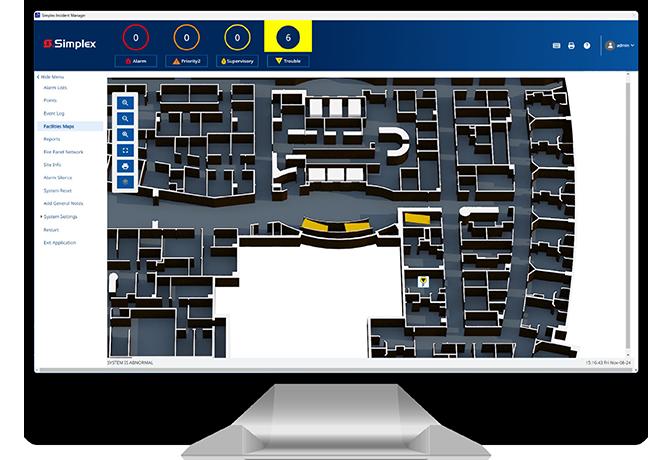
and feature set that enhances the fire alarm management experience, helping facility teams keep their buildings protected around the clock.
Simplex Incident Manager gives facility teams the power to monitor and manage their
fire alarm systems across multiple buildings from a central workstation. The web-based solution allows users to control and supervise up to 687 fire alarm control units and 250,000 devices from any HTML-5-capable device. Its scalability and power make it an ideal fire alarm system monitoring and control solution for standalone buildings or multi-site, networked facilities such as universities, hospitals, airports, high-rises, sports arenas and data centers. Visit JohnsonControls.com. n
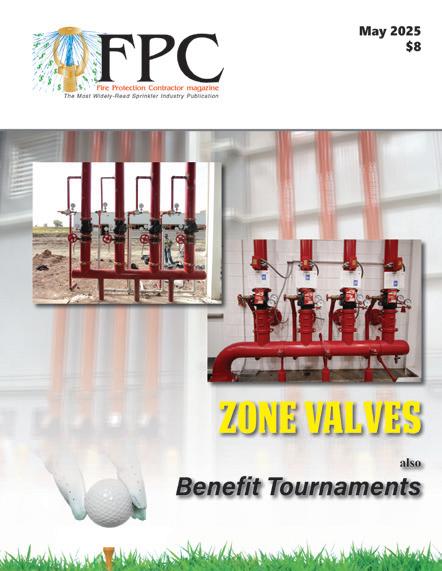
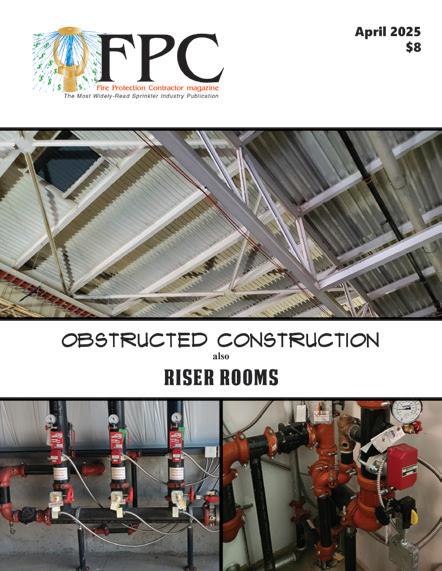
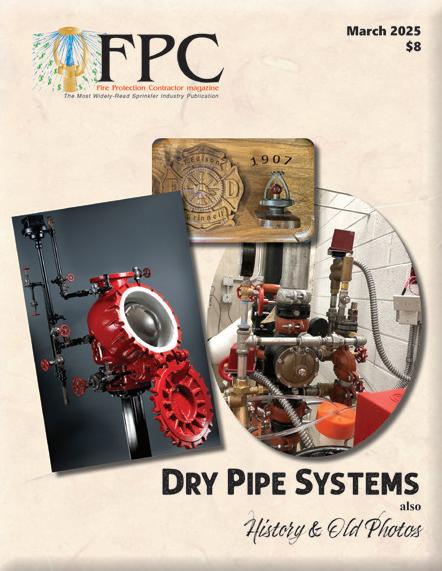
PEOPLE IN THE NEWS
AGF WELCOMES MCHUGH
AGF Manufacturing is proud to announce the appointment of George “Joe” McHugh as director of operations. This milestone marks the continuation of a proud family tradition, as he becomes the third generation of the McHugh family to help lead the company.

McHugh brings over a decade of operations and logistics leadership from Amazon, where he most recently served as a senior program manager for Amazon Logistics ACES. Throughout his 11-year tenure, he led large-scale process improvement initiatives, launched and optimized logistics delivery stations across North America, and implemented lean principles to enhance efficiency and performance.
At AGF Manufacturing, McHugh will oversee all operational aspects of the business, with a focus on streamlining processes, scaling production capabilities, and supporting continued growth in product innovation and customer service. Visit AGFMfg.com.
SANBORN JOINS BULL MOOSE
Daniel Sanborn has joined Bull Moose Tube Company as the regional sales manager working remote and assigned to the Chesterfield Support Center. He reports directly to Dave Weinrich, director of sprinkler sales.

Sanborn has over 15 years of experience in customer relationship management, territory development, and product sales within the fire protection, industrial, and oil and gas industries. He began as a sales estimator for Protect Controls, Inc. Gaining experience; he transitioned into product development and sales with Hahn Equipment Company, Inc. Most recently, he worked in the capacity of regional sales representative of Reliable Automatic Sprinkler Co. leading project negotiations and collaborating with both inside sales and management teams for favorable outcomes for all parties. Sanborn holds a Bachelor of Science in business administration from the University of Texas at Tyler with a focus in marketing. Visit BullMooseTube.com.
NIBCO PROMOTES FIGULY
NIBCO INC. has announced the promotion of Paul Figuly to director, wholesale sales-east. In his new role, Figuly will coordinate regional sales strategies, build internal partnerships with customers and work with the regional sales managers to improve sales growth.
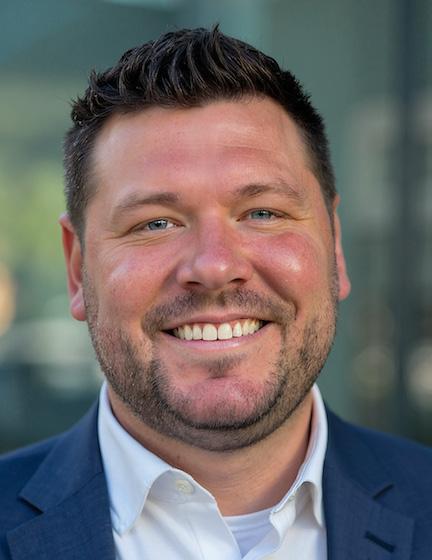
Figuly joined NIBCO in October 2015 as press sales manager and has held several positions, including assistant regional manager northeast and regional manager, Ohio Valley. He brings 23 years of experience to his new role. Figuly holds a Bachelor of Science in business administration from The University of Akron in Akron, Ohio. Visit NIBCO.com.
NFPA HONORS GLOBAL LEADERS
The National Fire Protection Association® (NFPA®) recognized outstanding achievements in fire, electrical, and life safety during the Stars at Night awards gala on June 15, at the NFPA Conference & Expo® in Las Vegas. In addition to the NFPA Committee Service Awards and Special Achievement Awards, NFPA presented the following honors during the evening celebration: Fire Protection Research Foundation Medal: Awarded to the international WUI-NITY 4 project team for developing and launching a cutting-edge wildfire evacuation modeling tool that bridges research and practice.
Harry C. Bigglestone Award: For excellence in the communication of fire protection research presented posthumously to Professors Howard R. Baum and James G. Quintiere for their landmark paper, The Emmons Problem Revisited. The award’s $5,000 prize was donated to the University of Maryland to support students in the Fire Protection Engineering Program.
2025 NFPA Fire and Life Safety Educator of the Year Award: Presented to Shawneri Guzman of Washington State for her creative, community-driven education programs and outstanding use of NFPA public education materials.
2025 NFPA Electrical Inspector of the Year Award: Presented to Robert Fahey of Wisconsin for his decades of leadership, training, and service to electrical inspection and safety.
2025 NFPA Fire Marshal of the Year Award: Presented to Chief Tommy Demopoulos of Tamarac Fire Rescue in Florida for his transformative, education-first approach to code enforcement and his collaborative work with local businesses.
2025 NFPA Distinguished Service Award: Presented to Shmuel Netanel of Israel for his decades of leadership, engineering innovation, and successful advancement of NFPA codes and standards throughout the Middle East.
2025 James M. Shannon Advocacy Medal: Awarded to Amy Acton for her tireless efforts on behalf of burn survivors and her leadership in advancing public fire and life safety policies nationwide.
2025 Standards Medal: Presented to Marcelo Hirschler, Ph.D., in recognition of a career defined by technical excellence, consensus-building, and decades of volunteer leadership in the NFPA standards development process.
2025 Richard G. Biermann Award: Awarded to Donald R. Cook for his dedicated volunteer service to NFPA and his influential leadership in the advancement and implementation of the National Electrical Code® (NEC®).
2025 NFPA Fire & Life Safety Ecosystem Global Influencer Award: Presented to the Abu Dhabi Civil Defense Authority for its system-wide commitment to fire and life safety, resulting in measurable improvements in public safety across the United Arab Emirates. Visit nfpa.org. n

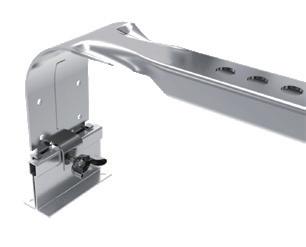
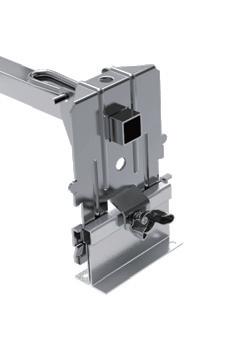
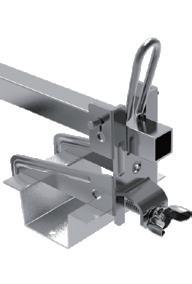
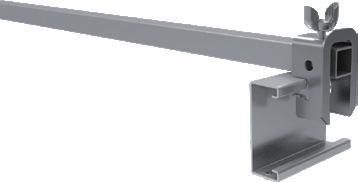
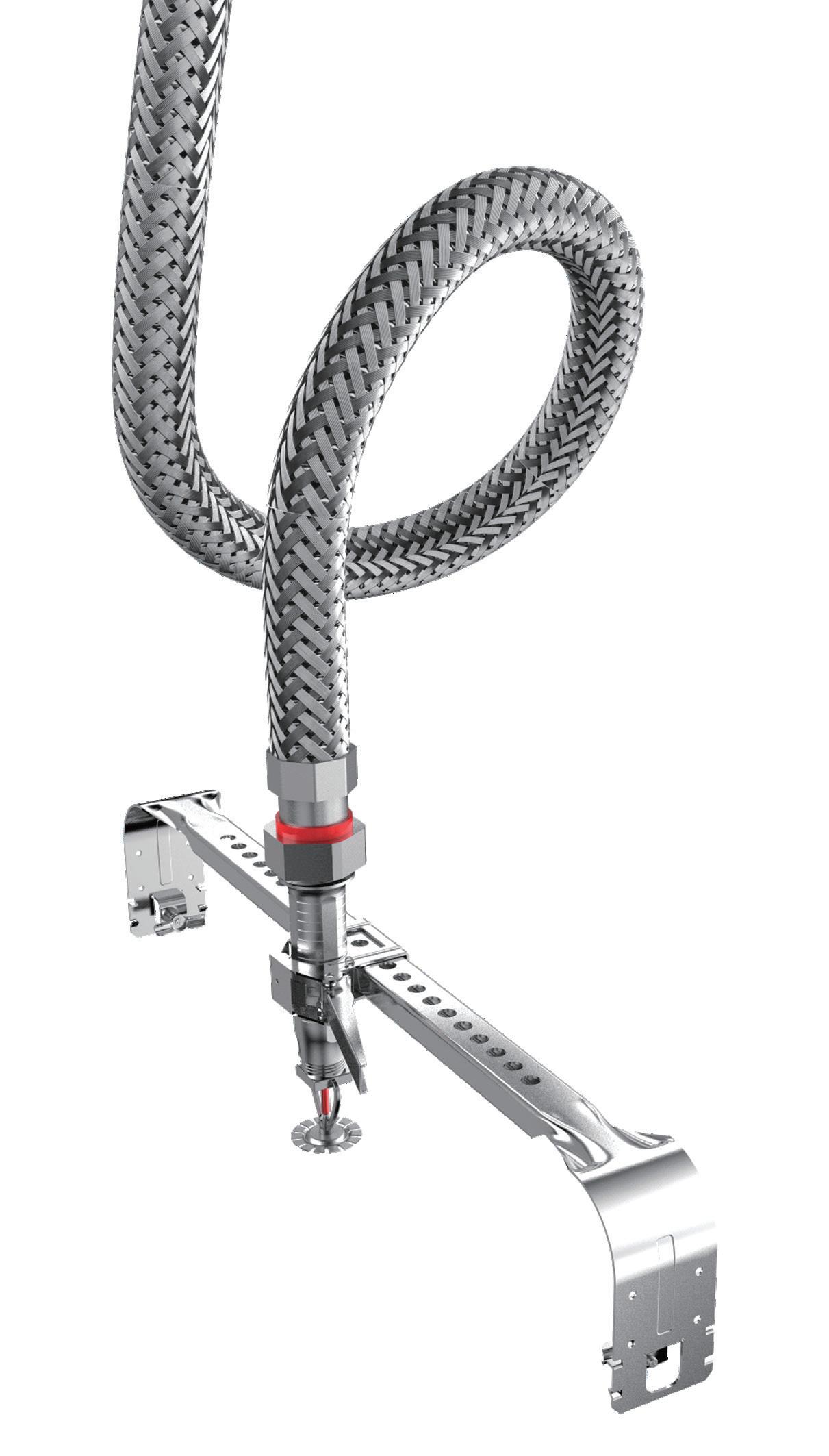




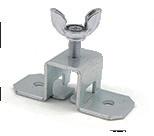
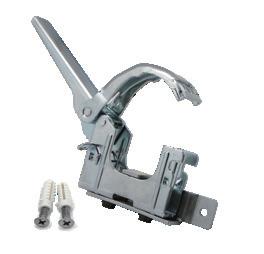
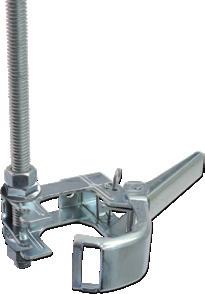

Experience
